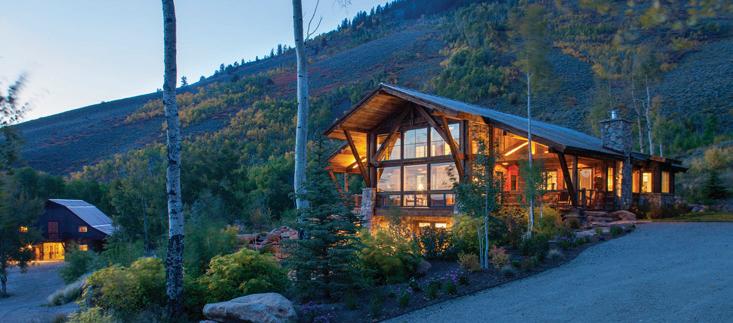

 The Lasting Appeal Of Federal Architecture Adding a Cozy Touch With Bouclé and Sherpa
Exploring the Unexplored In Antarctica
Four Ways to Find Inner Peace
AND LAND
The Lasting Appeal Of Federal Architecture Adding a Cozy Touch With Bouclé and Sherpa
Exploring the Unexplored In Antarctica
Four Ways to Find Inner Peace
AND LAND




 The Lasting Appeal Of Federal Architecture Adding a Cozy Touch With Bouclé and Sherpa
Exploring the Unexplored In Antarctica
Four Ways to Find Inner Peace
AND LAND
The Lasting Appeal Of Federal Architecture Adding a Cozy Touch With Bouclé and Sherpa
Exploring the Unexplored In Antarctica
Four Ways to Find Inner Peace
AND LAND

Nothing feels like this — but this. Grass, trees, sun, sky, freedom. No texts, no timelines. Just you. And your people. And a connection to something bigger than all of it.

8 FEDERAL ARCHITECTURE
NEVER GOES OUT OF STYLE
This classic style emphasizes the art of understatement
This enduring style is all about atmosphere and a collected look

Bouclé and sherpa add that warm and cozy feel to any room
From kettlebells to skulls to a Zorro figurine and more, here’s what the actor cherishes
Massachusetts-based Merida is “part innovation lab and part atelier”
Entrepreneur Martin Pietri has craftsmanship in his DNA
The steps in your home—often the first thing you’ll see inside— can create a design moment
A connected home offers convenience, luxury, and safety in one
These gadgets will make almost anyone more of a morning person
After a career in finance, Jennifer Chamandi is taking luxury shoes to new heights
Popular with both men and women, these timeless classics are more than a mere accessory
48 WRIST ART
Artists infuse watches with imagination and color
50 LUXURY GOES GREEN
A guide to upscale plug-in hybrid SUVs
12 EXPLORING ANTARCTICA
Luxe tour operators are venturing to the coldest, most unexplored part of the world
44 AUCKLAND’S HERNE BAY IS HARD TO BEAT The most exclusive New Zealand suburb offers iconic estates
6 WHAT’S NEW IN ART, ARCHITECTURE, AND DESIGN
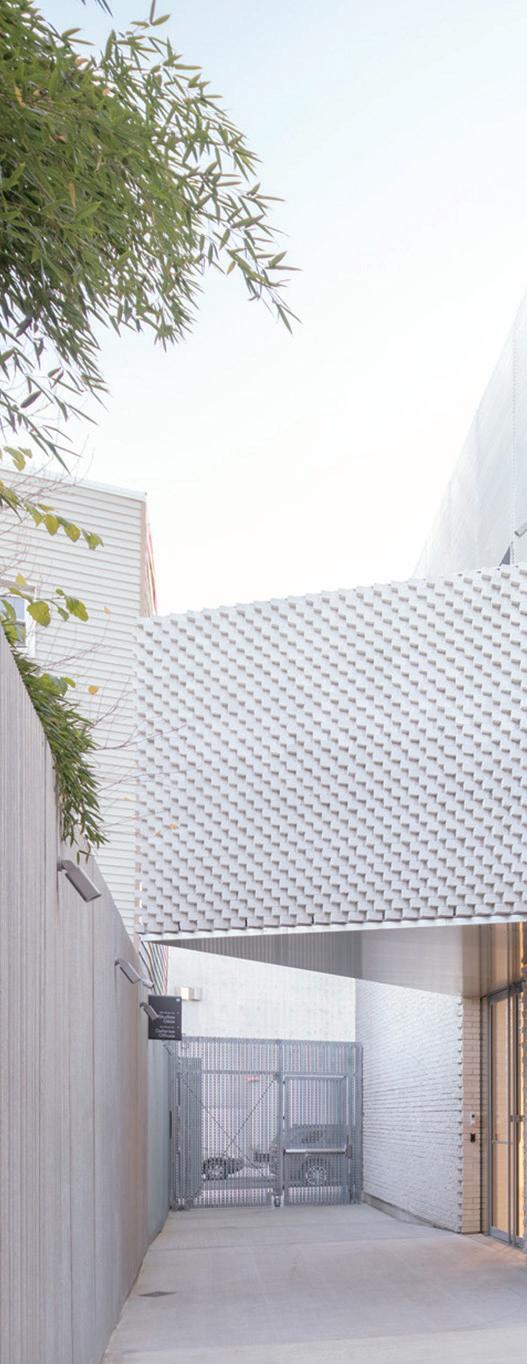
The growing popularity of artwork from contemporary African artists; sculptural aquariums; and fluting in interior design
26 CALL THE CONCIERGE Concierge services create oneof-a-kind experiences—and they’re getting more luxe
32 AN ARCHITECTURAL DUO THAT’S ‘LOCALLY ROOTED AND NATIONLESS’ The founders of SO-IL talk about starting a firm during a downturn and what’s in store
46 FIRST EVER NFT MUSEUM IS OPEN FOR EXPLORATION Visitors can view digital art and gather with others in the blockchain community
60 LUXURY BOARD GAMES
Upgrade your free time with these high-end sets
62 GRAPHIC NOVELS WORTH SEEKING OUT Illustrator and cartoonist Peter Kuper on his top picks
How to mix your favorite cocktails at home
From classic desserts to savory inventions, these dishes are worthy of a trip
54 FOUR WAYS TO FIND INNER PEACE
Yoga and meditation teacher Sara Clark on ways to destress
56 GLOW UP
These oils lock in moisture and give your skin dewy, glowing hydration
65 THE FINEST AGENTS AND PROPERTIES IN NORTH TEXAS
88 CEO ROBBIE BRIGGS TRADES HIS HOUSE FOR A HIGH RISE



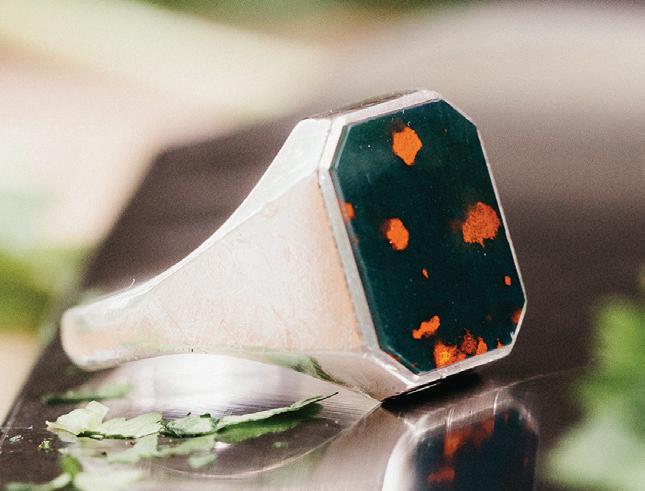


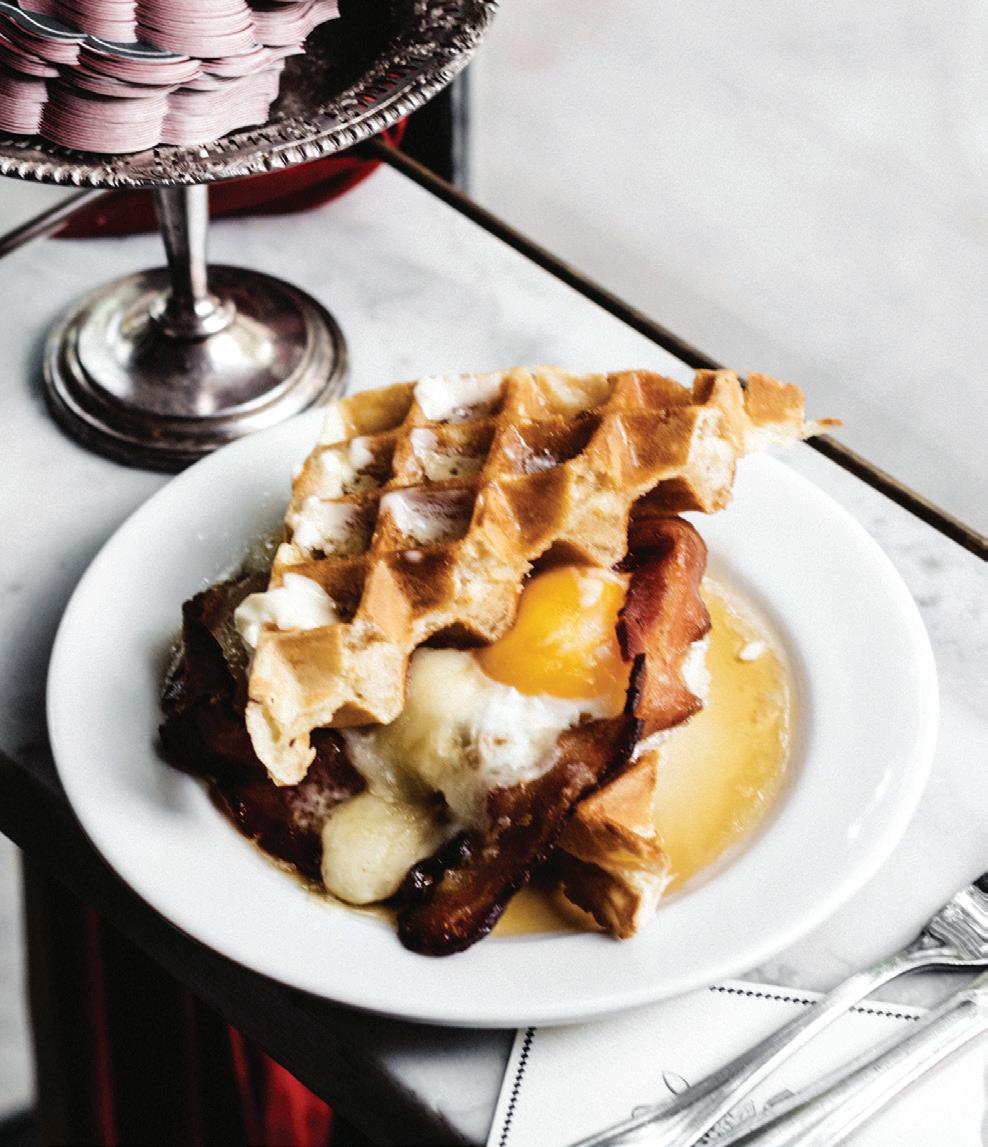
 PHOTO BY PAUL VAN COTTHEM ON UNSPLASH
PHOTO BY PAUL VAN COTTHEM ON UNSPLASH
On the cover: 9851 Rockbrook Drive in Dallas is an ode to the architecture of Spain’s Andalusian region, including patterned tiles and latticed stone screens. Its many luxuries include a library, a morning room, a pool, a wisteria-wrapped arbor, a wood- re oven, and a guest suite with a kitchenette.
Visit page 66 to learn more about this property.

The word is officially out about North Texas. Demographers now project that the unique region of Dallas, Fort Worth, and all the cities and towns in between and beyond will reach 10 million people sometime in the 2030s.
That means North Texas will surpass Chicago to become America’s third-largest metro area. Only New York and Los Angeles will be larger.
That is big. What’s more, the North Texas economy has grown markedly faster than those others. Our metroplex is now home to 24 Fortune 500 company headquarters, and we boast the fi fth-largest labor pool for tech talent in North America. North Texas has also become America’s third-largest fi nancial center. Coincidentally or not, DFW International Airport is the second-busiest airport in the world for passengers, with almost 2,000 departures and arrivals a day. Did you know that we now have a more youthful population than most metropolitan areas? (Our median age is 35.1, compared with a national metro average of 38.5.) Even better, Texas’ cost of living is about 6% below the national average.
There is nowhere like North Texas. We happen to know about 400 expert agents who love this place like nobody’s business—and they can help you with anything you can imagine, from a high-rise haven above the city to a getaway ranch that you could drive to in 90 minutes.
Another thing to know: The real estate market continues to change, around the country, and here. It is normalizing after a sustained frenzy—and that is why you need the guidance of a professional agent more than ever. Ours know how to navigate markets that are hot, cool, and everything in between.

 ROBBIE BRIGGS CEO Briggs Freeman
ROBBIE BRIGGS CEO Briggs Freeman


Sotheby’s International Realty rbriggs@briggsfreeman.com
 RUSS ANDERSON President Briggs Freeman Sotheby’s International Realty randerson@briggsfreeman.com
RUSS ANDERSON President Briggs Freeman Sotheby’s International Realty randerson@briggsfreeman.com


 Clockwise, from top: Renderings by RedFin Aquarium Design; Dominic Martin; Douglas Friedman
Clockwise, from top: Renderings by RedFin Aquarium Design; Dominic Martin; Douglas Friedman
Sculptural and high-tech, large-scale aquariums are the latest architectural amenity in luxury abodes around the world.
Designed to merge indoor and outdoor spaces via a relax ing water element, in many cases they are not merely part of the room, but also serve as key recreational spaces in the residence.
“Advances in filtration and lighting technology mean you can accurately recreate underwater environments, from the Amazon River to a coral reef, in your home,” says James Bruce, managing director of RedFin Aquarium Design, which has offices in Dubai, Hong Kong, and the U.K. “Using mate rials such as acrylic means they can be built on a large scale and more safely than glass. It also avoids the green tint seen in glass examples.”
Clockwise, from top:
RedFin Aquarium Design’s curved aquarium for a Dubai penthouse; Beatrice Wanjiku’s Aches of Ceaseless Divining; Chad Dorsey Design’s fluted fireplace.
Collectors are snapping up works by contemporary African artists, sculptural aquariums are the latest architectural amenity, and fluting is bringing depth to interior design.
Here are the latest trends in art, architecture, and design.
Works by contemporary African artists such as Beatrice Wanjiku are gaining international attention, as collectors, auction houses, galleries, and arts institutions turn their areas of concentration to that continent.
In her paintings and drawings, Wanjiku, who lives and works in Nairobi, Kenya, where she is a key player in the art scene, focuses on the human form, primarily the head and torso.
“The work is figurative and abstracted,” she says. “I abstract the figure so as not to contain it. I look at the human form as a vessel limited in its nature, but when abstracted it is free to move unencumbered beyond its frame.”
Wanjiku was listed among the Top 10 “artists to watch out for” at New York’s 1-54, the international art fair dedicated to contemporary art from Africa and its diaspora, and her works are in the Sina Jina Collection owned by Robert Devereux and the collection of the World Bank in Washington, D.C.
Her introspective images, raw and stripped to the bone, invite the viewer to gaze inward in a bid to explore the defini tion of being human.
“The figure I portray is neither male nor female,” she says. “Though executed from a female gaze, it’s a reflection of how I navigate the world that is predominantly patriarchal. It’s an exploration of a shared world—the feminine and the mascu line world—and how I navigate and negotiate in this space, therefore rendering the world amorphous.”
These uber-aquariums, which generally are stocked with high-priced farmed fishes that are bred for unusual colors and shapes, are run by computer-controlled systems that do everything from adjusting the color of the LED lights to feeding the fish on a regular schedule.
RedFin Aquarium Design, which is known for over-the-top projects, is building a curved acrylic aquarium for a Dubai penthouse that wraps around the room and has arches and circular seats cut through its walls.
“It will be one of the largest home reef aquariums in the world,” Bruce says, “and as far as we know, the first of this unusual, curved-wall design.”
Bruce notes that aquariums bring in a relaxation factor. “You can stare at them for hours, and there always seems to be some new interaction from the occupants.”
To create detail and depth in interiors, designers are embrac ing gorgeous grooves that display an intricate interplay between shadows and light.
These fluted elements, which range from the doors of kitchen cabinetry to the mantels of fireplaces, represent “a nat ural step away from the more minimalist architecture and inte riors we have seen over the past decade,” says interior designer Chad Dorsey, whose namesake studio is based in Dallas.
Fluting, which is executed in a variety of materials, includ ing glass, stone, and wood, is an ancient technique that is showing up in virtually every room of the house.
In a San Francisco residence, for instance, Dorsey designed a fluted marble fireplace for the listening room and a coordinat ing, fluted floating vanity in an adjacent bathroom. “It’s a fan favorite,” he says. “We have received many inquiries about it.”
A LOOK AT THE GROWING POPULARITY OF ARTWORK FROM CONTEMPORARY AFRICAN ARTISTS, SCULPTURAL AQUARIUMS, AND FLUTING IN INTERIOR DESIGN
Timeless, versatile, and possessed of an austere elegance, Federal architecture is America’s national style.
From the White House to George Washing ton’s Mount Vernon, and from Thomas Jefferson’s Monticello to the classical government buildings and domed statehouses throughout the country, Federal architecture, which arose in the 1780s around the time the American Revolution ended, has never gone out of style.
Also called Adamesque or Regency architecture, it was the prime style in the newly liberated colonies until about 1830. Based on the works of Andrea Palladio, the groundbreaking Italian Renaissance architect who espoused the principles of Roman and Greek architecture, it remained in vogue in Britain during the same time period.
Characterized by plain surfaces and sublime symmetry, Federal-style buildings typically are square or rectangular in shape and feature large Palladian or Serliana windows. Two to three stories high and two rooms deep, with the exterior decoration concentrated around the front entrance, the style emphasizes the art of the understated.
In addition to geometrical decorations, such as fan, circular and elliptical motifs, Federal-style houses sometimes feature dormers, gables, cupolas, and multiple chimneys.

The building materials—clapboard, stone, cedar shingles, or brick—vary by geographical location.
“There are lots of ways to interpolate the style,” says archi tect Patrick Ahearn, whose eponymous firm, based in Boston, has built several Federal residences. “Although it started in New England, as the country grew, the style was transplanted to new places and carried across the country.”
A Regency-style house in the U.K.’s Hampshire, designed by ADAM Architecture.
ADAM Architecture/Photograph by Paul Highnam
Steve Klein, a certified residential specialist with Bluegrass Sotheby’s International Realty, says the Federal style fits in perfectly with the traditional designs of housing in Lexington and Central Kentucky. “The symmetry and predominant use of brick are a standard across the market,” he says. “The longevity of the design also keeps them in favor to buyers.”
Ahearn notes that as time went on, the style morphed and began incorporating elements from other, newer styles, creating hybrids.
“Today, it appeals to a wide audience,” he says. “We don’t, of course, build houses to be museums. We use the Federal style on the exterior and organize rooms around a spine, either from front to back or from left to right, to create an overall conservative theme. But we include indoor and outdoor spaces and porches and pergolas to fit a contem porary lifestyle.”
Stephen Chrisman, a partner with New York–based Ferguson & Shamamian Architects, says clients choose to build traditional new houses in the Federal style when it fits in with the community’s existing architecture.
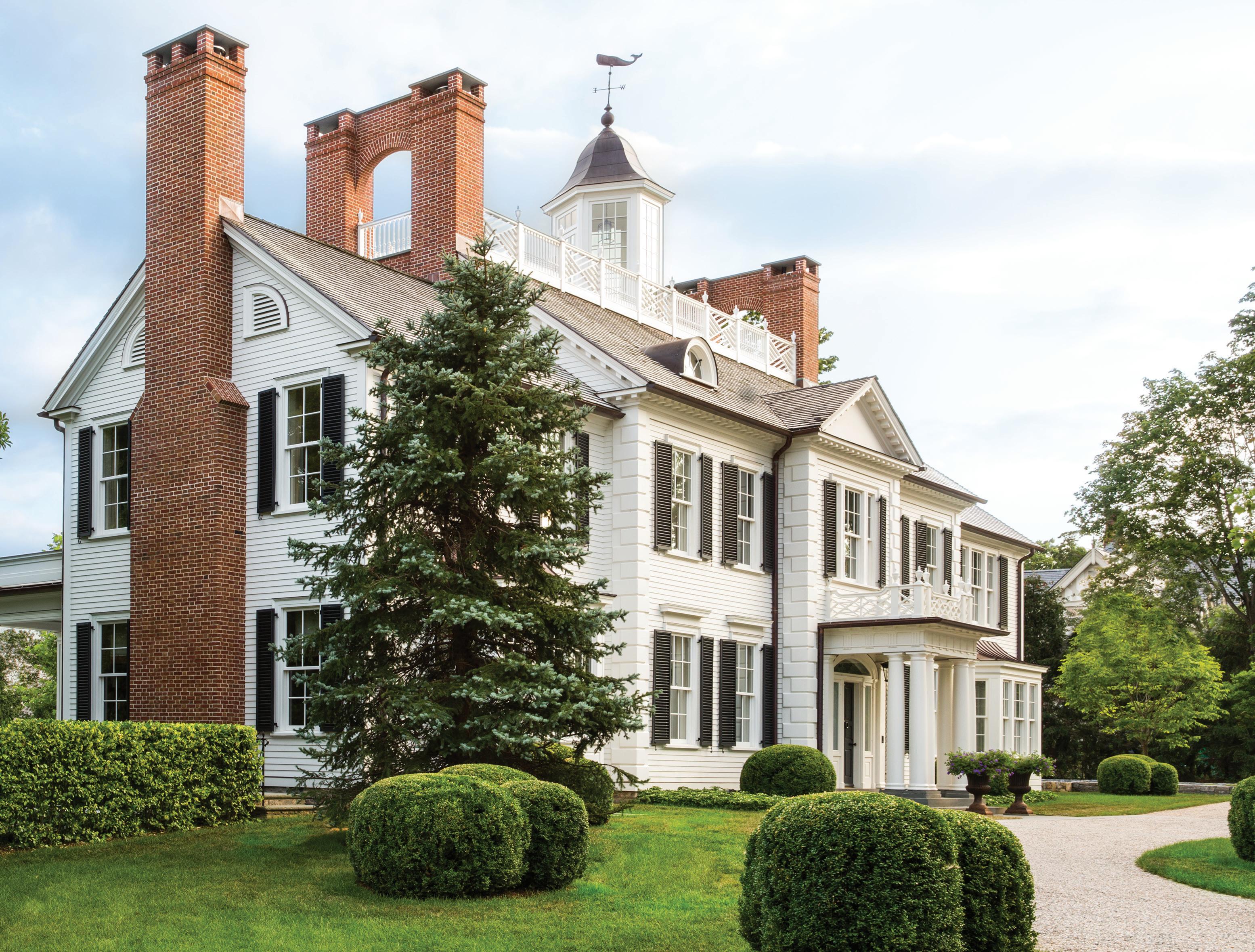
Although the layout—a center hall with rooms that open
A living room with custom wood fireplace in a Federal-style house designed by Ferguson & Shamamian Architects, shown above; a new Federal-style house by Ferguson & Shamamian Architects, shown below.
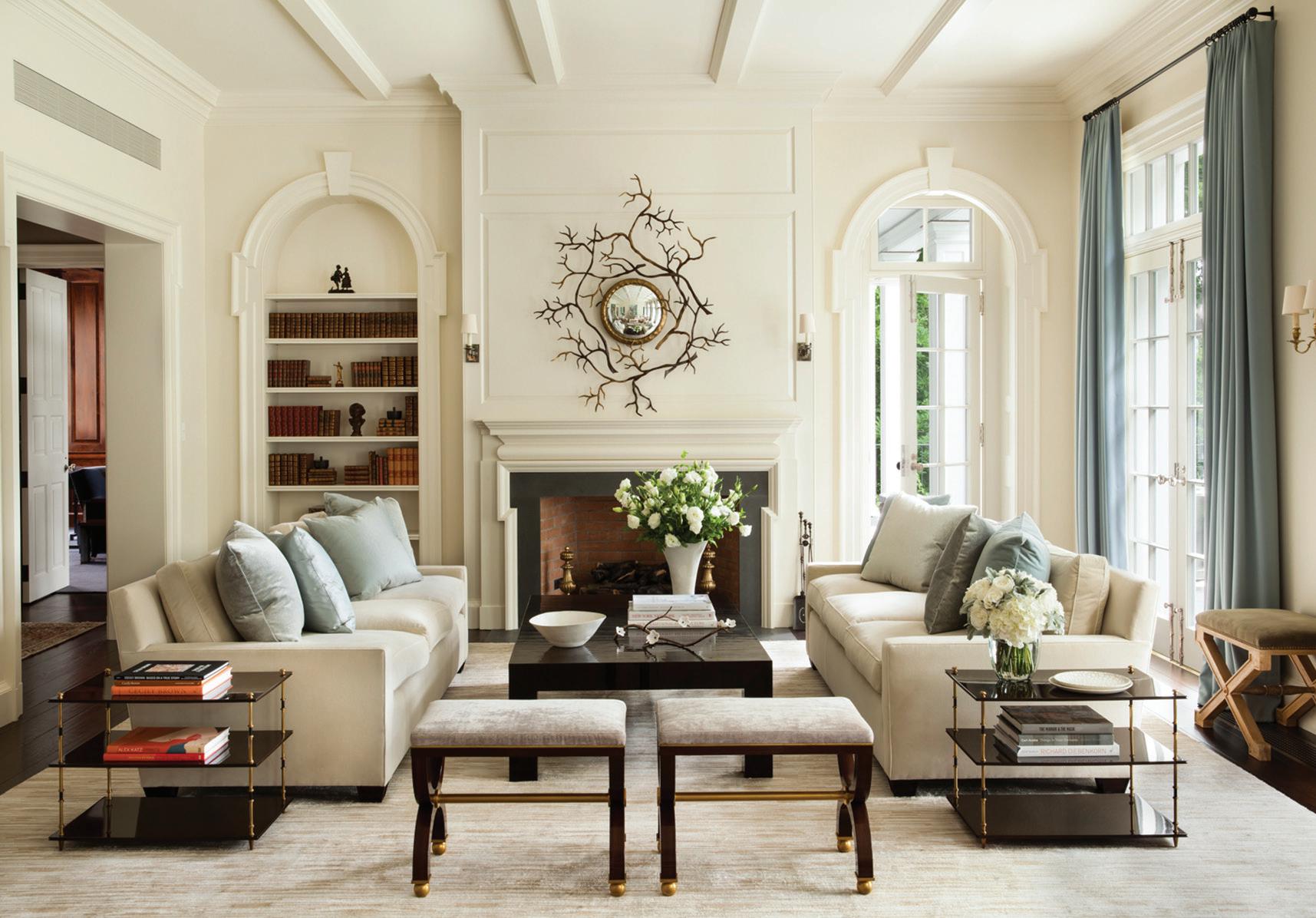
on each side of it—and architectural character aren’t modified, the functions of the rooms are altered in order to accommodate the needs of 21st-century residents.
“When the style was introduced, kitchens were small and closed off at the back of the house or in the basement,” he says. “People today want a more open plan that sites the kitchen close to the family room and dining room.”

He adds that wings, either on the back or on each side of the residence, are sometimes added to house these rooms, making the house look as though it evolved over time.
For a client in Greenwich, Connecti cut’s chic Belle Haven neighborhood, Ferguson & Shamamian designed a white clapboard Federal-style house that’s a symphony in symmetry.

Its simple facade is defined by a gabled main block, a projecting center
bay window, wood quoins on the cor ners that emulate stone, a cupola, end chimneys with see-through arches, and a widow’s walk that has a Chippendalestyle railing. There also is a wing on each side and a long projecting one on the back that houses the kitchen and family room, which open to a terrace and garden. “From the street, it looks like an old house,” he says, “because it fits so well into the neighborhood.”
The Federal style is equally at home in the U.K., where it reigns as Regency.
George Saumarez Smith, direc tor of ADAM Architecture, based in Hampshire, England, says the style is eminently adaptable because “many of its themes, such as bringing plenty of natural light into rooms, forming a strong connection with gardens and landscapes, and the strong use of color, seem to have a resonance with the modern world.”
A functional pantry/bar room in a Federal-style house designed by Ferguson & Shamamian Architects, shown at left. A red-brick Federal-style home in Lexington, Ky., shown below, is more than 8,000 square feet.
And, he adds, the elegant, ample rooms and high ceilings remain desir able features nearly 250 years later.
“We try to make the ceiling heights and well-proportioned rooms as generous as possible, and we often put a kitchen and family room in the best position in the house, whereas earlier houses would have put the drawing room and dining room in the best position,” he says. “And our houses incorporate the latest technology, much of which these days is wireless and invisible so that it does not detract from the architecture.”
Saumarez Smith, who built a com pact villa in the Regency style in rural New Hampshire, which the owners fur nished with antique and Mid-Century Modern furniture and decorated with bold color on the walls, says the style is particularly appropriate for residences in the countryside: “The architects of the Regency period understood that the soft colors of natural stone and lime render tended to work better in natural surroundings than visually harsher materials like red brick.”
Opposite page, from top: Photograph by Lisa Romerin ; this page, from top: Photograph by Thomas Loof; Photograph by Jeff Walker
AN INCREASING NUMBER OF LUXE TOUR OPERATORS ARE VENTURING TO THE COLDEST, MOST UNEXPLORED PART OF THE






No destination evokes such mystery as Antarctica, by far the least visited of the planet’s continents. Nearly twice the size of Australia, the “white continent” remains largely untouched, with almost no attractions or visitor services to speak of. This explains why visitors must enlist the aid of an established tour operator, and given the proliferation of ships (and planes) venturing across the Antarctic Circle and through the Southern Ocean, there are more choices than ever.
These companies stand out from the competition by providing first-time visitors with a next-level experience, complete with the kinds of access and extras rarely made available in the past. Some make it as easy as can be, providing all the arctic gear and helpful insight one needs to explore the coldest place on Earth.


When it comes to luxury access, no operator pulls out the stops like White Desert. Established in 2005 by worldrecord holding, husband-and-wife polar
explorers Patrick and Robyn Woodhead, the venture was born out of a desire to allow people other than scientists and explorers to see the wonders of the continent’s interior.
As the only company offering travel to Antarctica by private jet—guests fly directly from Cape Town, landing on the operator’s unique blue-ice runway—the majority of White Desert’s itineraries are unique. (The operating season typically runs from November through February.)


There are three adventure camps, the newest of which (Echo) opened earlier this year; each provides comfy sleeping pods, cozy communal spaces, and oncein-a-lifetime activities.
The camps, each of which holds up to 12 guests, offer intimacy and privacy. Multigenerational groups can opt for exclusive use of a camp, allowing families to bond while sharing gourmet meals, sipping cocktails made with 10,000-year-old ice, and relaxing in saunas with glacier views.
Ever mindful of the climate issues facing the continent, White Desert— which has been carbon neutral since
White Desert pulls out all the luxury stops when it comes to its exploratory trips to the “white continent,” shown at left and above.
2007—is the first operator in Antarctica to make use of Sustainable Aviation Fuel (SAF). Furthermore, it shares its aircraft with scientists, delivering them to their research bases more efficiently and with less environmental impact.
The majority of visitors experience Antarctica via an expedition ship, most of which have evolved and modernized in order to satisfy the modern adventurer.


The French cruise operator Ponant introduced its Le Commandant Charcot craft in 2021. After spending its maiden season in Antarctica, the vessel—the world’s only luxury icebreaker powered by liquefied natural gas—headed to the Arctic for the summer, when it became the first upscale passenger ship to reach the true geographic North Pole.
Le Commandant makes use of an environmentally friendly hybridpropulsion system to reduce its foot print, and there’s a research lab on board for studying the polar environ ments it traverses. Creature comforts include cuisine from Alain Ducasse, free-flowing Veuve Clicquot, an indoor
swimming pool, and heated lagoonstyle baths. The vessel carries up to 245 guests to parts of Antarctica that most other ships can’t reach, including the Charcot and Peter I islands, and the ice-covered Amundsen Sea, a remote region that remains mostly unexplored.
Building on almost 130 years of Norwegian pioneering heritage, Hurtigruten is the world’s largest expedition-cruise company. Having operated in Antarctica for 20 years, Hurtigruten Expeditions was the first cruise liner to introduce science centers onboard, staffed by an expert-led expedition team with guest lecturers/ scientists. When not engaging with nature through shore landings, kayaking excursions, and expedition adventures, passengers can participate in Citizen Science research projects for third-party organizations.
In 2019, Hurtigruten debuted the MS Roald Amundsen, the world’s first battery hybrid-powered cruise ship. Environmentally conscious adventures can explore Antarctica aboard the stateof-the-art vessel, which features new
Clockwise, from top: White Desert is the only operator offering private-jet service to Antarctica; an up-close view of penguins with Abercrombie & Kent; Silversea Cruises has three ships in Antarctica, and offers options ranging from 10 to 28 days.
and environmentally sustainable hybrid technology to reduce fuel consumption.
Travelers with a hankering for adventure are wise to consider Aurora Expeditions, which has been delighting thrill-seekers in Antarctica since 1991. There’s a focus on immersive experi ences such as trekking, camping, scuba diving, sea kayaking, cross-country skiing, snowshoeing, and climbing.
The 100% climate neutral operator takes small groups (average of 132 passengers) on intimate expeditions varying in length from 9 to 26 days; fewer people means these expedi tions are able to make more landings than the competition, with greater flexibility if tides, currents, ice, or weather dictate a schedule change. Travelers are accompanied by seasoned expedition specialists, including remote-area specialists, professional photographers, and scientists who host lectures.

Silversea Cruises, which has three ships in Antarctica, offers nearly 50 sailing options ranging from 10 to 28 days. All-inclusive packages include everything from private executive transfers and butler service to shore excursions and expedition gear.
Those looking to reach Antarctica without navigating the notoriously rough Drake Passage can opt for Silversea’s Antarctica Bridge Fly & Cruise service, in which guests fly business-class from Punta Arenas, Chile, straight to Antarc tica, then explore the continent aboard one of the luxurious ships. The only luxury line to offer such a service, Silversea saw the need to create an option for guests who are short on time but still want to experience their Antarctica bucket-list trip. Due to high demand, Silversea has added additional Fly & Cruise itineraries.
Adventurous types looking to knock multiple entries off their travel bucket lists can opt for one of the luxury tour operators offering multidestination packages centered on Antarctica.

Notable options include Abercrombie & Kent, which has been operating in Antarctica for more than 30 years. The much-decorated company takes its guests on multiweek adventures that incorporate luxury expeditions aboard Ponant ships, ensuring every guest has a private balcony.
Each year, the operator hosts a special cruise with climate scientist Dr. James McClintock, during which passengers discover the effects of rising global temperatures via enthrall ing lectures and meetings with scientists at Palmer Station, the only U.S. station north of the Antarctic Circle. Daily Zodiac excursions allow guests to witness rare and thrilling wildlife up close, from lively penguin colonies to several species of whales.
As one of the most versatile luxury tour and travel opera tors, Red Savannah specializes in opulent villas, over-the-top safaris, luxe yacht charters, and more. The company offers seven Antarctica itineraries including an eight-day Antarc tica by Private Jet package that incorporates White Desert’s camps, with rates running into the six figures per person.
Through its partnership with Quark Expeditions, Red Savannah clients can experience Antarctica aboard Quark’s Ultramarine, a purpose-built vessel equipped with all the latest technology, including two twin-engine helicopters. A 15-minute helicopter flightseeing excursion is included for guests on every departure, and adventurers can access some of the continent’s rarely visited wonderlands by booking an additional heli-touring, -landing, or -trekking activity. Closer to land, kayaks and paddleboards allow guests to get up close to vivid blue icebergs.
Comfy, inviting, and abounding with charm, “cottage” is a style of decor that can feel luxurious yet familiar at the same time. If you picture a cottage, you’ll likely imagine painted wood work, calming colors, and an easybreezy home. But this enduring style can be tailored to any taste and take on many faces.
“Cottage-style is more about atmo sphere than any particular decorating style,” says Georgia Zikas, an interior designer in West Hartford, Conn. Zikas explains that cottage decor can be translated in different ways and include casual furnishings, durable, easy-tomaintain fabrics, and a mélange of colors, patterns, and textures contribut ing to a collected look. “Ultimately, the core of cottage design is about relaxed, laid-back luxury as opposed to everything needing to fit a certain aesthetic vibe.”
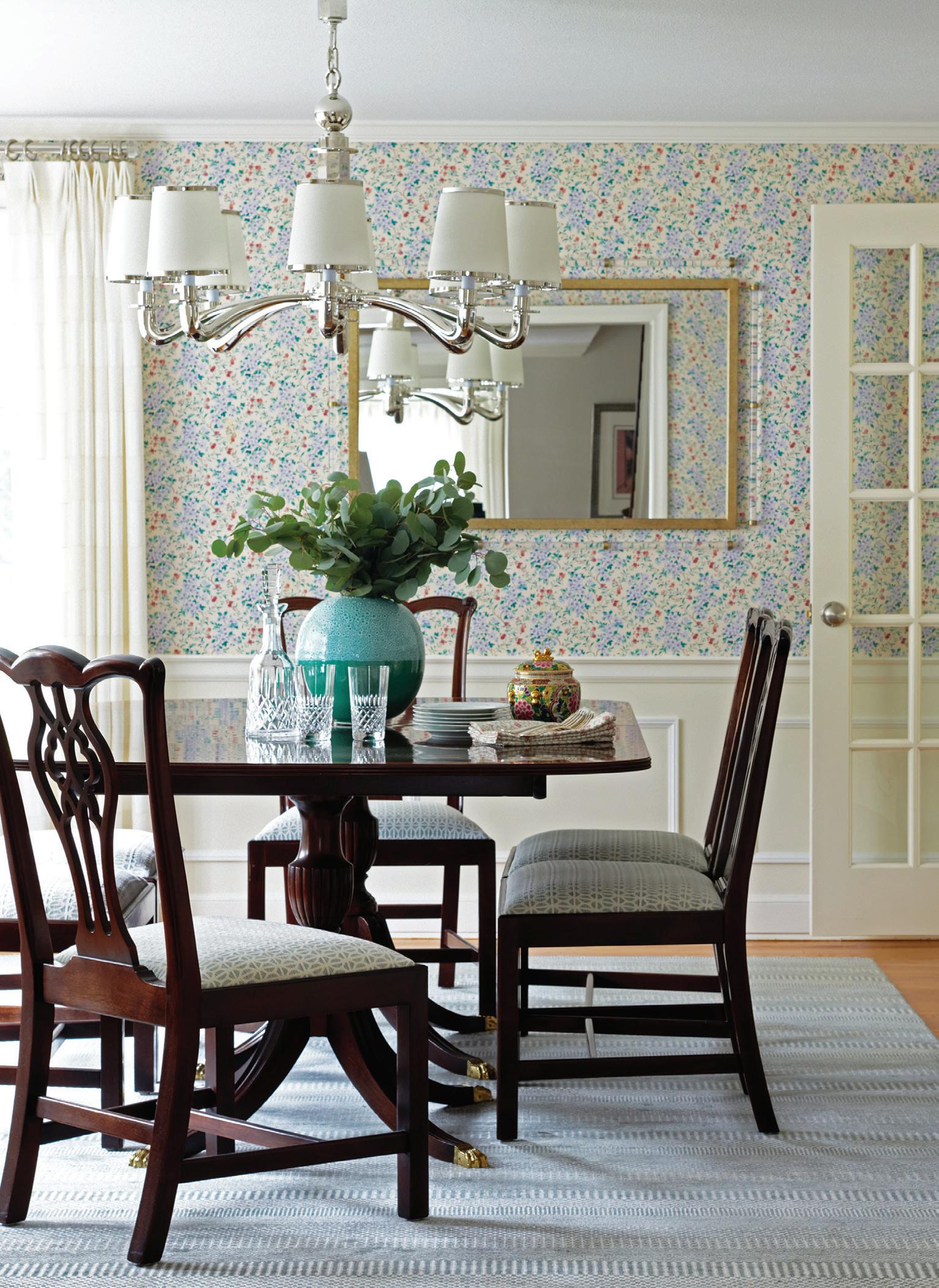
Paige Gray, co-founder and princi pal at Parker & Harlow in Powell River, British Columbia, agrees, stating that decorating in the cottage style is about staying authentic to your lifestyle.
“Look at what motivates you and makes you feel most comfortable,” she advises.
A home’s backdrop is perhaps the most obvious place to glean inspiration for any interior, cottage decor included.
“If the landscape is bustling with raw organic textures, bluffs, and wild coast line with dense woodlands, I prefer the interiors to reflect a deeper tonal range with more attention focused on bringing those organic touches into the home,”
Gray says. In which case, she’d probably pick warm earth tones and bold woven textures. But if the cottage is seaside, she prefers a soft white interior to play off the beach and serenity of the ocean.
Still, she says, “there’s something also very refreshing when beachside cottages get bold with unexpected color.” While red may make some homeowners anxious, “the statement hue could spark a fond recollection for another. If it reminds you of dock side buoys and memories of a childhood lighthouse, go with it,” she says.
Elevated tradition, as seen in this room in a Connecticut home decorated by Georgia Zikas, is one of the characteristics of cottage style.An elegant yet classic kitchen by Georgia Zikas, shown above. This page, bottom right: Laid-back luxury is on display in a Connecticut living room also designed by Georgia Zikas

Custom woodwork is an excellent start ing point, embellishing the architecture before decorating.
“Millwork is always a wonderful element to add into a room because it adds instant depth and charm,” Zikas says. “I love beadboard or wainscotting to help frame a space that perhaps needs a bit more definition.” She suggests adding wood paneling to a sunroom, dining room, or bedroom. But don’t overdo it. “Avoid the trend of putting paneling in every room of the house,” she stresses. “It can start to make the space feel one-dimensional, defeating the purpose of using bead board to add dimension.”
Zikas recommends purchasing high-quality furnishings and upscale draperies and lighting first to shape a room’s framework. After confirming those key components, introduce fun accents “to bring the cottage feel to life.”
“Keep things simple and veer away from anything that feels clichéd,” Gray says. “Have storage solutions to keep practical items like board games and crafts tucked away when not in use. Kitchens should also be straightfor ward yet elegant. Choose low-main tenance fixtures and finishes, but one exception is an old-world stove.” Gray recommends an antique look-alike to boost the cottage theme.
In terms of furniture, slipcovers are pragmatic, attractive, and often quintessential to the cottage style. A well-fitted slipcovered sofa or pair of lounge chairs can enhance a room’s design. “It’s a dying craft, but worth
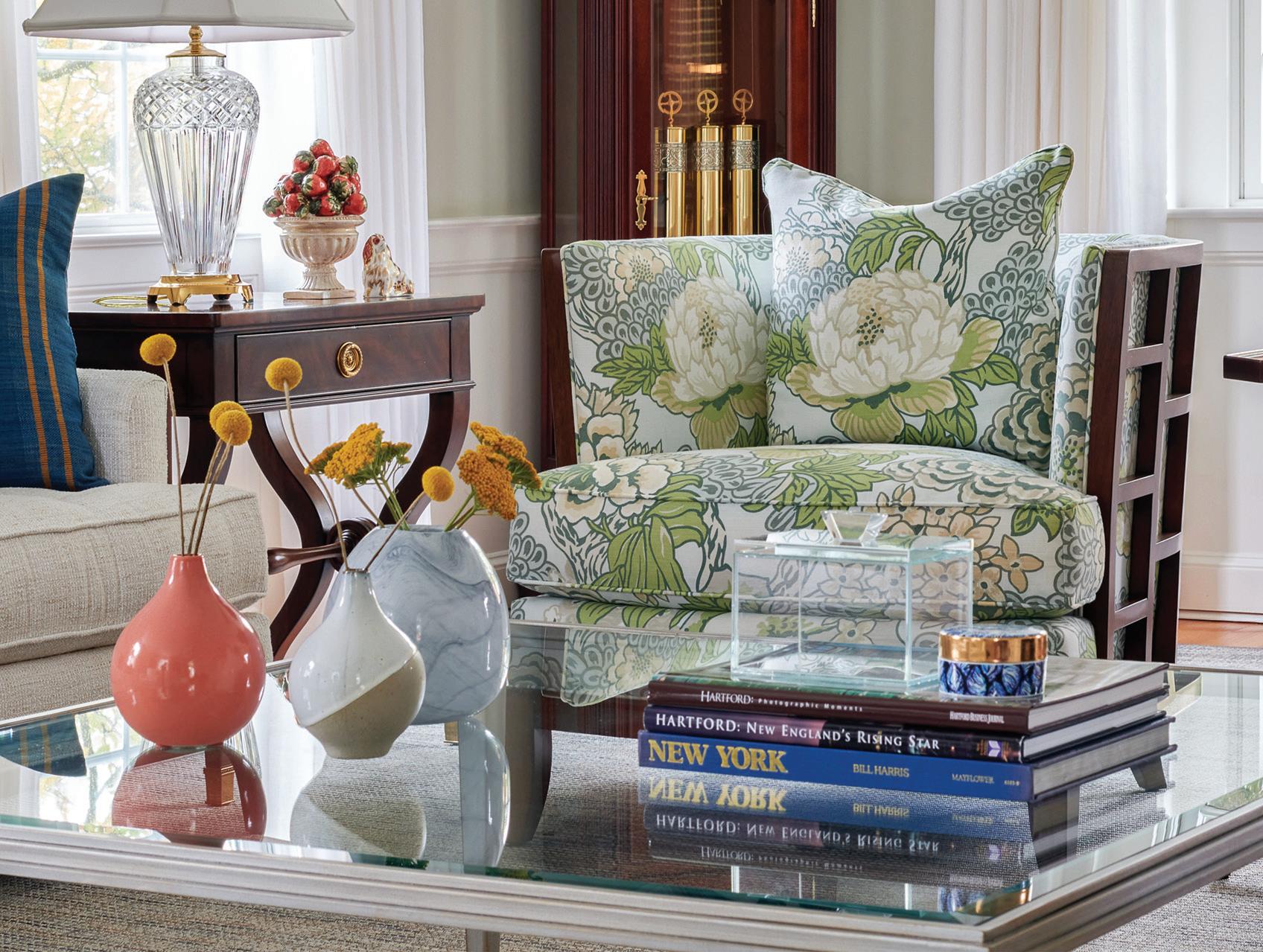
the investment to have slips that properly fit your furniture,” Gray says. She recommends going with custom slipcovers in durable fabrics. “As lovely as a 100% linen fabric looks, the fabric industry has evolved so much over the past decade and getting a textile with a poly mix in it will be much more beneficial for wear and tear as well as longevity.”
To keep a high-end aesthetic, steer clear of frilly fringe skirts and overly stuffed sofas, but there’s no need to avoid printed fabrics. “A club chair in a ticking stripe is a fabulous option for a cottage,” Zikas says.
ULTIMATELY, CURATE AND COLLECT The “collected look” may be the decor style’s signature, so curating pieces slowly will lend charm and appeal.
“Overall, let your space breathe and allow your home to gather touches over time,” Gray says. “Some of the best cottage spaces I’ve toured over the years have that certain collected vibe that only comes from years of letting a home evolve with you and your lifestyle.”
For example, a medley of cups in the cupboard can boost that curated look. “I don’t think I’ve been in a single cottage where all the coffee mugs match, and I love that,” she says.
According to Zikas, the finishing touches are all about character and comfort and tastefully mixing and matching, traits for which cottage design is most recognized and cele brated. “A great linen throw; a floral-printed throw pillow alongside a solid one in the same color family; a wicker lamp with a sleek lampshade; or a colorful rug to offset the neutrality of the space—all of these elements will instantly warm up your home and create that cozy, lived-in feel that cottage design is so loved for.”
Artfully upholstered pieces with materials like sherpa and bouclé instantly make a space feel warm and cozy. Because these fabrics, in all of their fleecy glory, are meant to be touched. “Bouclé and sherpa add infinite textural interest to anything they are used to upholster,” says Paul de Andrade of Studio Kestrel in New York. “They create a more dynamic feel to furnishings because they evolve under varying lighting conditions,” he says.
Bouclé, the French word for “loop” or “curl” is just that—a fabric named for the rings in its yarn. The nubby, textural material was born in Europe and gained widespread popularity in the U.S. when in 1948 designer Eero Saarinen crafted his iconic Womb Chair in the fabric. The material soon spread to the fashion world via Coco Chanel, who used it to iterate her couture jackets. While tradi tionally crafted from wool, today bouclé is made from blends of silk and rayon, alpaca, linen, and cotton. “At least two strands of yarn are combined—with the tension on one strand being less than the other to create this looped, pile effect,” says Elisa Baran of Elisa Baran LLC in New York.
Not as tightly woven as bouclé, sherpa fabric is named for the wooly lined clothing worn by the Sherpa people of Nepal. Though it echoes the texture of wool, it’s generally made from fabrics such as cotton, polyes ter, or a blend of cotton and synthetic fibers. Fluffier and more highly piled than bouclé, the dense faux-sheepskin fabric is used for blankets, boot and coat liners, slippers, and mittens. “It’s bouclé’s more durable cousin, made with the same curved piles of cozy material but typically with a synthetic composite making it very user friendly,” says Los Angeles-based designer Jaqui Seerman.
Both materials are having a moment in the home—popping up in interior spaces across the board from modern to traditional, says Melanie Hay of Melanie Hay Design Studio in Toronto. “Bouclé and sherpa lend a slight retro nod to the past, imparting a textural effect that pairs well with a plethora of finishes,” Hay says. “Both are as at home in a tra ditional setting paired with wainscot ting and traditional prints as they are in a minimalist, pared-back Scandinavian home with rustic wood and concrete.” They are also great alternatives to linens or velvets, Seerman says. “When used in a room with other traditional woven fabrics, bouclé and sherpa add a playful texture and catch the light to add visual diversity,” Seerman says.
This page: Madeline Tolle; opposite page: Chris Everard
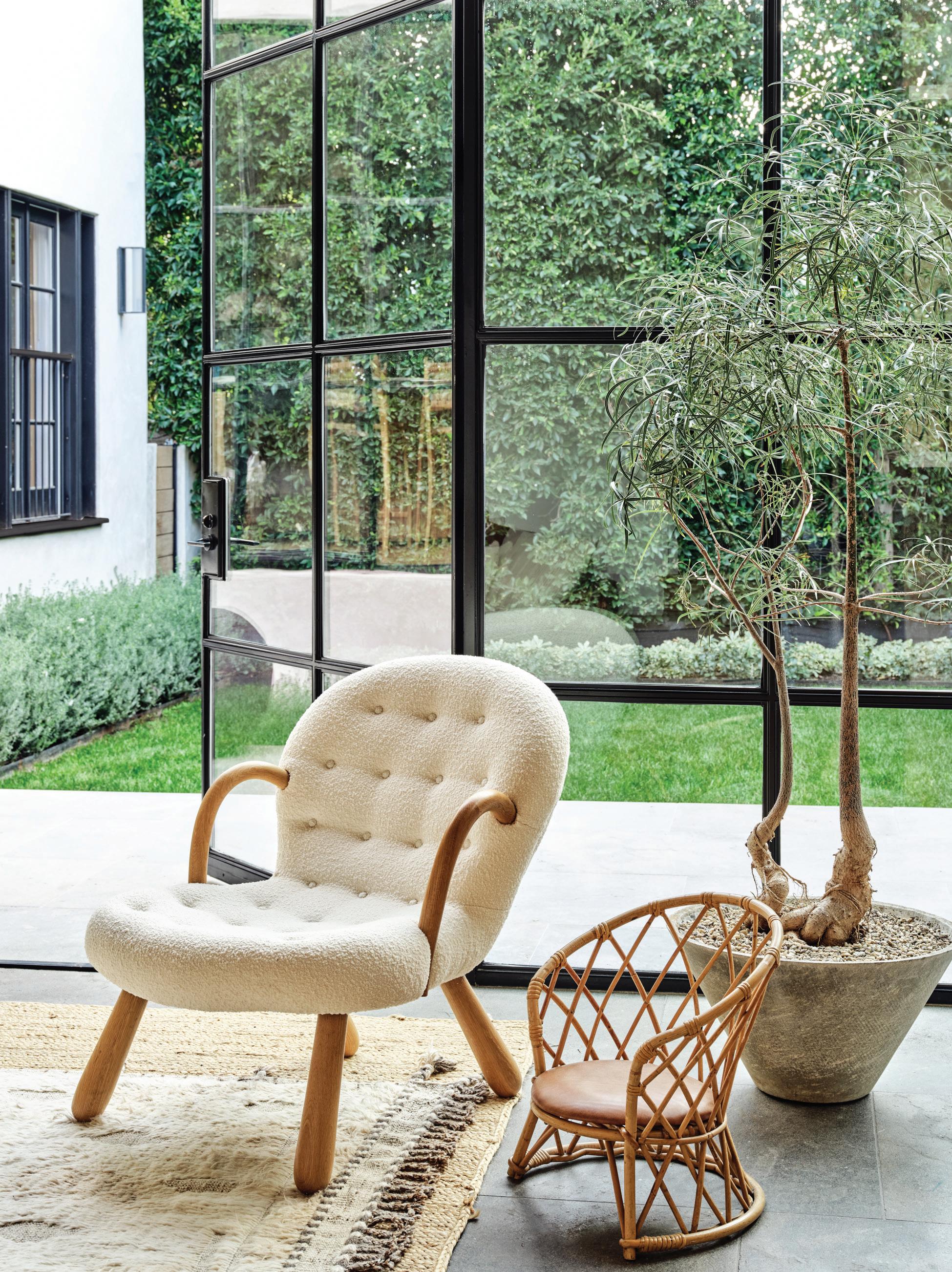 This space designed by Jaqui Seerman features a chair made of Opuzen bouclé.
This space designed by Jaqui Seerman features a chair made of Opuzen bouclé.
Since these fabrics evoke an immediate sense of relaxation, utilizing them as seating upholstery is a natural fit. “Sofas and accent chairs are usually the best items to upholster in bouclé or sherpa. This is because when they are pulled taut during the upholstery process, it gives the seating clean, smooth lines but with endless texture,” de Andrade says.
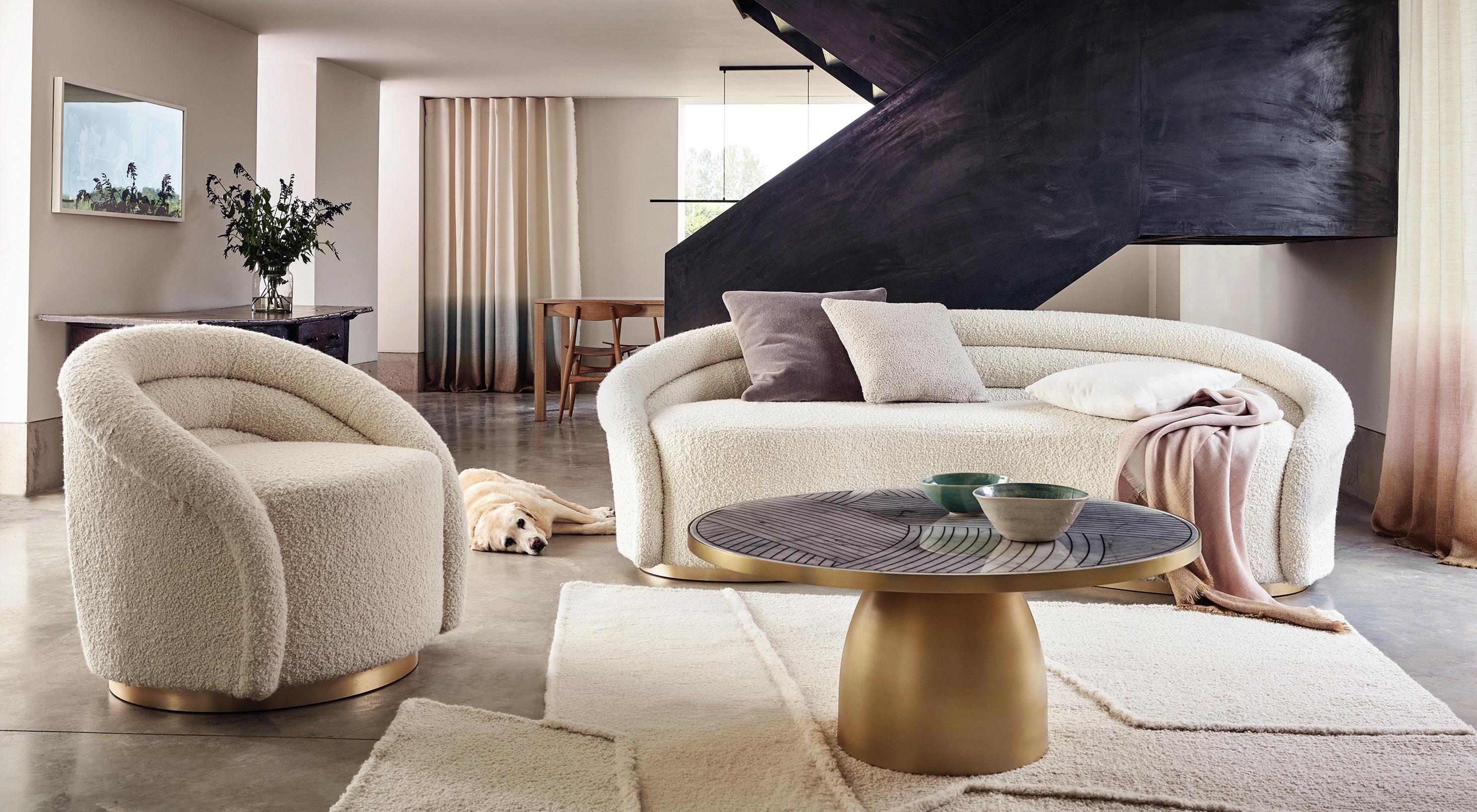
Both materials work well on tightly upholstered and slightly rounded, sculptural furniture. “It gives a ’70s Italian modern feel,” Hay says. The materials can span different furniture styles, complementing a modern piece or updating a classic piece. “A lot of cli ents are using bouclé to update a classic chair or sofa. You can keep legs exposed or upholster them,” says textile artist Rosemary Hallgarten, whose Norwalk, Conn.-based business specializes in alpaca bouclé rugs and fabrics.
“I would pick one or two key pieces in a room to use bouclé or sherpa, and make sure there are a variety of textures to balance out the impact of this partic ular fabric,” Hay suggests.
Keep in mind, more durable bouclé fabrics sacrifice sherpa’s softness. “For a family room sofa, you will want a prac tical wool blend, but for accent pieces and headboards you can use more luxu rious textures,” Hallgarten says.
Start small with accents and build from there. “It ’s also possible to inject smaller elements of bouclé or sherpa by adding a few toss cushions here and there, or by upholstering a small ottoman or bench,” Hay says.
Generally, lighter color bouclés and sherpas are more popular, “because the texture is more noticeable in whites and creams, since it catches the light in a space and evolves throughout the day,” de Andrade says. And because these fabrics are so trendy, natural colors will help them stand the test of time.
However, Hallgarten believes colors work particularly well with bouclé. “You can go brighter with a bouclé because you are getting texture, but you aren’t having to use a lot of patterns.” She sells multicolor confetti and siren-yellow bouclé fabrics, which she says work well on more classic shapes.
Hay suggests using the materials in a soft blush, which looks elegant paired with raw brass fixtures in a library, for example. “But they also look wonderful in camel, cream, or dark charcoal in a more neutral environment,” she says.
Working with such highly textured fab rics, de Andrade believes it’s important
to mix and match materials throughout a room to create interest. “I always try to integrate plenty of clean lines so that you get a modern feel. Things like wood grain, lustrous antique brass, and textured wallpapers all pair really well with bouclé and sherpa.”
Balancing these very tactile textures with smoother surfaces as well as more tightly woven fabrics helps create a lay ered look. For instance, Hallgarten tends to add fabrics like mohair, velvet, or a soft linen to the mix. She also combines textures on singular pieces, such as “our chalk-stripe alpaca bouclé on the back of a chair and our very practical indoor/out door fabric on the inside,” she says.
When working with sherpa and bouclé, Hallgarten wouldn’t use both materials in the same room and often balances the rest of a home with less textured fabrics like linen or cotton.
“You don’t want to overwhelm your home, just like you wouldn’t want to overwhelm your outfit—imagine wearing sherpa and bouclé head to toe,” Baran says. “Incorporating these fabrics creates a cozy and inviting atmosphere that balances nontextural pieces in the home. Once you add them to your space, you’ll see an immediate difference in the way it feels—and it will become the area you go to most often for comfort,” she says.
Rosemary Hallgarten designed this living room with a cozy-yet-chic bouclé seating area.
Wilmer Valderrama, who currently stars as Special Agent Nick Torres on NCIS, has filled the Los Angeles home he shares with his wife and baby daughter with unique items— be it a hand-carved bar imported from El Paso, a bright blue living-room rug, or a massive chestnut-leather couch. “It’s about warmth and comfort, but also heritage and history,” says the actor, who rose to stardom playing Fez on That ’70s Show. Elegant textures and warm hues are found throughout. It’s a bit of a mishmash—but a compelling one.
The same could be said of Valderrama’s wide-ranging career. The actor is gearing up to play a live-action Zorro for Disney and preparing for That ’90s Show on Netflix. And Valderrama continues on one of the most successful shows in TV history with NCIS. “It was a little daunting joining the show in its 13th season,” he says. But he sorted that out, ulti mately creating a character that moved the franchise forward. He did it by putting a lot of his culture and his humor into it, he says. Seven seasons later, he’s never looked back.
It only makes sense that the actor’s five favorite things at home are items that will surely stand the test of time.

“Zorro has been incredibly important to me since I was a little boy,” says Valderrama. “I grew up in Venezuela until I was 13. He was one of the very few, if not the only, hero that kind of looked like me. His elegance, his humor, his chivalry, and his intellect were inspirational. When I became an actor, I thought, ‘One day I have to play Zorro.’ And dreams come true. This statue was given to me by John Gertz. He and his family have been the gate keepers of the Zorro legacy. When we were partnering up for the live-action Zorro series for Disney, he sent me this surprise gift and said ‘You’re the perfect Zorro.’ ”

Valderrama is a global ambassador for the USO. “This flag was given to me at the USO Center in New York City. At the time, I was producing and starring in Handy Manny, and we did a reading for the military kids. The flag was flown over Ground Zero. Below, is my photo with President Obama. As a member of the executive board of directors for Voto Latino, we had a conversation about immigration reform. This framed picture arrived in the mail soon after. He had written a personal note on the bottom.”
GORILLA KETTLEBELLS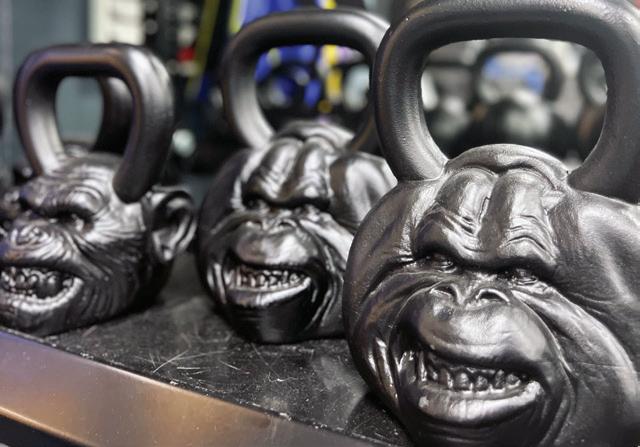
“I wanted my gym to be fun and a little badass, and I started personalizing everything. Then I found these,” says the actor. “When you’re looking at your form in the mirror while working out, you have this angry animal looking at you, and it really brings to life the fight against yourself. It triggers an emotion. You’re there in the gym alone, and you just have to do it. It’s almost like these kettlebells are looking at you, keeping you in check.”

“In indigenous cultures—I’m 47% indigenous South American—skulls are sometimes kept as a symbol of safety and protection. This is one of maybe 14 skulls I have. In the morning, I give it two clicks on the forehead and start my day. It’s almost like an acknowledge ment of an exchange of energy.”
“Michael Miller is an iconic photographer—he does all the Marvel posters and artwork. But he also does something truly special with his own photography, capturing animals in their natural habitats,” says the NCIS star. “I connected with his art so much, and we met through our mutual friend and have since become incredibly close. In my own career, I’ve had to find confi dence from a primal instinct, to have the audacity to believe I could achieve things that, culturally or stereotypically, people thought I couldn’t. That photo reminds me of the serenity and confidence, but also the stillness, I should have as I carry myself in this industry and in my career.”
of Wilmer Valderrama


Jennifer Chamandi launched her luxury shoe brand just 10 days after giving birth—to identical twins.
Her former colleagues at Merrill Lynch were likely not surprised. Chamandi is, if nothing else, 1) efficient, and 2) obsessed with shoes. Always has been.
Hustling around the trading floor, the London School of Economics grad quickly became known for her signature high heels. She worked at Merrill for seven years, while taking design courses at London’s Cordwainers College and Central Saint Martins. In 2016, she launched her luxury shoe brand. The craftsmanship (each shoe is handmade in Italy) and patented “eye of the needle” stiletto (a gold-plated eye is carved into every heel, allowing a strap to slip through and support the foot) caught the eye of buyers, from Harrods to Bergdorf Goodman to Net-a-Porter.com. And celebrities like Amal Clooney, Meghan Markle, and Anne Hathaway.
Born in Lebanon and now based in London, Chamandi, 35, launched handbags this past spring, and in recent weeks unveiled an online bespoke program, allowing fans to create shoes using some 400 combinations of materials, shades, and heel heights.

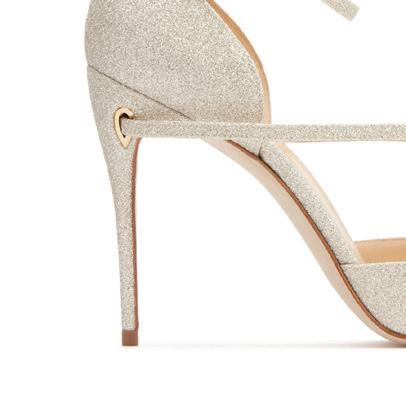
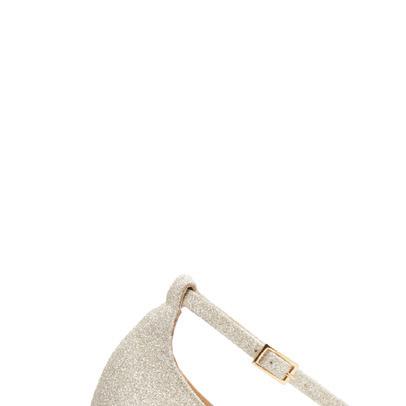
Sitting in her London showroom against a pink wall lined with shelves of shoes, Chamandi recently chatted with RESIDE® about her passion for math, efficiency, and shoes, shoes, shoes.
Given the timing of your children’s birth and your brand launch, it seems fair to say you’re a multitasker.
I think it was perfect timing. Had I had the kids before, I would’ve delayed launching. Had I launched the business before, I would’ve delayed kids. So…10 days apart was the perfect storm. It’s like having triplets.
Oddly, that makes sense.


Last October, I celebrated five years with the brand and the girls. This is the first year I feel I’m above the surface. When building a business, the first few years are a steep learning curve. Raising kids is the same. And having twins means
double everything. But now they entertain each other, they have the same homework, same parties. So…it’s very efficient.
Spoken like a true banker. I always wanted to do shoes, but in Lebanon if you’re not a doctor, engineer, or accountant, you know, there’s a problem. [She chuckles.] I entered finance, thinking I’d be there a couple of years. It turned into seven. I was on the structured-products desk, which is very technical, analytical. I’ve always loved mathematics. I’ve always said that shoes are the mathematics of fashion.
Ha! You may be the only person who’s ever seen that correlation. I know. [She laughs.] I’m going to show you something I’ve never shown anyone. One second. [She rifles through a clear sleeve folder and pulls out a sheet of paper with the image of her two-toned Lorenzo pump, detailed with lines and angles, reminiscent of a blueprint.] Just to show you how my brain works. The strap is parallel to the ground. The heel is perpendicular to the strap. And the outer slant [of the toe-cap] is 45 degrees. Nothing is random in the design.
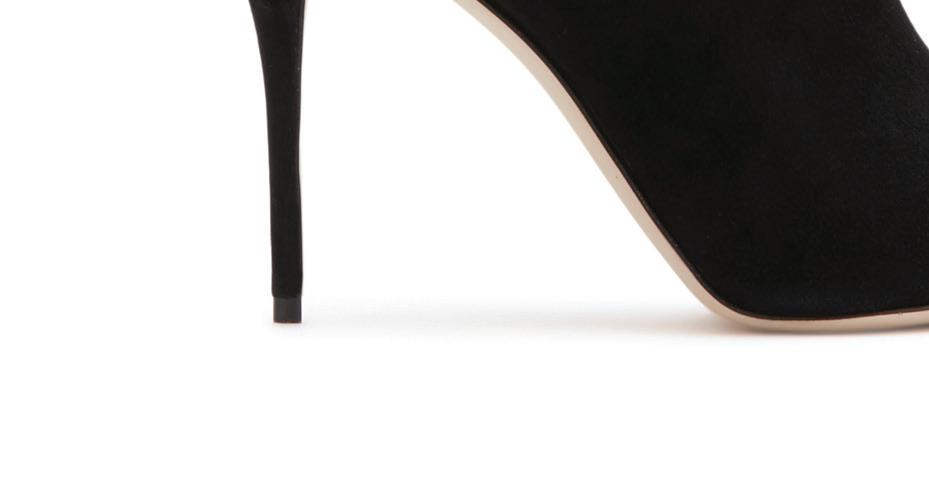
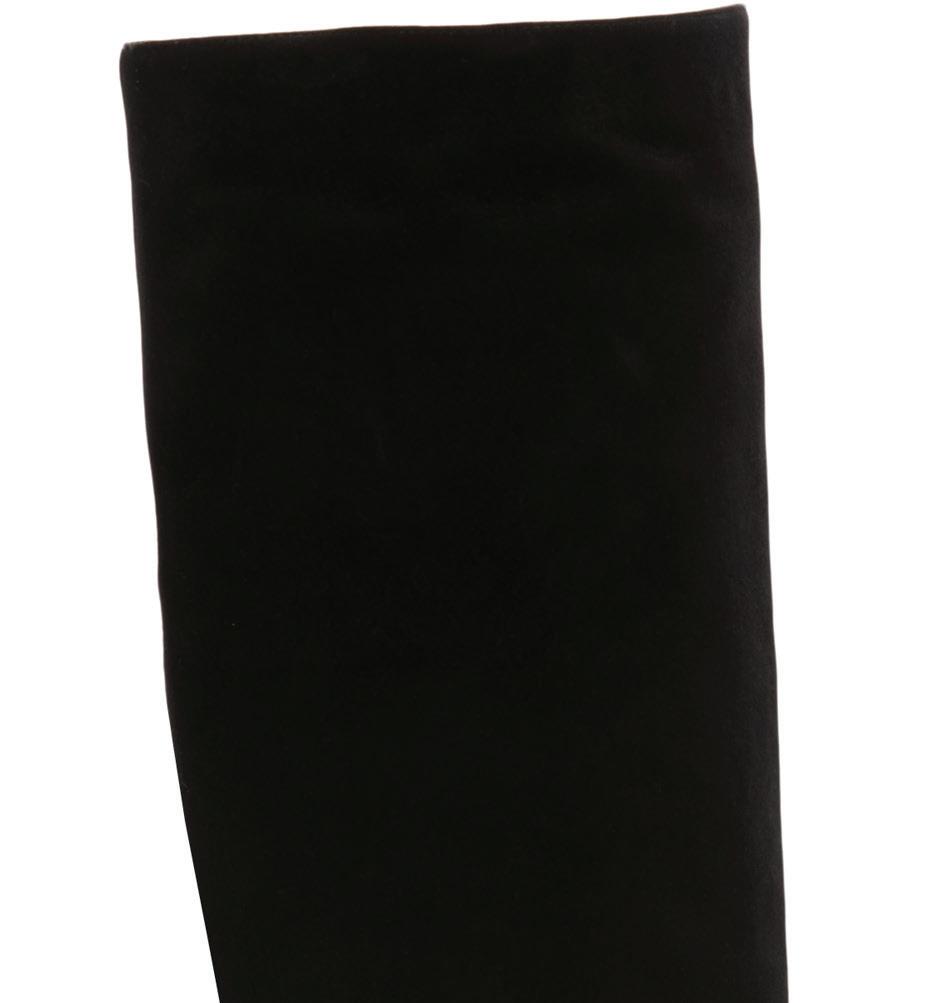
Both ready-to-wear and bespoke options are available.
Your handbag line, Le 8, shares the same geometry and clean lines. Why eight? Numbers are international. I say “le huit,” but other customers call it “le eight” or “le otto.” Eight is my
AFTER LEAVING A CAREER IN FINANCE, LEBANESE BORN DESIGNER JENNIFER CHAMANDI IS TAKING LUXURY SHOES TO NEW HEIGHTSCourtesy of Jennifer Chamandi (3); Hoda Davaine (portrait)
lucky number. Each bag’s buckle is in the “eye of the needle” shape, in crystals. For spring 2023 I’m doing the buckle in pearls. When you put two of those “eyes” together it forms a number eight. So it’s not random. Everything’s connected.
And, in this case, charitable—10% of handbag proceeds from your website bene t the Anna Freud National Centre for Children and Families.


They do amazing work [supporting children], especially in the early years. They say the first five years are what molds the individual for life. I’ve just gone through those years with my children. They’re crucial.
All your goods are handmade. Why was that important to you? My factory [outside Milan] is a three-generation atelier. It’s all done by hand. The stitching of every strap on every slingback is done by my manufacturer’s grandfather. That’s why I called this pump after him—the Vittorio. It was our first slingback. He’s so particular about them. And the heels are specially made, costing about 20 times more than a normal heel. Twenty times! That cuts into my margin. But I wanted to have this heel, and that “Made in Italy” stamp.
I’m all about timeless designs. The look of my shoes is classic. You buy a pair, you cherish them, you wear them with different outfits. I rewear my shoes all the time. Obviously, I have a business to build, and I want women to buy more than one. But a good shoe will last. This is something clients feel when they see the shoe and slip it on. They feel the craft.

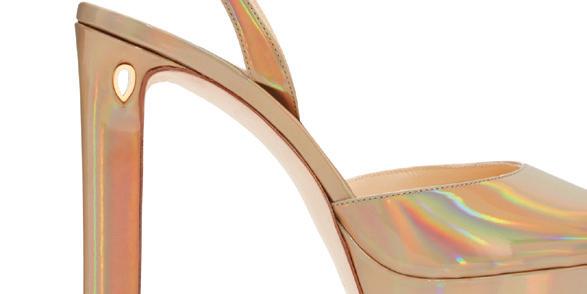
 Jennifer Chamandi, shown at left, uses mathematical-level precision to create her shoe lines.
Jennifer Chamandi, shown at left, uses mathematical-level precision to create her shoe lines.
POPULAR WITH BOTH MEN AND WOMEN, THESE TIMELESS CLASSICS ARE MORE THAN A MERE ACCESSORY
hen you begin to learn about the history of signet rings (the name comes from the Latin word “signum” or sign), one thing becomes quite clear: This is a piece of jewelry that once served a very important purpose, making them far more than a mere accessory.
In ancient Egypt, members of wealthy families and the Pharaohs themselves would dip these rings, which traditionally bore the family crest, into hot sealing wax to “sign” important documents.
These classic pieces were also used to seal other corre spondence, says Emmet Smith, the founder and owner of Rebus, a bespoke jewelry company in London that’s known for its traditional hand-engraved signet rings.

“You’d use your signet ring to seal a sensitive letter, a love letter, or any information you needed to be discreet,” says Smith, who founded his company in 2005 as a department within R.H. Wilkins, the renowned engravers based in London’s Hatton Garden.
The design was ingenious, too, from the very inception of these pieces, he says.
“The way it works is that your family crest is carved deeply into the ring, but it has to be in reverse,” he says. “This way, once the ring is pushed into the wax and released, that wax impression is in the correct direction.”
Emmet Smith’s Rebus creates hand-engraved signet rings, shown at top, that are entirely bespoke; a ring by Ruffs, shown below, one of the oldest signet ring makers in the U.K.
This page, from left: Gione da Silva; Emmet Smith; opposite page, from top: Emmet Smith; Gione da Silva

For all the millennia since, the signet ring has remained a jewelry staple that transcends fashion trends.
“They’re not showy,” he says. “It’s something you can wear every day to any occasion. It’s the only piece of jewelry, besides a wedding ring, that you wouldn’t take off.”
Smith says that customers remain interested in signet rings with family crests and monograms, but they’re also expanding into requesting rings with symbolic images that matter to them personally.
“We put mood boards together and flesh out symbols for our customers,” he says. “A signet ring is simple, elegant, and a blank canvas to make your own.”
And, unlike other types of jewelry, signet rings are equally popular with men and women, says Mark Ruff, execu tive chairman of Ruffs, one of the oldest makers of signet rings in the U.K.

“Once upon a time they were a mark of a gentleman,” he says. “But that’s no longer the case. I think everyone can— and should—wear them.”
In addition, while signet rings are traditionally worn on the pinky finger of your left hand, there are no hard and fast rules anymore, says Ruff, who represents the fourth generation of the Ruff lineage making signet rings since 1904.
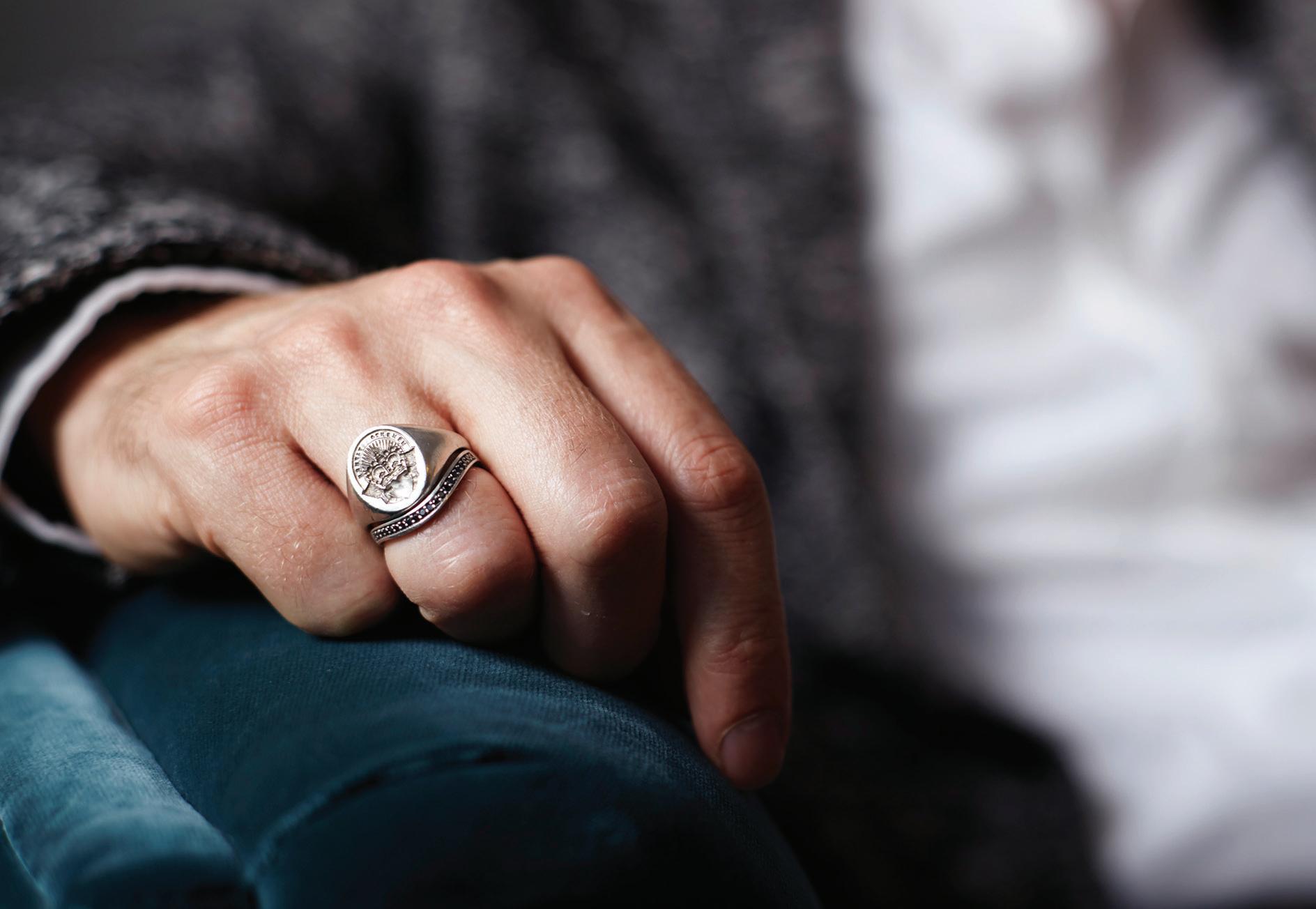
“I always say to a customer ‘wear it where you feel most comfortable, like a piece of clothing,’ ” he says.
One interesting new trend: Some couples are now designing unique signet rings instead of shopping for traditional wedding bands.
“Wedds, as we jewelers call them, symbolize love and commitment,” Smith says. “The traditional wedding band is slowly evolving into state ments of a couple’s individuality; this is where the signet ring comes into its own.”
These “bands of gold” boast hand engraving—and a bigger surface area—
and offer an opportunity to become a personal emblem for a couple.
“Couples can put more information within a signet ring,” Smith says. “For example, we can put secret messages inside the shank, we’ve done mountain ranges where the couple met, and we can add a depiction of a favorite pet. The options are limitless.”
And, signet rings can also serve as a lovely gesture that symbolically con nects two families, Ruff says.
“You can use the time designing signet rings as an opportunity for two families to unite and make family crests together,” he says. “What’s most won derful is that signet rings are timeless and made to order, which makes them even more special.”
The Keeper signet ring with black diamonds, shown above, is from London-based Rebus.
A collection of unique signets from Ruffs is shown at left.
CONCIERGE SERVICES CREATE ONE - OF-A- KIND EXPERIENCES — AND THEY’RE GETTING MORE LUXE

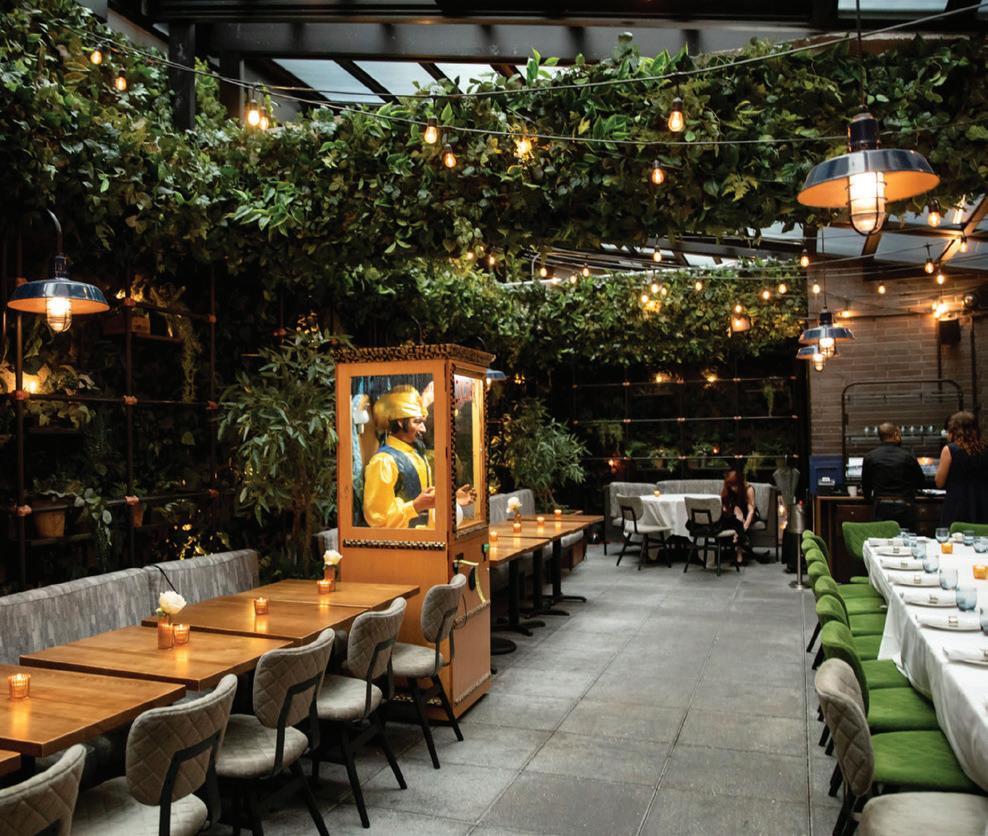
In today’s fast-paced, experience-first world, concierge companies are evolving to satisfy their clientele. Adventures and celebrations are getting more personal, more spontaneous, and they’re lasting longer. “More and more people have realized that life is short,” says Lauren Wilt, U.S. CEO of Quintessentially, a London-based global concierge that provides luxury lifestyle services such as travel experiences, restaurant access, and creating personalized events. “They want to enjoy the time they have, and they are willing to have a professional plan for them.” The growth in interest has led the company to nearly double its U.S. staff in the past year.
Before the pandemic, clients would book 12 months out for big family vacations, but now 70% of these bookings are for trips in the next 60 days, Wilt says. “If prepandemic they took more vacations, they’re taking fewer now, but for lon ger,” she says. “It feels like, ‘It’s good now, let’s do it. We don’t know if things are going to change, so if it looks safe, let’s do it.’ ” And as such the company is ready to change flights at any hour, Wilt says.
Kimberley Watt, director at The Fixer, a London-based global concierge providing bespoke experiences and travel itineraries, says: “Before, we were probably doing 25% last-minute versus 75% planned. Now we’re probably doing 75% last-minute. Covid completely changed the way people act. They live in the moment a lot more.”
For example, The Fixer received a late-June request for 20 boat rentals on July 4, and restaurant requests and cancellations
This page, top: The Fixer offered clients a private viewing of the Northern Lights with a lodge buyout in Finnish Lapland. This page, bottom: A Maldives snorkeling experience courtesy of The Fixer. Opposite page, left: A picnic in Montauk planned by The Fixer; a private birthday event in Manhattan, by The Fixer, shown at right.
are more sudden, says the company’s U.S. lifestyle manager, Emily Tierney.
“I’ll go there myself in person to try and get the reservations, because we don’t like to say no,” she says.
Quintessentially has also expanded its reach when it comes to restaurant access. Bookings had focused on New York, Los Angeles, and Miami, but things shifted during the pandemic.
“People moved, so access to restaurants around the country and around the world is important too, so we’ve had to expand,” Wilt says.
With requests growing for larger and more personalized experiences,
The Fixer is spending more time on fulfillment while expanding its staff, Watt says. “It feels like people have been holding back, and they suddenly let go,” she says.
The Fixer’s popular recent offerings include a customized ski trip to Deer Valley, Utah, with a private jet; night snorkeling with whale sharks in the Maldives; and a birthday event with an artist who creates souvenirs.

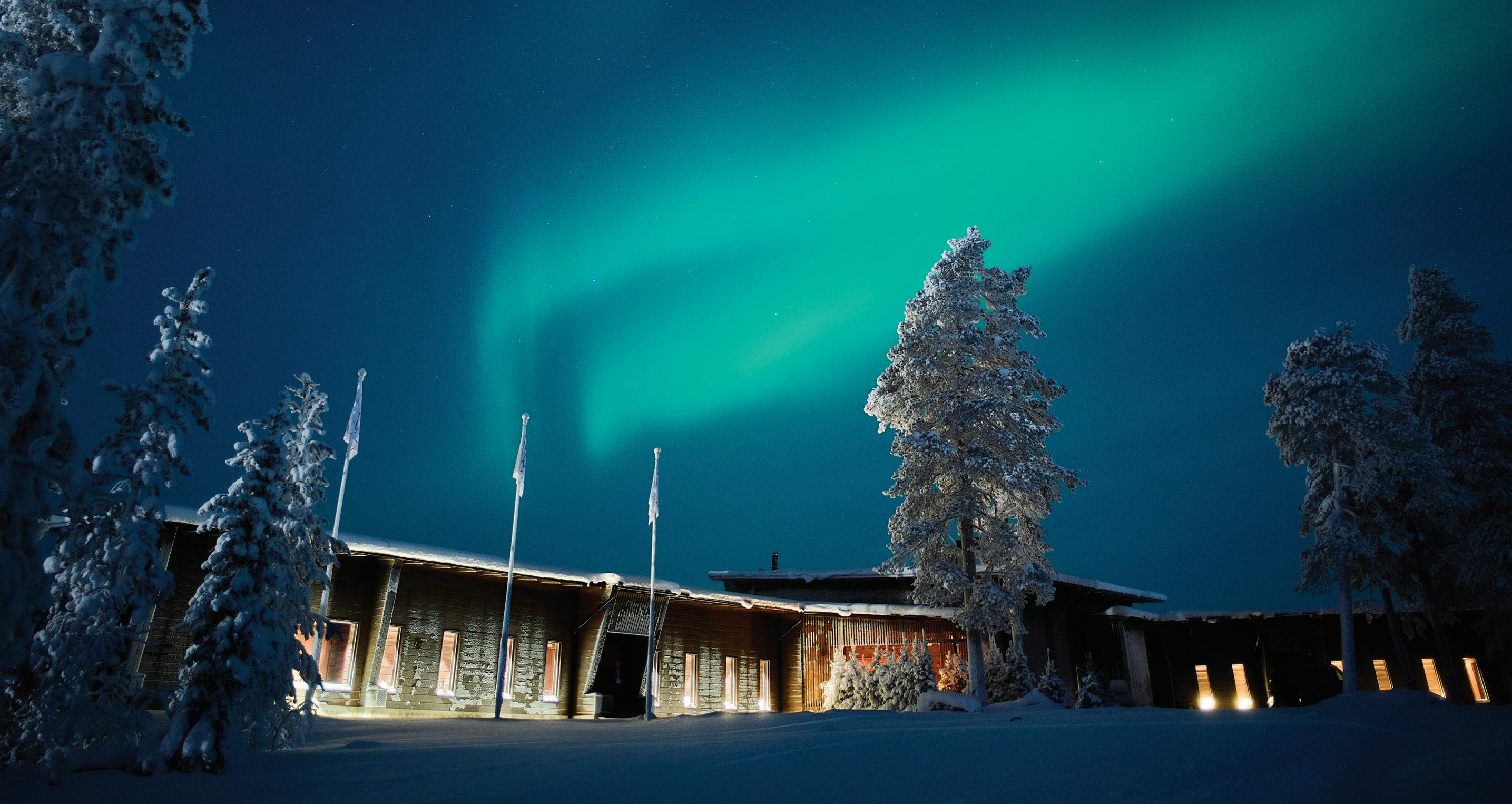
Concierge services also need to handle pandemic concerns. “We had a client who wanted to go skiing over the winter, but it was still Covid, and they still wanted their privacy,” says Tierney.
“So we ended up getting a residence within a resort, and rather than having them up in the resort with all the peo ple, they had their private residence.”
The Fixer found private ski instruc tors who were dedicated just to the kids for the whole week. The team also navigated limitations on 24-hour room service. “We really wanted to have the kids be able to order hot chocolates or ice cream sundaes after the time that it may be offered, so we brought in a pri vate chef and a server that would come every night.”
At Quintessentially, Wilt says she’s seeing requests for bigger milestone celebrations, too. “A member’s wife is turning 60 this summer, and instead of just hosting a party for a few friends, he’s hosting a party for 100 people and we are planning all the travel and an A-list musician performance,” Wilt says.
The experiential realm is an important part of today’s requests, Wilt says. Whereas in the past people might have just bought a large gift like a luxury timepiece, “now it’s going on a factory tour and really experi encing the brand,” too, she says. “Our customers are more in tune with how those brands reacted during the pandemic: sustainability, supporting people in need. People took a really hard look at life and what’s important in the long run.”
Opposite page, from left: Emily Tierney, The Fixer Lifestyle Group; Armando Espinoza; this page, from top: Octola; COMO Maalifushi
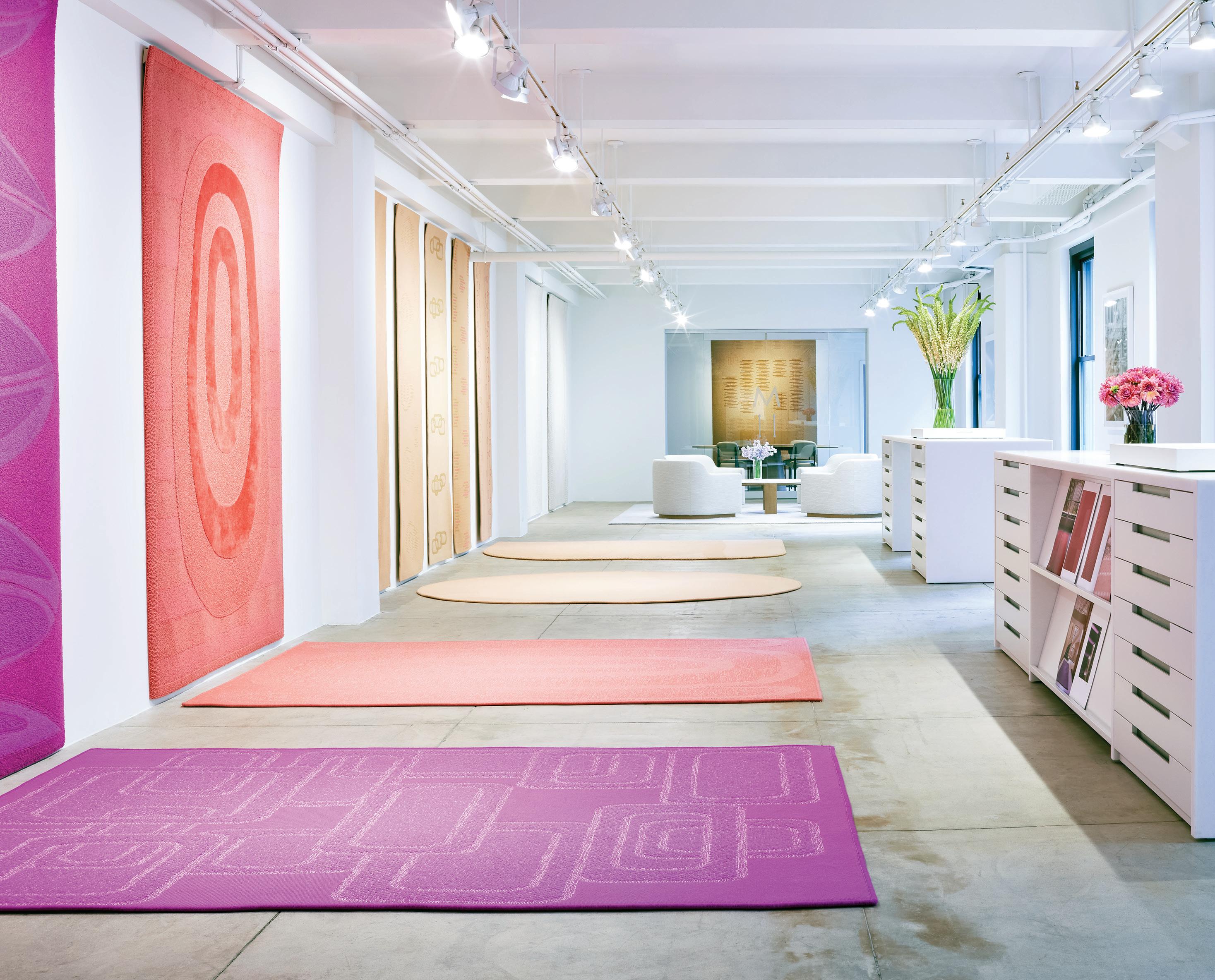 From top: William Geddes; Jared Leeds Photography
From top: William Geddes; Jared Leeds Photography
Merida’s showroom has a gallery-like feel. It’s an illuminated and minimalistic space that lets the colors and textures of the environmentally friendly pieces shine.
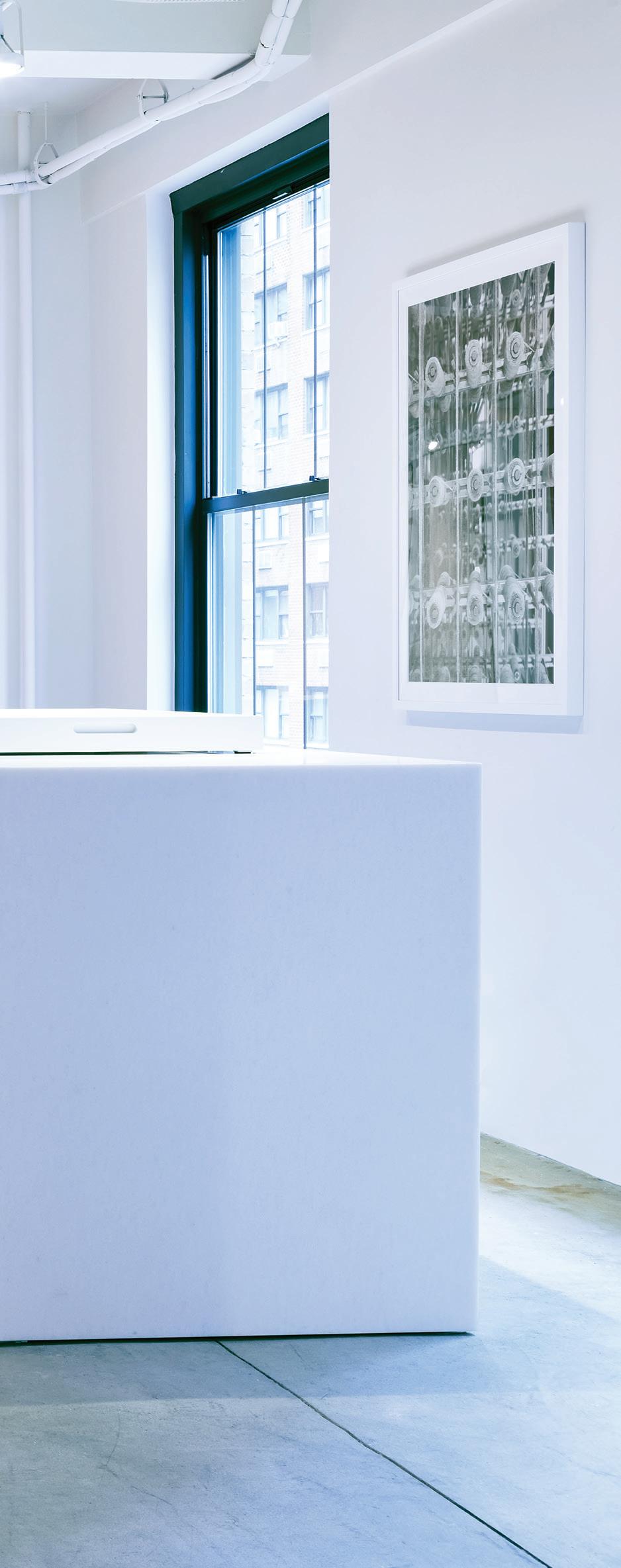
At a time when more than 90% of the world’s rugs are stitched together with fragments of plastic and chemically bathed synthetics, one American textile house is consciously threading the needle in a different way.
“Our mission is to be a countercultural company reimag ining textile design and manufacturing in the U.S.,” says Catherine Connolly, CEO of Merida, which crafts woven-toorder, eco-friendly rugs and stair runners made to inspire and transform the canvas of everyday living spaces.
“We took the long view and started to create an environ ment where we could be part innovation lab and part atelier, where we were practicing and perfecting technique on a regular basis.” Connolly says putting authentic materials that are healthy and beautiful into the hands of artisans means the possibility of something special. “I knew that the products would have to be unique and truly extraordinary if it was going to work.”
Connolly, who took over as CEO in 2007, favors a balanced approach to evolving the direct-to-trade company, while making it a continuously enriching experience for customers, industry professionals, and Merida’s own employees.
One guiding tenet is to utilize all-natural and rapidly replenishable materials that are safe for the environment and healthy for the home. Merida’s products often feature an amalgam of fibers as identifiable as they are comfortable to the touch, including wool, linen, mohair, cotton, even silk. Yet being environmentally aware isn’t just a hyped-up publicity tactic. In January 2022, Merida became the first U.S. company to earn Green Product Assurance certification, meaning all components of Merida’s rugs, including the backings, have been rigorously tested and found devoid of harmful chemicals and materials. “We feel it was important to authentically tell people not only our commitment to natural materials but also to the health of our clients and our craftsmen,” says Connolly.
Another company commitment is directed at the team of Merida makers. This collective of artisans and craftsmen makes up part of the 35-strong team at Merida headquarters, an impressive 40,000-square-foot workshop and yarn library located in Fall River, Mass., the original textile mill hub of America. Because reverence for textile fabrication and future innovation is so intrinsic to the brand, Merida’s in-house artisans and weavers are continually emboldened to learn, evolve, and thrive, explains Connolly. “We aspire to elevate the practice of craftsmanship by providing opportunities for our craftsmen to master techniques, gain the confidence and have the space to innovate, and develop viable careers.”
This handiwork flourishes in Merida’s robust collections of colorful, comfortable products envisaged by artistic direc tor Sylvie Johnson. The 2022 Portfolio collection, guided by a curated lineup of soft watercolors, takes its cues from the Arte Povera movement, a translation of found materials into artistic expression. The 2022 Atelier collection pulls out the stops with color and texture; it plays on the theme of light and shadow through a sophisticated and textured palette of natural yarns that evoke a comforting beauty to the eye and also underfoot.
Atelier is a collective celebration of original forms, both organic and sym metrical, inspired from a menagerie of natural and manmade notions ranging from landscapes to precious baubles, cultural heritage sites, and artists and artistic movements of all genres, including sculptors, photographers, architects, and fashion designers. There’s nothing commonplace in these creations, and that’s the point.
Johnson explains that memory, tradition, and story are elemental to the designs, an accumulation of experiences in living, and especially through art, travel, and food: “We can’t create from scratch—everything we learned through reading, any exhibits we saw, any music we listened to, every meal we had.” Johnson says these lived moments are woven directly into the rugs and emanate as texture, contrast, and unexpected detail.
Pricing for this attention to detail ranges depending on the order, but retail costs for a typical 8- by-10foot rug made in Fall River hover around $10,500.
For Merida’s new flagship show room, which debuted at the New York Design Center in May, it was only fit ting to create a gallery atmosphere that could present the collections as they were meant to be experienced: in an illuminated and minimalistic space where the colors and textures can be celebrated. The finished gallery is the work of New York interior designer Mark Cunningham and his team, who have worked with the brand for many years.
The most gratifying part of visiting the showroom isn’t just the rainbow buffet for the eyes, but also the experi ence of walking on livable art. Customers are invited to take off their shoes and to feel the handicraft of what Merida does best.
The final brand commitment, says Connolly, is simple but perhaps the most meaningful of all: creating a com pany that thrives on quality, beauty, and respect for the process. “Merida cultivates a virtuous circle by creating products that bring as much joy to the maker as to the receiver.”
Manufactures Emblem Paris has been able to preserve French furniture and support artisans and their craft.
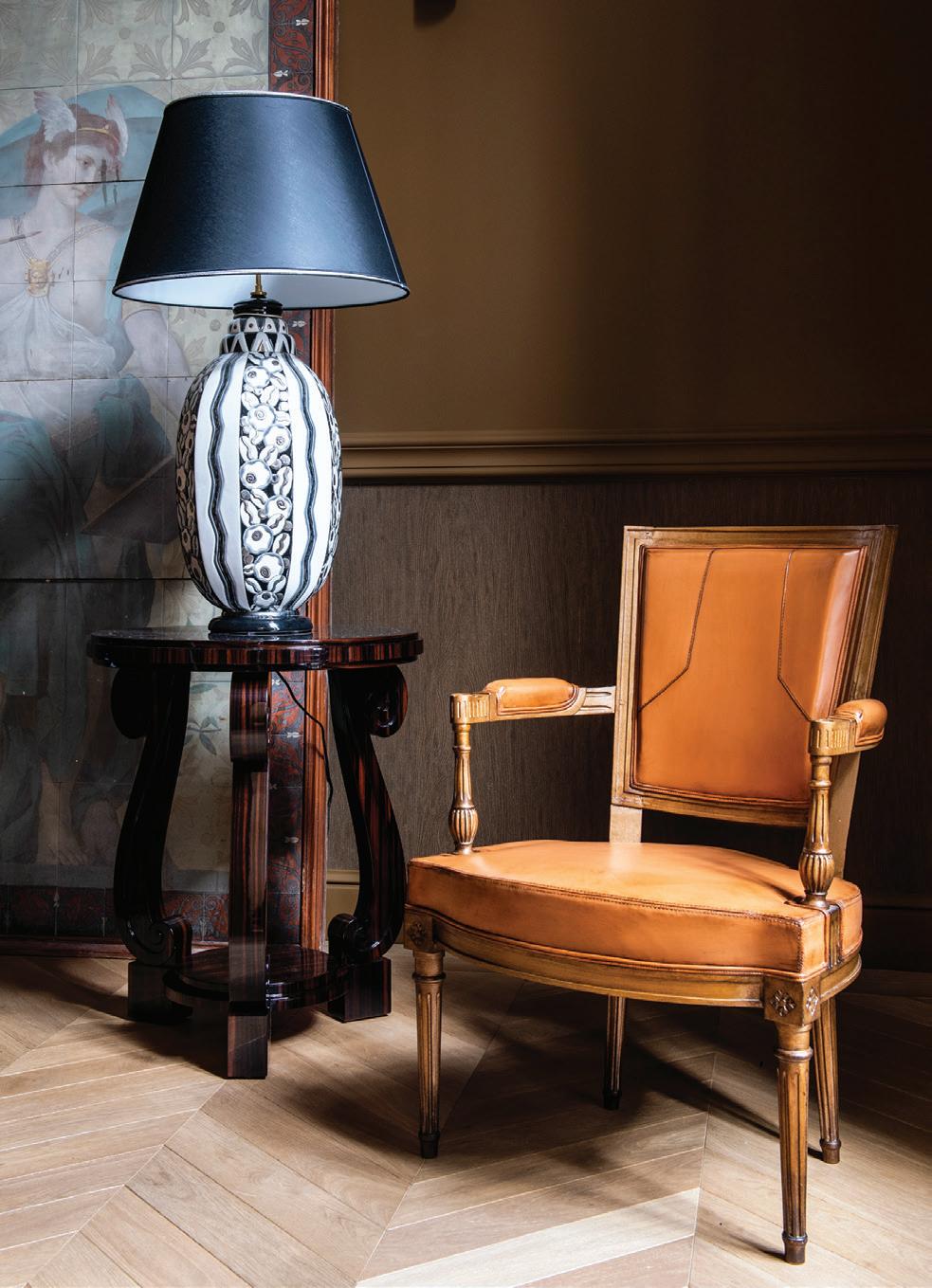
W
hen entrepreneur Martin Pietri founded Manufactures
Emblem Paris in 2015, it was both to preserve some of France’s celebrated furniture ateliers and to support the artisans who were living repositories for centuries of rare craftsmanship and expertise. It was also a way to reconnect with his own family’s lost cabinetmaking heritage.
“It was in my DNA and in my culture,” Pietri says while seated in a Choiseul bergère from his first acquisition, Maison Taillardat. In Emblem’s new, gembox of a showroom in New York’s SoHo, Pietri recalls how his maternal grandmother would tell him stories about Georges Jacob, the maîtreébéniste (master cabinetmaker) who founded a dynasty of cabinetmakers in 18th-century France.
Pietri heard how Jacob was responsible for Louis XVI’s throne and furniture for Marie Antoinette—and how that relationship almost cost Jacob his head during the French Revolution. Thanks to his friendship with the famous painter Jacques-Louis David, Jacob was spared the guillotine, and went on to provide elegant furniture for many of Napoleon’s residences, as well as his descendants.
But the story Pietri’s grandmother related was not just one of nostalgia, but of regret: Jacob’s grandson Alphonse Jacob Desmalter shuttered the company doors, ending the dynasty of these pre-eminent neoclassical cabinetmakers.
In 2015, destiny called.
While visiting Maison Taillardat, which manufactures high-end traditional furniture designed and executed accord ing to original drawings from the 18th century and traditional methods, Pietri met with the company’s matriarch, Madame Taillardat. She told him her daughter didn’t want to take over the company, and that she needed to sell Maison Taillardat. “At this time I was wondering about my professional life,” Pietri says. “I wanted to reconnect with this part of my family legacy, and I decided I wanted to get into my own creative business to have more freedom.”
Pietri saw an opportunity to both have his own business and to restart his family’s story. “Of course, she was not from my family, but it was the same field, the same know-how,” Pietri says. “These things spoke to me very, very deeply.”
Pietri remembers his first visit: “When I walked into the workshop and saw the team, the products, I thought, ‘This is for me.’ ” In the Maison Taillardat catalog, there is a Jacob
chair, which honors Pietri’s ancestors. Maison Taillardat is the biggest part of Emblem’s portfolio. “We do business all over the world, in the most beauti ful palace hotels, such as George V, Le Meurice, and Plaza Athénée hotels in Paris, but also in amazing homes for people,” Pietri says. “At the same time, because we only work with interior designers and not the general public, we’re not very well-known.”
In addition to Maison Taillardat, Pietri also added enamel specialists Manufacture des Émaux de Longwy
to the Emblem Group. The company, which dates back to 1798, is the last manufacturer in the world to practice its specific technique of cloisonné, which uses ceramic as the base instead of the more commonly used metal.
“It’s very important to keep this exper tise alive,” Pietri says. “I’m very proud of this company because this year we worked with Yves Saint Laurent and with the architect and designer India Mahdavi.”
Pietri soon acquired furniture maker Maison Craman-Lagarde, known for French classic, Art Deco, and contem porary styles. “At Craman-Lagarde we can manufacture Marie Antoinette’s desk in mother of pearl [the original is at Château Fontainebleau],” Pietri says. “And at the same time we can work with a French designer to do very contemporary marquetry.”
Vernaz & Filles, renowned for its gold leaf and custom restoration work,
is the latest addition to the growing Emblem portfolio. “It’s amazing because nobody knows that gold leaf can be applied everywhere,” Pietri says. “We do projects for residential, for public areas, and within Emblem— Vernaz works with Taillardat to gild wood, for example.”
The showroom in New York’s SoHo displays Emblem’s high-end museumquality furniture and decorative objects of both classical and contem porary design with a kind of je ne sais quoi; walls and ceilings are covered in garden treillage with blue-sky motifs, and a Vernaz & Filles gilded mirror hangs above a Maison Taillardat Reine console, which looks down on a Murat chaise from Maison Taillardat. There’s even a replica of Marie Antoinette’s lit pour chien, the Théodore dog bed. Bees, Emblem’s logo, are featured on cabinets while birds decorate walls and ceramics, alike.
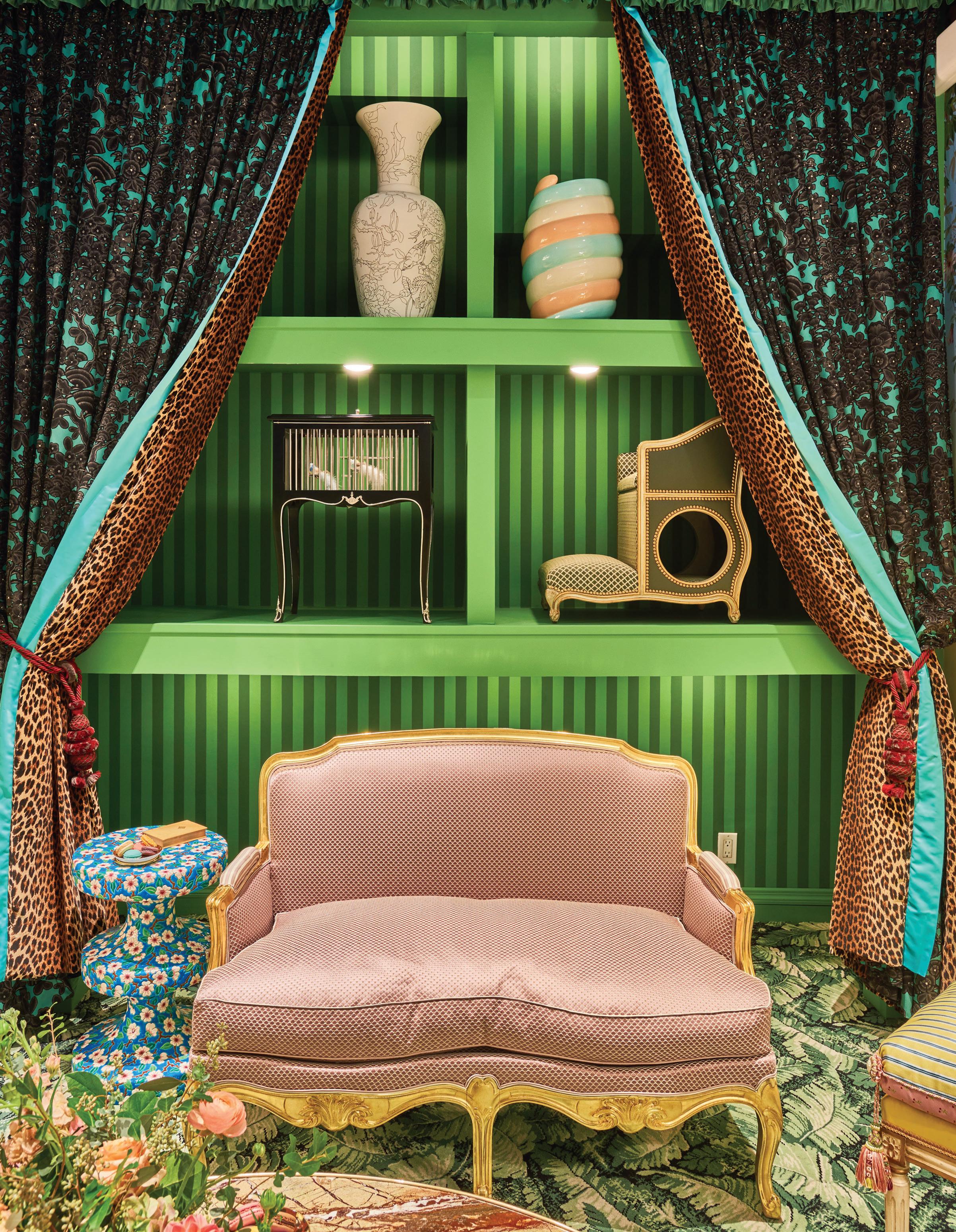
“So this little Frenchie comes to the U.S. with 18th century-inspired chairs,” Pietri jokes. “It’s quite unique.” Jokes aside, Pietri enjoys being a bit of a nov elty in the States. “We are so French, so colorful, so fantastical, but at the same time we can give a contemporary twist.”
Pietri’s contributions to the advancement and preservation of France’s design heritage won him the honorific “Chevalier” by the French government in 2021.
“I think I am in the middle of the story,” Pietri says. “In order to remain relevant, we need to double our size. I want to welcome new knowledge, techniques, and companies.”
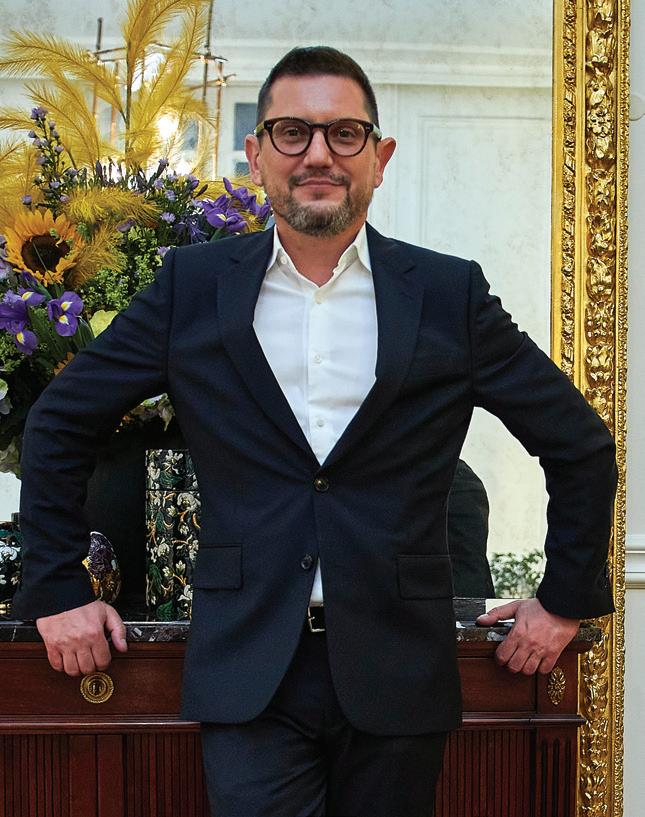 Martin Pietri, shown above, is a descendant of one of Napoleon’s furniture makers.
Martin Pietri, shown above, is a descendant of one of Napoleon’s furniture makers.
THE FOUNDERS OF SO IL TALK ABOUT STARTING A FIRM DURING A DOWNTURN, GROWING THEIR BUSINESS, AND WHAT’S IN STORE FOR THE FUTURE
Since founding their New York City-based architectural firm SO-IL in 2008, Jing Liu and Florian Idenburg have taken on projects around the world. Describing itself as “both locally rooted and nationless,” the firm’s portfolio includes a library in Cleveland and an art museum in Seoul, as well as interactive public installations and fashion showrooms. Clients include Google, Versace, and the Whitney Museum. Liu, 42, was born in Nanjing, China, attended high school in Japan, and got her architectural education in New Orleans at Tulane University. Idenburg, 47, grew up in the Nether lands and Colombia. They met in Tokyo, where Idenburg worked at the SANAA architectural firm for eight years. In June, Williams College announced that SO-IL had been chosen as architects of a new building for the Williams College Museum of Art on the college’s campus in Williamstown, Mass. Here they talk about their inspirations and designs and what’s next for their busy and growing firm.
What drew you to architecture?
jing liu: I was always artistically inclined. I also love engi neering and physics—the tinkling of things and understanding their inner workings. But above all I loved the cities, the history, and the culture of it all. I love learning about how a city became what it is and looking at them and imagining how they might evolve.
florian idenburg: What attracted me about the field was the way it combines artistry, technology, and society. It gives shape and form and experience to things that are happening in the world. At 16, I decided that this is what I wanted to do. Also, I have a distant family member, a great uncle of mine, Hendrik Petrus Berlage, who is considered the Frank Lloyd Wright of Dutch architecture.
You’ve always had your offices in Brooklyn, and you live there now. What do you like about Brooklyn?
The Amant Arts Campus in Brooklyn, N.Y., offers a residency program for artists, and is spread across three blocks in an industrial neighborhood. SO-IL designed the space from scratch.

liu: We live near the Brooklyn Navy Yard, and I just love it there. It’s one of the last remaining industrial and manufac turing neighborhoods in New York. The city of New York in general is very stimulating. You have people from all over the world, all walks of life, speaking so many different languages. That in itself keeps your brain working, as creative people.
idenburg: New York is the best place for two noncitizens to live. We love the diversity of Brooklyn, the vibes, as my daughters
Jing Liu and Florian Idenburg founded SO-IL together in 2008.

would say. We have many friends that are combined cultures, like us, and it’s a very attractive place for them.
How do you find working together as a husband-and-wife team?
idenburg: When you start a practice you have to invest a lot of time—archi tecture is very time consuming. We were starting a family at the same time, and it’s a similar investment of time.
Doing it together, it was easy to do these two things at the same time. But we do spend all this time together and you never really leave your job. Our daughters call it ‘archi-torture’ because we do talk a lot about work. But it works well for us.
liu: We know each other so well. Often we can complete each other’s sentences with only a few words. So that’s very efficient. We get a lot done together quickly. But when we don’t agree or can’t get on the same page with some
things, it also takes a lot of work to break out of our own pattern. But this is also productive because it keeps us critical of ourselves and you need that.
How has your firm evolved since you founded it in 2008?
idenburg: We launched our firm in 2008, when the Great Recession was just beginning. Half of the architects in New York lost their jobs and many firms closed. The beginning was hard. We were very frugal and nimble. We grad ually built up our name and reputation. Now people come to us.
Since 2008, the country has had a quite successful economy, and we’ve grown along with that. We’re now a 25-person firm. We do mostly cultural projects and we work all over the world—Australia, China, Korea, Mex ico, France, Portugal, Italy. Since Covid, there has been a new paradigm shift. A lot of our work is now local, which is very exciting.
liu: Over the last five, six, seven years, we’ve gotten more familiar with the U.S. market and how cultural decisions are made.
Speaking of local, your new Amant Arts Campus in Brooklyn recently won an award from the prestigious Mies Crown Hall Americas Prize. Tell us more about Amant and how it came to be.
idenburg: It took a while because we were building a new institution from scratch. Our client, Lonti Ebers, was noticing that it was becoming harder and harder for artists to spend time in New York. She wanted to create a residency program for artists, in which they have six months to work and think and slow down without having to produce anything, and they get a stipend and have a home in the city. It’s four buildings in an industrial area in Brooklyn’s Bushwick neighborhood. The campus is surrounded by large industrial buildings. Our challenge was to create a home and a welcoming place in this area. We linked the four buildings with an alleyway system that creates an oasis. We used a lot of green and exterior spaces to try to create interesting spaces within that environ ment. The campus also has three gallery spaces and a performing arts space, and there is a bookshop and cafe that is open to the public. I applaud what Lonti Ebers has done here. There are very few people who have the audacity to create cultural institutions from scratch.
What can you tell us about the new museum at Williams College?
liu: We have just started the process. We are doing a lot of workshops with the college’s various stakeholders in order to define the project ambitions. Williams is one of the country’s, and perhaps the world’s, top teaching museums, so the ambition is certainly very high and that’s very exciting. We hope to make the building and the design process itself a productive teaching tool for the future of cultural institutions. With the energetic con versations around equity, inclusion, and diversity, and the new knowledge emerging around climate change, there is so much that museums have to learn. We feel very fortunate to be working with Williams on these issues. I think by next year we will have something to share with the public.
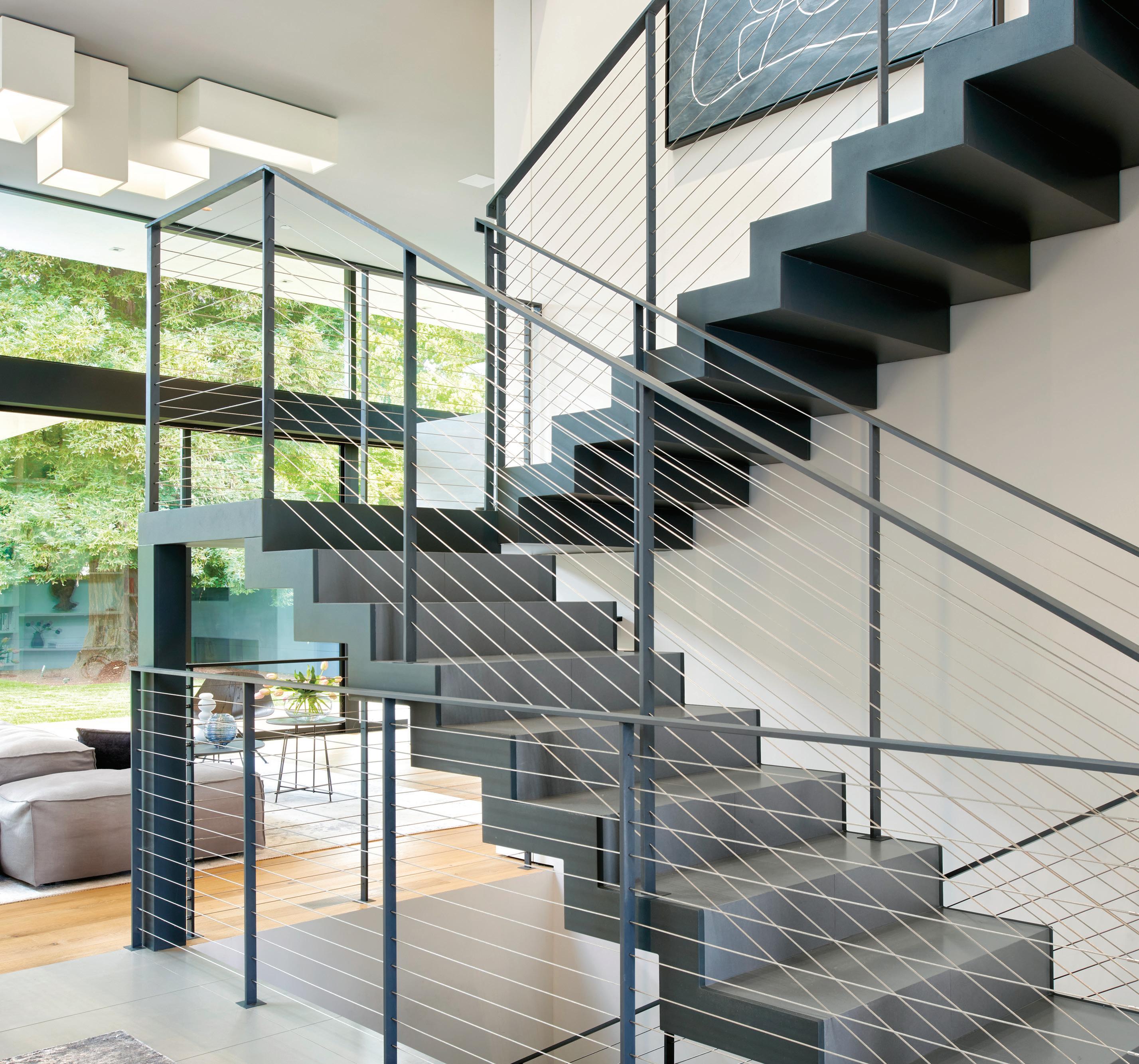


“You want the staircase to stand out by blending in, seamlessly ascending or descending through a home,” McNally says. “We often arrive at a helical design as it feels more organic than spiral; it’s less tightly wound than a circular form. That said, a lot of our plan forms are rectilinear to make the most efficient use of space, so straight runs can work well, too.”
An open tread floating staircase can seamlessly connect the house and lend a feeling of lightness, says Sarah Jefferys, founder of Sarah Jefferys Architecture + Interiors in New York.

You can also use glass to create the illusion of floating stairs with striking bronze hinges to hold the elements together, said Carleton Varney, presi dent of Dorothy Draper in Palm Beach, Fla., in an interview a few months before his death in July. The stairs are typically lit from underneath and will be noticed as they draw your attention inward and upward, he said. He also would opt for interesting wood types and patterns. “I like to take a cut of wood that looks like the inside of a tree, so you see the ring pattern on the stair riser edge,” he said.
in his designs, for its crisp, clean lines. The traditional-yet-contemporary feel of marble was utilized in a staircase his firm worked on in the lobby of the famed Carlyle Hotel in New York City.
McNally prefers natural textures, “as we find it’s the No. 1 way to improve a sense of wellness and quality in the home,” and juxtaposes two or more materials. Jefferys loves a mixture of steel and wood to create contrast.
On an engineered side of things, O’Donnell suggests using plywood to soften a space and give it an architec tural edge. “After all, there’s something inherently architect-friendly about ply; it’s a good, affordable way to help elevate a home’s aesthetic,” he says.
Adding elements such as runners, light ing, or paint can enhance the decorative effect. Runners, especially, add warmth, texture, and comfort and are an easy way to change a look. “A runner gives you the chance to add a long ascending (and descending) strip of personality,”
Opposite page: A floating staircase from California-based Mary Maydan of Maydan Architects. This page: An artful staircase designed by Sam McNally, co-founder of London-based Echlin.
Though its original purpose was purely functional, a staircase, in its most artful form, can become an inspired focal point, acting as an archi tectural sculpture. “A staircase is often the first thing you see when you enter a property. So, naturally, if it’s a beautiful amalgam of craftsmanship and engi neering, it’s going to make a great first impression and set the tone for the rest of the house,” says Ed O’Donnell, creative director and co-founder of Angel O’Donnell, based in London.
It’s the opportunity to create a design moment. “We always seek to turn the staircase back into a statement that underpins our design ethos for the project,” says Sam McNally, co-founder and design director of London-based Echlin. “We want to celebrate every square inch in our homes. Staircases are a great place to flex our design muscles, to impress guests, and to make everyday use a pleasure for users.”
The steps to inspired stairs start with know-how.
Railings are another opportunity to vary a design. “We love to play with many different materials when design ing our railings: wood, steel, horizontal, or vertical slats,” Jefferys says. “Cable railing and clear glass almost disappear to create a feeling of openness.”
Mary Maydan, principal and founder of Maydan Architects in Palo Alto, Calif., recently used metal screens with different designs as rails, and, in another project, thin strings of metal from floor to ceiling. She opts for metal rails on winding curved staircases, and metal as well as glass rails or stainless steel cables for straight staircases.
But Maydan always considers who is living in the home. “When our clients are families with young kids, we urge them to use continuous stairs and not ones where each tread is detached from the other, to play it safe,” she says. “The same considerations apply to the railing as well. When there are young kids in the house, we opt for cable railings over metal bars.”
MATERIALS MATTER Varney consistently utilized marble
O’Donnell says. “Runners can add bright splashes of color, bold geometric patterns, organic swirls, block colors, stripes—you can have so much fun with them,” he says. And from a practical standpoint, they protect stair treads and hide unwanted signs of aging when updating an older home, Maydan says.
Lighting is another way to create artistry and highlight the design. “Lin ear LEDs provide so many new ways for dramatic lighting effects. In our recent projects, we’ve integrated strips of LED lights to the bottom of each tread. It creates a beautiful effect,” Maydan says.
Jefferys prefers to highlight minimal staircases with accent cove lighting “to create a general glow as if the staircase is levitating separately from the supporting wall.” She often adds a statement pendant light above the stair case to enhance the design and create a focal point. McNally, on the other hand, always aims to make the most of natural light. “A skylight at the top of a staircase will be the best option,” he says.
A painted staircase is an easy way to add punch. “You could paint spindles in a subtly graduating color from light to dark in an ombré effect,” O’Donnell says. A contrasting, colorful handrail set against a more simply painted staircase can also added a surprising element.
From left: Photography by John Sutton; Taran WilkhuThis seaside smart home is meticulously appointed with immaculate attention to detail, and every top-of-the-line feature imaginable. The four-story, four-bedroom home boasts 4,767 square feet of luxurious living space and approximately 2,000 square feet of outdoor entertaining space that includes three rooftop decks: one with an impressive 360-degree view overlooking the city. Once inside, you will find a safe room, a climate-controlled glass wine room for 400+ bottles, an elevator, and a surround sound movie theater complete with eight leather power reclining seats and 4k Sony HDR projector.
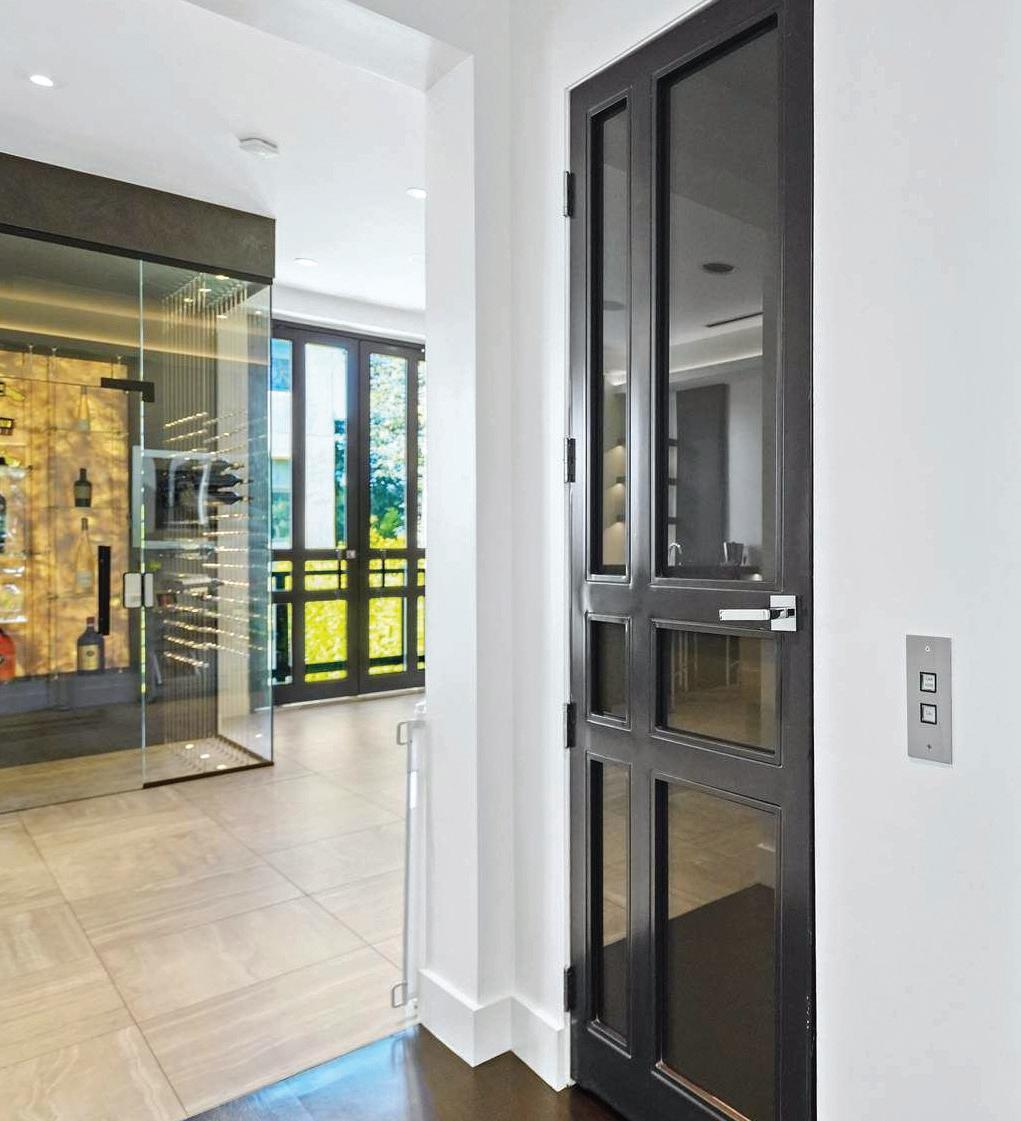

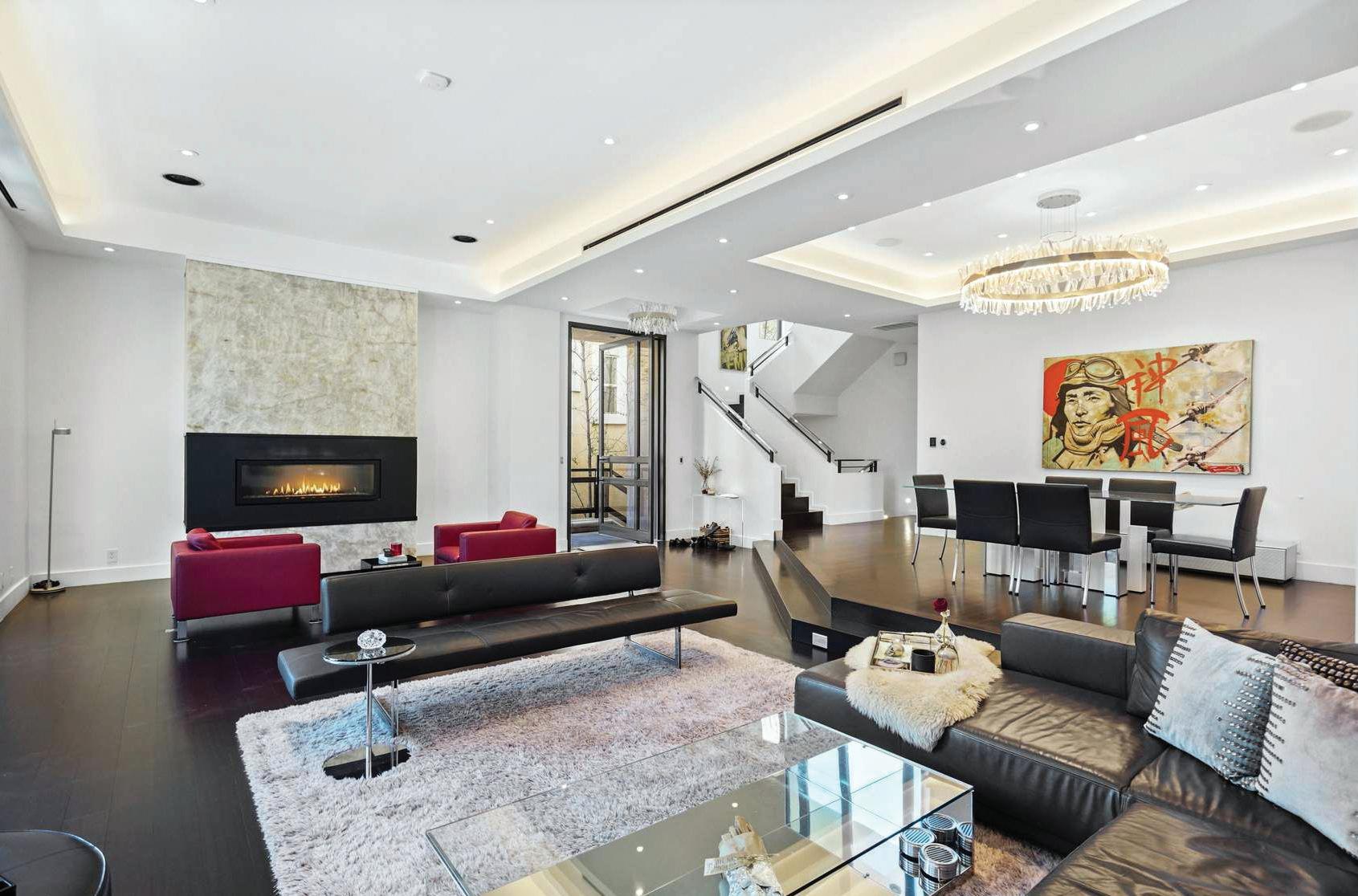

$6,395,000
Property ID: 2YC69T | sothebysrealty.com Sotheby’s International Realty— Pacific Palisades Brokerage Robert Radcliffe 310.317.9900
 By Marcelle Sussman Fischler
By Marcelle Sussman Fischler
No matter where you live, enjoying and relaxing in your surroundings is paramount. Advances in “smart home” systems far exceed your favorite Jetsons episode and help turn a home into a sanctuary.
“The appeal of smart technology, or smart living as we like to say, is really to elevate the comfort of living in luxury homes,” says Andres Klein, a founder of Maxicon, a custom smart home design and installation firm headquartered in Miami. “It makes our lives easier and brings experiences into our homes that without smart technology would not be possible.”
Gone is the need to worry about what’s happening in your Aspen ski house while you’re spending February in St. Barts or wonder when you’ve gone out for the evening whether the kids have turned off the television and gone to bed.
“Our customers have multiple homes in different countries and can monitor them using one app,” Klein says. Lighting, entertainment, thermostats, garage doors, pools, door locks, and gates can be controlled at the touch of a button or voice interface. Kitchen appliances and sprinkler systems can be added to custom scenarios.
“Today, there is a big push to bring in technologies like circadian lighting to try to replicate natural light in our homes from sunrise to sunset,” Klein says, tuning the single-tone inside lighting to be in sync. “During the day, sheer drapes move automatically to block the sun, and in the afternoon, we get these warmer tones which our bodies connect to and make us calmer.”
In the seaside community of Marina Del Rey near Los Angeles, a four-story 4,800-square-foot smart house with an elevator, an eight-seat home theater, and a trio of amenity-rich rooftop decks is “like an X-factor house. You have everything,” says Robert Radcliffe of Sotheby’s International Realty. Its LED lights are on a dimmer system programmed to come on at sunset, and the motorized shades close automatically.
In the kitchen, mood lighting is incorporated in a glasssided wine cellar with a backlit natural quartzite feature wall. Quartzite kitchen counters, a fireplace wall in the living room, and an onyx bathroom sink can be illuminated. Two-zone heated porcelain floors have Wi-Fi thermostats.
A 1,000-gallon rooftop hot tub with transparent Lucite
walls and a spillover effect has lights programmed to display a rainbow of hues. The deck’s wet bar, including a wine fridge, has four speakers integrated with the home’s voiceactivated 13-zone indoor-outdoor Sonos surround sound system.
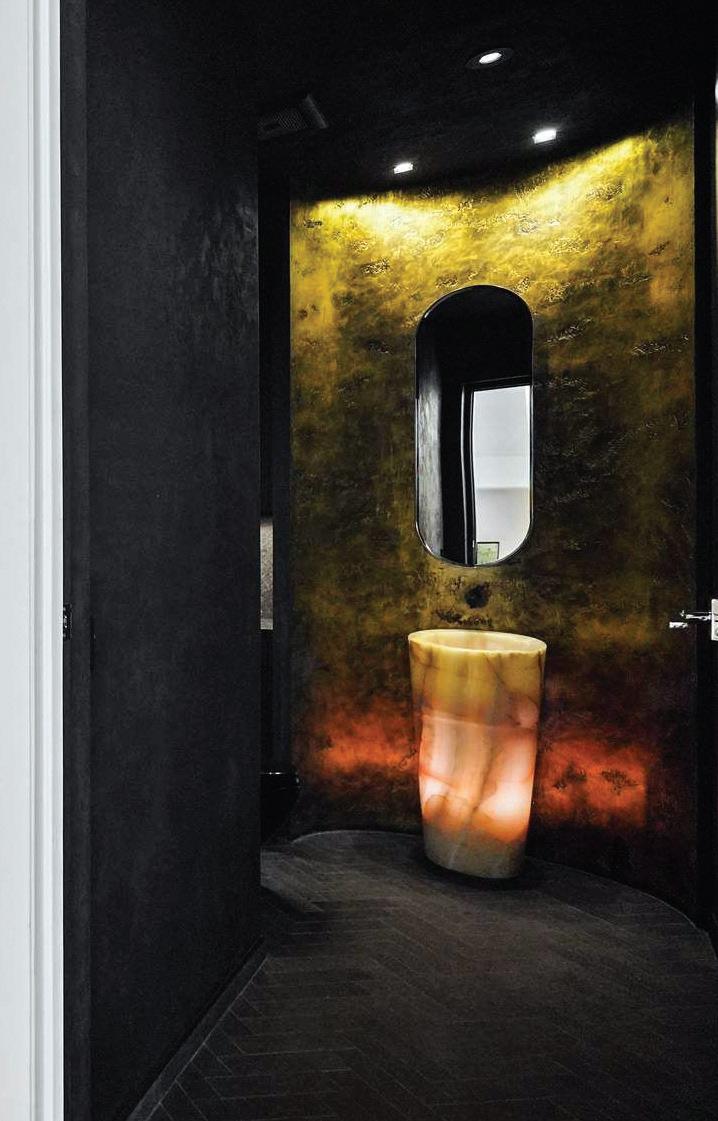
Security plays a significant role in the home’s automation, with video doorbells on the front and back gates, 21 cameras, an intercom system that can be answered from anywhere, a bullet proof safe room, four networked garage doors, and interior and exterior doors that can be opened remotely.
A fingerprint access control system determines who enters the wine cellar. “It’s not just a smart house,” Radcliffe says. “It’s a safe house.”
Intelligent home innovation extends further into wellness and safety, Klein says. Automated air- and water-quality controls filter impu rities and odors. New technologies help adult children remotely monitor elderly parents who live alone, too.
Peace of mind comes with a com prehensive smart house system. Smart plumbing signals leaks; HVAC systems send remote alerts if the house gets too warm or too cold.
Refrigerators prompt when it’s time to restock milk. Smart showers remember preferred temperatures and advise when the water is just right.
37 RESIDE FALL 2022 “A smart home is a more convenient home,” says Radcliffe. “It also provides you more comfort to enjoy a luxury lifestyle and more freedom to enjoy other things than needing to maintain miscellaneous home functions. There fore, investing in a ‘smart’ home is also investing in you.”

This award-winning, handcrafted piece of luxury does not leave any scars on the landscape. The level differences of the plot became part of the design and have led to playful spaces with slanting sides, unexpected corners, and large areas of glass that offer unrestricted views of the vast surroundings. Innova tion is recognized throughout the villa with state-of-the-art demotics such as motorized doors and curtains, including its 7.20-meter-high entrance door and the 6.30-meter-high terrace doors. Also, the exterior lighting and irrigation of the garden’s exquisite design with native vegetation are all programmable. Visiting this home will leave an exceptional expe rience featuring top-notch innovation of sustainability and intelligence.

€4,850,000
Property ID: DDF399 | sothebysrealty.com
VIVA Sotheby’s International Realty Juan Torregrosa, +34 971 721 000

The just-completed penthouse at The Pacific showcases large-scale rooms with soaring ceilings, light from windows on three sides, contemporary designs, and topline infrastructure—atop one of San Francisco’s most admired buildings. As one of the city’s largest condominiums, this five-bedroom, five-and-one-half bath penthouse spans 5,310 square feet while providing a palette of warm finishes rich in texture—from organic walnut millwork to undulating floors of travertine. As healthy living is the ultimate luxury, the penthouse delivers a rigorous wellness program with construction materials— from insulation to glue to paint—certified organic and toxin-free, delivering the purest, cleanest indoor air. Flooring in the northern bedrooms and windows throughout shield from external electromagnetic frequencies.

$19,995,000
Property ID: PXV8W2 | sothebysrealty.com
Sotheby’s International Realty— San Francisco Brokerage Gregg Lynn 415.595.4734
NEW YORK
A stunning, one-of-a-kind, designer residence in the most desirable Tribeca location, this full-floor unit offers lofty space, incomparable style, and sweeping views of the downtown skyline. This nocompromise home was gut renovated by Voorsanger Architects and built by Paolo Cassina, using only the highest quality finishes and bespoke design touches. With gorgeous Wenge floors, smart home automation, a built-in sound system, custom lighting, motorized shades, a multi-zone heating/cooling system, and large walk-in laundry room, this state-of-the-art home has every convenience imaginable.

$9,950,000
Property ID: TCX2Q2 | sothebysrealty.com
Sotheby’s International Realty— East Side Manhattan Brokerage
Kevin B. Brown 917.886.8850 and Craig George 917.886.4760

Situated on the bluff overlooking the Pacific Ocean is a stunning modern two-story home with four bedrooms and four full baths. The open concept interior living area flows into spacious outdoor patio areas with sweeping ocean views, thoughtfully curated architectural details and interior design that reflect a posh casual coastal lifestyle and a peaceful, inviting ambience complete with an array of luxurious amenities. Some amenities include Lutron Lighting and Savant AV control systems, full security system, custom pivot entry door with keyless entry, automated integrated Lutron window shades, and infrared heating. In addition, floor-to-ceiling Fleetwood doors and windows open onto first- and second-level heated outdoor patios that showcase the impressive views.

$13,995,000
Property ID: VHSG5X | sothebysrealty.com
Pacific Sotheby’s International Realty
Connie Pittard +1 619.733.6815

Impeccable new construction on the El Cid waterfront with exquisite attention to detail, every modern luxury, and unim peded water views. On a nearly 19,000foot corner lot, beautifully landscaped by Nievera Williams, this smart home is an elegant contemporary take on classic Palm Beach architecture with iron-look windows, handmade Mexican roof tiles, and waxed plaster walls. A 52-foot, twolane lap pool sits off the electric screened terrace. The three-bay garage fitted with two lifts can accommodate up to five cars and is complete with an electric vehicle charger.
$26,900,000
Property ID: VDWEKL | sothebysrealty.com

Sotheby’s International Realty Palm Beach Brokerage
Lisa Cregan 847.910.1303 and Christine Franks 561.685.5387
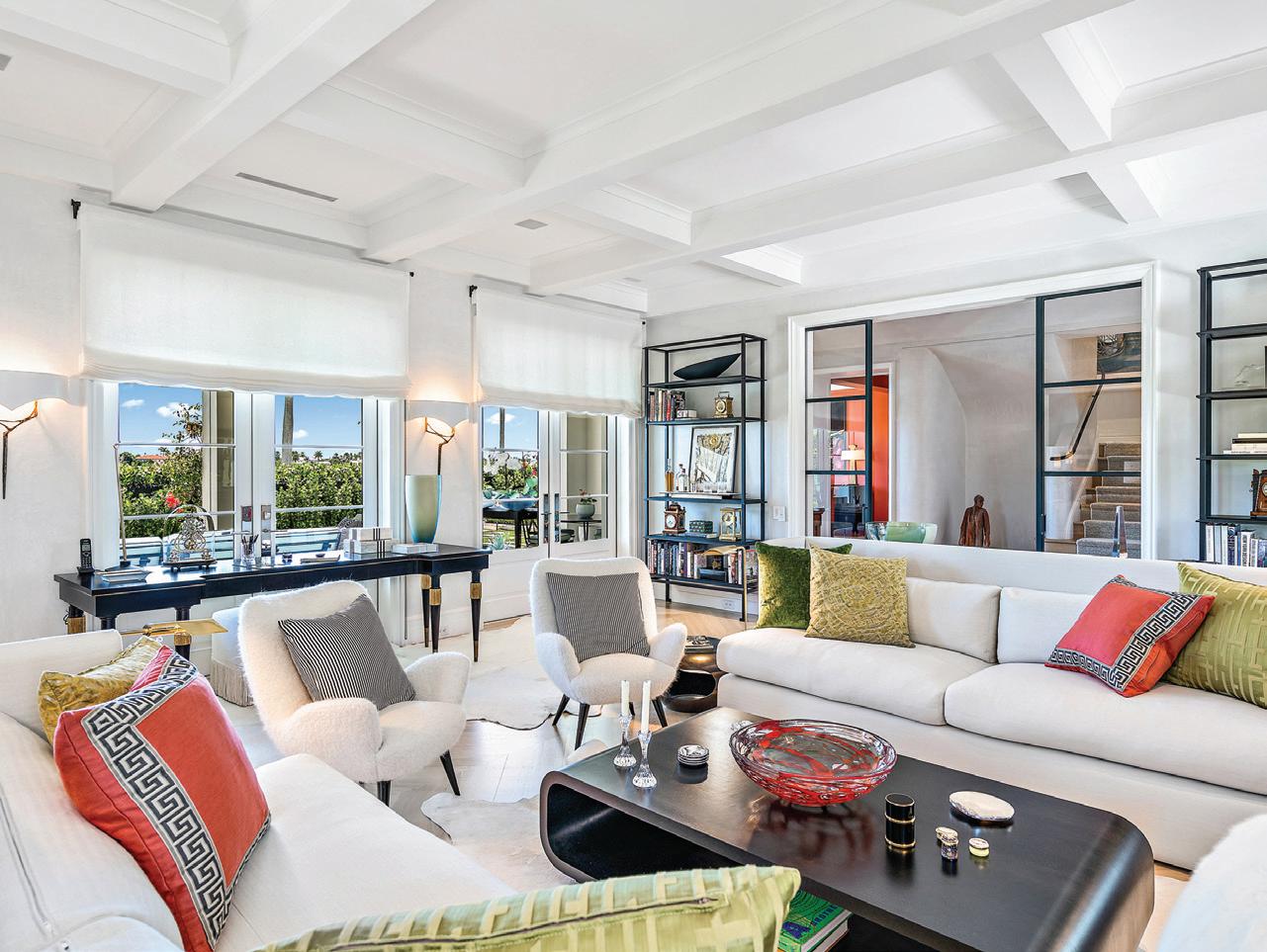 Sothebysrealty.com
Sothebysrealty.com

Auckland’s Herne Bay, the most expensive and exclusive suburb in New Zealand, is prized for its friendliness, its beaches, and its iconic grand estates.

It’s a close-knit community whose small-town vibe is so appealing that it’s not uncommon for properties to stay in the same family for generations.
“Everybody knows everybody here,” says Scarlett Wood, senior director of international business, New Zealand Sotheby’s International Realty. “People walk their dogs in the morning, head to local cafes and shops, or take beautiful beach walks.”
Herne Bay, which is named after the sea side resort in England’s County of Kent, is on the southwestern shore of Waite mata Harbor to the west of the Auckland Harbour Bridge. It’s what Wood calls “pocket size” small: According to the 2018 census, only 3,036 people are lucky enough to call it home.
Since its founding in the 1850s, Herne Bay has attracted well-to-do profession als, who built grand estates, complete with private jetties and boathouses that allow them to commute swiftly and in style to the center of town.
Sunrise in Auckland, looking north toward Harbour Bridge from Herne Bay.From left:
“Typically, people buy into Herne Bay and want to have land, space for children, and outdoor space,” Wood says. “They are business owners, senior corporate people, people in finance, in IT, and returning expats.”
The housing stock consists primarily of villas, many of which were built during the Edwardian age, which was from 1901 to 1914. They are defined by gracious rooms, high ceilings, wide hallways, large windows, and intricate detailing. Lot sizes, which are reflected in the price, range from 300 to 2,000 square meters.
“Many have retained the traditional exterior look with a complete makeover
NZ$3,245,000
Property ID: NZE11549 | sothebysrealty.com
New Zealand Sotheby’s International Realty
inside to reflect the best of both worlds, a mix of heritage and modern age,” Wood says, adding that “properties that have a dated house are also highly sought after as people are buying the land and taking on a complete rebuild job.”
Prices of entry-level residences start at NZ$3 million (US$1.85 million), Wood says, adding that the median property value is NZ$3.6 million. Prime properties, which come with larger lots and more architectural character, typ ically range from NZ$5 million to over NZ$20 million.

Townhouses and apartments, which are rare, also command premium prices. A brand-new two-bedroom townhouse generally will bring NZ$2 million, Wood says, and a three-bedroom townhouse typically will sell for NZ$3 million.
These housing options, Wood says, “tend to be popular with downsizers from local areas who enjoy the conve nience of lock-and-leave and want to stay in Herne Bay.”
“Herne Bay residents generally don’t move out of Herne Bay,” Wood says.
“Newcomers buy in Herne Bay because of its culture, location, easy commute, safety, neighborhood, and the people.”
The community is defined by what she calls “its own hospitality hub” on Jervois Road.
For luxury shopping , residents head
to Ponsonby’s Queen Street, which is 10 minutes by car, or to the designer fash ion boutiques of Newmarket, a retail district that’s a 15-minute drive away.
As its name implies, Herne Bay is a community that revolves around water and water activities.

“Many residents have their boats or yachts docked in Westhaven Marina, which is less than a five-minute drive away,” Wood says.
Herne Bay is also conveniently located. Residents can take a 15-minute drive to the helicopter base Heletranz to fly to Waiheke Island, which is known for its beaches and wineries, or to the Bay of Islands, a collection of 140 isles that offers pristine beaches, big-game fishing, Maori cultural artifacts, and the historic waterfront promenade of the 19th-century whaling port of Russell.
Many residents send their children to Bayfield School, a primary school. There are several other options in Rem uera, an affluent suburb 12 miles away.
For cultural activities, residents head to downtown Auckland. Attractions include Auckland Art Gallery, which has the country’s most extensive collection of national and international art; Auck land Town Hall, an early 20th-century building that has a concert hall for public performances; and the Auckland War Memorial Museum, which has exhibits and shows that focus on military history and natural science.
This 175-squaremeter townhouse in Herne Bay has three bedrooms and two bathrooms.
For Jennifer Wong and Peter Hamilton, spouses who started their careers in blockchain start ups and cryp tocurrencies, opening the Seattle NFT Museum, a space devoted to NFT (nonfungible token) digital art, was the perfect way to marry their love of art and technology.
“This is a place where art and technology come together in an incredible way,” Hamilton says of the museum, which opened in 2021 and is located two blocks north of Pike Place Market.
The couple are community-focused entrepreneurs who live in the neighborhood, too.
“We also realized that there wasn’t a place focused on education, curation, and community,” Hamilton says. “And that’s something we want to contribute to this ecosystem.”
And, while there are numerous galleries around the globe that display digital art in its many forms, Wong says this is the first-ever museum dedicated to NFT art itself. It’s also the first place designed to bring together artists, creators, collectors, IP owners, and the broader blockchain community.
“Creating a physical space to house digital art was very important to us,” Wong says. “There’s so much inter est in NFTs and NFT art from the general public and, while the average person may not search online to learn about NFTs, it’s easy for them to peek inside our door and learn about a new world of artists they may not have heard about before.”
 The Seattle NFT Museum hosts exhibits featuring influential artists and coveted collections. The space is also available for events, including live mintings, auctions, fundraisers, meetups, and more.
The Seattle NFT Museum hosts exhibits featuring influential artists and coveted collections. The space is also available for events, including live mintings, auctions, fundraisers, meetups, and more.
This is important to the founders because there are lots of misconceptions about NFTs, despite the fact that NFTs are making a historic impact on artists of every medium and practice, with a reported $25 billion in sales in 2021.
“We hope visitors to the museum learn that NFTs are a utility for artists to use and that they’re a means for art ists to connect directly to collectors in new ways,” Hamilton says. “Some have seen this as adversarial or juxtaposed against what artists are trying to do, but they’re really a great way for artists to build a global audience and distribute a digital work that doesn’t have to have a physical form.”
Added to the mission is a sustain ability component, and the founders feel they have a great opportunity to highlight some of the new and innova tive solutions to this issue.
“When you dig into the technol ogy behind NFT art, it’s important to address sustainability as a critical topic,” Wong says. “We wanted to high light this as part of the conversation
because we know there are so many art ists, nonprofits, and blockchains trying to solve the problem of energy usage.”
In fact, as Wong says, emerging technologies to make NFTs more energy-efficient are already developing. In addition, the museum is the first to apply to be a signatory of The Climate Pledge, which means it’s committed to net-zero emissions by 2040.
Beyond the exhibits, which feature influential artists and coveted collec tions, the space is also available for events, including live mintings, auc tions, fundraisers, meetups, and more.


For Hamilton, the exciting part is getting feedback from visitors.
“We have people coming through the space who are from all walks of life,” he says. “They might be avid contemporary art collectors, they might be stepping into the art world for the first time, or they’re just learning about NFTs. Either way, this is a wonderful place for anyone to engage with the technology and art represented at the museum—and learn a lot along the way.”
Guests to the museum include avid art collectors, NFT experts, and those just learning about both sectors. Hublot partnered with British artist Samuel Ross on the limited-edition 44mm Big Bang Tourbillon Samuel Ross.
Hublot partnered with British artist Samuel Ross on the limited-edition 44mm Big Bang Tourbillon Samuel Ross.
Opposite page: Hublot; this page: Maurice Lacroix (2)
While mechanical watchmaking is an art in and of itself, a handful of watch brands are collaborating with contemporary artists to bring a jolt of refreshing creativity to their collections.
More than a decade ago, Hublot launched its Hublot Loves Art initiative and has since partnered with a diverse array of contemporary artists, including American Shepard Fairey, French sculp tor and neo-pop artist Richard Orlinski, Japan’s Takashi Murakami, and Maxime Büchi, a London-based Swiss tattoo artist known as Sang Bleu.
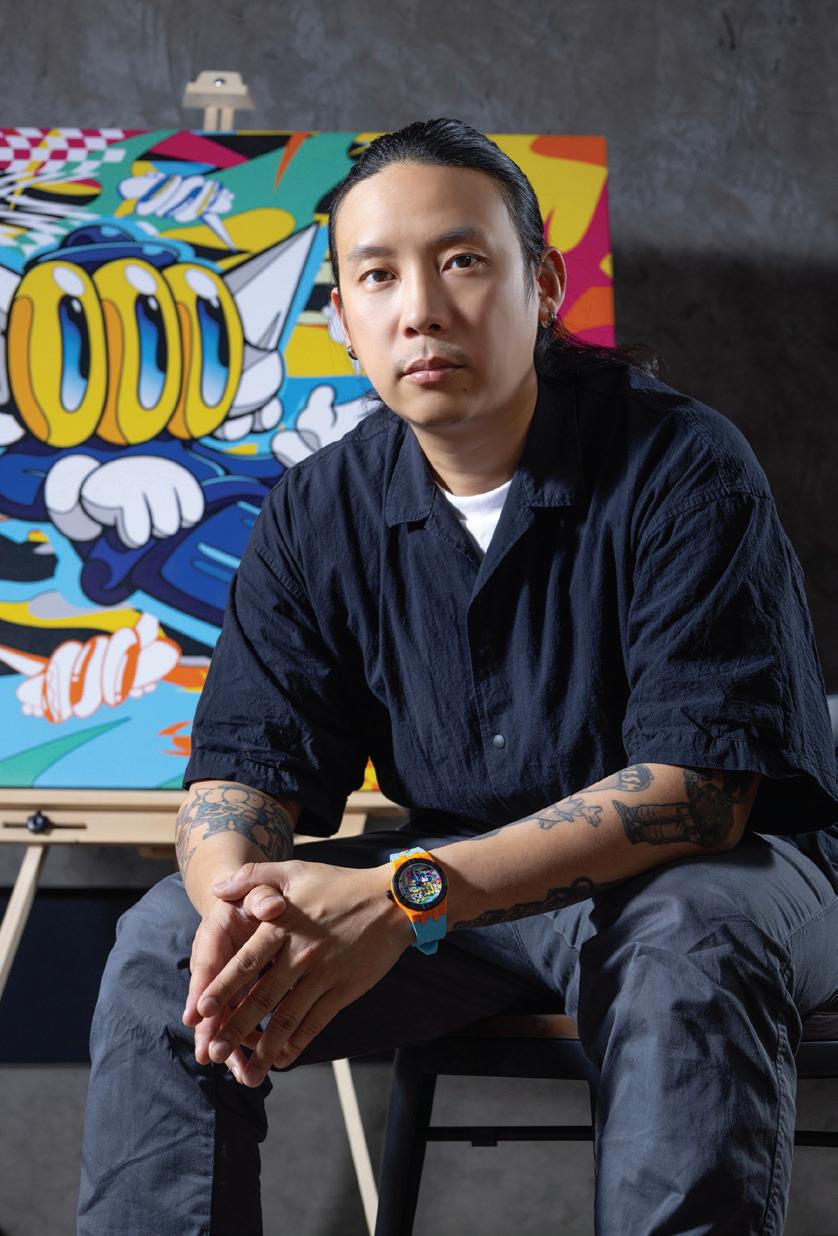
Following the launch of new pieces with Orlinski and Büchi last spring, Hublot unveiled its first collaborative piece with Samuel Ross, a 30-year-old British multi-disciplinary artist, filmmaker, and fashion designer.
After becoming an official brand ambassador in 2020, Ross unveiled REFORM, a sculpture combining the ancient, organic material of granite with modern, manmade steel, using both traditional hand-finishing and cuttingedge machining in an expression of fusion evoking Hublot’s 40-year legacy.
This year, that work was reinter preted in the 44mm Big Bang Tourbillon Samuel Ross ($116,000), limited to 50 pieces, exhibiting the artist’s signature use of color, stark geometry, and urban design influences. The stylized hexagonal case is embel lished with a titanium honeycomb mesh on the sapphire dial, case, case back and strap. Ross selected orange—a shade that represents energy and optimism— for the strap and accents to contrast with the gray satin-finished case and bezel.
Hublot’s LVMH sister brand Zenith recently followed up a rainbow-themed Defy 21 co-designed with Argentinian/ Spanish artist Felipe Pantone with the Defy Extreme Desert, created in partnership with acclaimed nature photographer Kourosh Keynejad.
Limited to 50 pieces, the Defy Extreme Desert ($22,000) takes its
cues from the barren desert landscapes captured by Keynejad’s lens. This artistic interpretation of the monolithic 1/100th-of-a-second chronograph in a 45mm titanium case has a symbolic flourish: the dodecagonal bezel and pusher protectors are made from falcon’s eye, a blue-gray opaque quartz gemstone named for the regal bird of prey that has accompanied desert nomads for centuries. The polished stone exhibits a reflective cat’s-eye effect that appears and disappears like a desert mirage, and makes each watch unique.
To accompany the launch of the Defy Extreme Desert edition last fall, Keynejad photographed a set of nine desert images taken in North America’s Great Basin, Mojave, Sonoran, and Chihuahuan deserts, exclusively for the brand.
Maurice Lacroix has taken a more casual, fun-loving (and affordable) approach with the colorful quartz AIKON #tide model with the Thai artist Benzilla. Though he studied fine and applied art at Bangkok University, Benzilla is best known for his playful, vibrant street art, which may come as a surprise since he is color blind.
The 40mm AIKON #tide Benzilla ($825) features Benzilla’s three-eyed alien character, LOOOK. The colorful artwork on the dial is framed by a black bezel and crown and an orange case fitted with a light blue rubber strap, which can easily be switched out with the brand’s Easy Strap Exchange system.
The Swiss watch brand has a longterm partnership with #tide, a company that specializes in upcycling plastic ocean waste. Plastic bottles—collected from the seas of Thailand, Indonesia, and the Philippines—are sorted, shred ded into flakes, washed, and compacted into smaller granules, which are used to create a novel plastic material. Sev enteen plastic bottles are upcycled to produce each watch, which uniquely fuses street art with sustainability.
 Maurice Lacroix collaborated with Thai artist Benzilla, shown at bottom, for the colorful and playful #tide Benzilla watch.
Maurice Lacroix collaborated with Thai artist Benzilla, shown at bottom, for the colorful and playful #tide Benzilla watch.
Once a novelty, plug-in hybrids (PHEVs) are now main stream and part of the lineup at most auto makers. Although they are transitional to the coming full electri fication, PHEVs offer a lot of advantages for auto buyers, combining useful battery range with quite a bit more from the on-board gas engine. Typically, they can travel 400 miles or more without being refueled.
AUDI Q5 PHEV
The Lexus NX 450H+ is a good choice for a smaller size SUV.

The plug-in hybrid format is well-suited to larger luxury SUVs, which tend to be heavy. As battery electrics, they would demand very big packs and longer charging times. PHEVs, even the larger ones, can carry small batteries and recharge in a few hours. The price advantage over full-battery cars may be temporary, but it’s there now. Here are a few choice luxury PHEV SUVs. It doesn’t hurt that most of them deliver exciting performance:
$51,695 WITH PREMIUM PLUS The all-wheel-drive five-passenger Q5 offers 362 horsepower with 369 pound-feet of torque, with 141 horse power coming from the electric motor. Electric range is 23 miles and, thanks to the turbo four-cylinder motor, it’s fast—zero-to-60 miles per hour in 4.5 seconds is possible. The battery pack was enlarged to 17.9 kilowatt-hours for 2022, and that helps improve the car’s MPGe (miles per gallon equivalent) rating to 61. The exterior styling is relatively anonymous, but the upscale
interior is crisply modern, with a large central screen and digital dash. A long list of optional features will quickly push this Q5 over the $60,000 mark. The Premium Plus package, which you’re going to want because it includes adaptive cruise control, lane-keeping, and a panoramic roof, is $3,900.
BMW X5 XDRIVE45E $65,700

This is a driver’s SUV, powered by a turbo inline six-cylinder and an e-motor that together produce 389 horsepower and 443 pound-feet of torque. In press testing, it achieved 60 mph in 4.7 seconds. Electric range is a decent 30 miles. Not quite as fuel-efficient as some of the other SUVs in this review, the BMW achieves 50 MPGe. As with the Audi, a well-appointed interior (with wood trim and SensaTec upholstery)
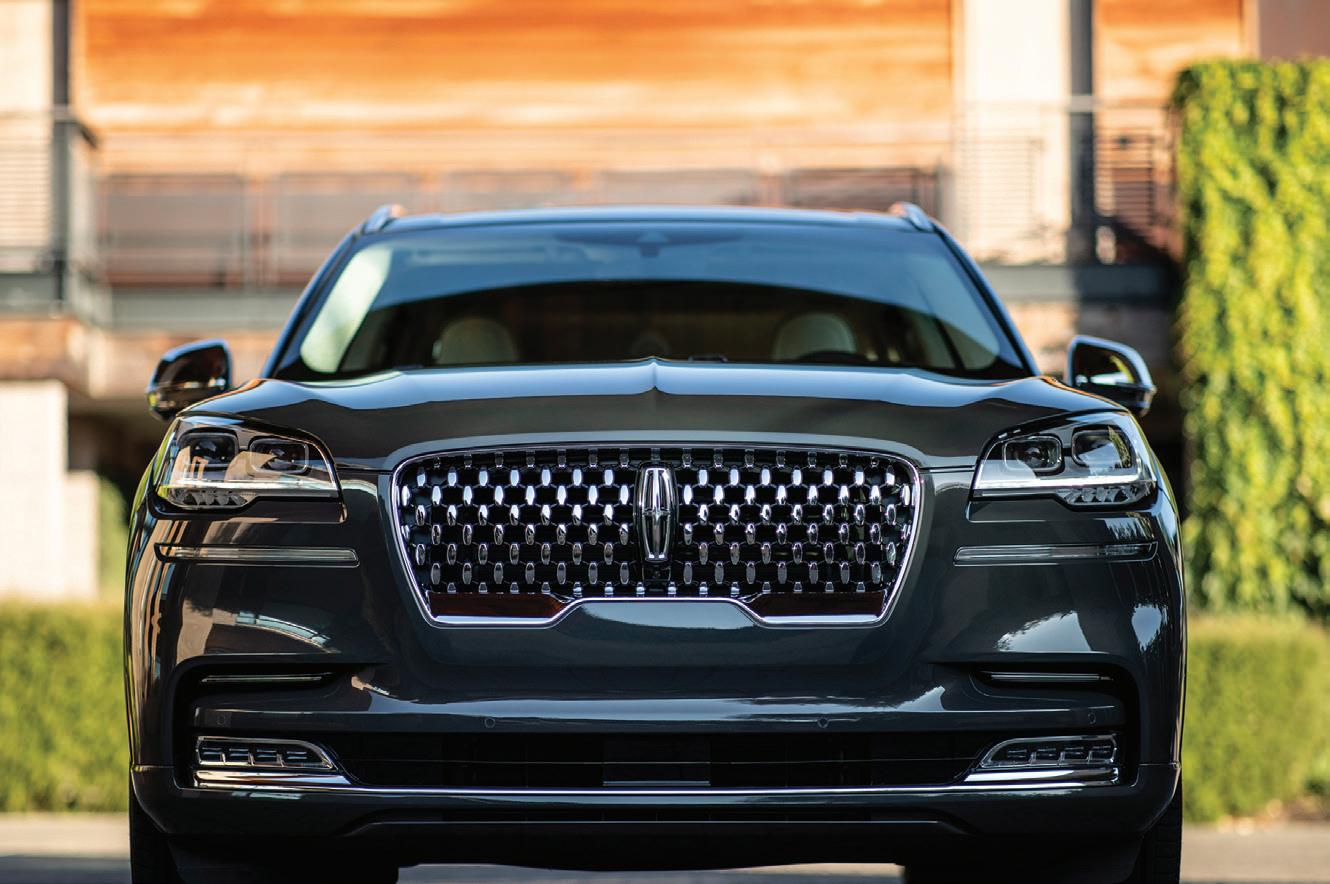
trumps the hard-to-find-in-the-crowd exterior styling.
JEEP GRAND CHEROKEE 4XE $58,465 Jeep had a runaway success when it added 4xe PHEV technology to the Wrangler, making it the most popular U.S. PHEV in the first quarter of 2022. That hastened the introduction of the upmarket Cherokee PHEV. The tworow midsize Cherokee 4xe sports a very luxurious interior. Options in the higher trims include a McIntosh 19-speaker audio and massage seats. The hybrid drivetrain produces a combined 375 horsepower and 470 pound-feet of torque, and features a turbocharged two-liter four-cylinder engine. Off-road ability is excellent, especially in the Trailhawk version. Electric range is 25 miles, with an EPA estimate of
56 MPGe. The Grand Wagoneer is likely to be soon available in a 4xe version.
LEXUS NX 450H+ $56,635
This upscale PHEV is based on another excellent car, the Toyota RAV4 Prime. Both vehicles offer 302 horsepower from a 2.5-liter four-cylinder engine. Zero to 60 takes an official six seconds in the 450h+, though some testers have gotten it to go faster. The Lexus doesn’t offer quite the Toyota’s 41 miles of EV range, but it does deliver an impressive 37 miles. The Lexus is a good choice if you want a smaller SUV—it’s competition for the Audi Q5 and Volvo XC60 Recharge, also considered here. The 450h+ has 22.7 cubic feet of storage. A 14-inch touch screen is optional, and dominates a nicely equipped luxury interior.
LINCOLN AVIATOR BLACK LABEL GRAND TOURING $88,520
With three-row seating for up to seven people and a length of more than 16 feet, this is a large and capacious PHEV SUV. The gasoline go-power is pro vided by a twin-turbo three-liter V-6, which combines with a 100-horsepower electric motor to produce a combined 494 horsepower with 630 pound-feet of torque. Electric range is 18 miles, and the MPGe rating is 56. Curb weight is a hefty 5,673 pounds. As expected for a car in this class, massaging seats are available, as is a 28-speaker premium stereo and leather. Standard features include soft-closing doors, active parkassist-plus, and rear-door sunshades.
VOLVO XC60 RECHARGE T8
EXTENDED RANGE $55,845
In its 2022 incarnation, the midsize T8 is capable of 35 miles of all-electric range— fairly good for a plug-in hybrid. (The range goes up to 41 miles in the sedanbased S60 Recharge.) The XC60 owner is buying both a very green electric car and a high-performance vehicle that offers 455 total horsepower (143 of it coming from the electric motor) and a huge 523 pound-feet of torque. It returns 63 MPGe, but also accelerates to 60 miles per hour in just 4.5 seconds. It’s a heavy vehicle at 4,758 pounds, but feels sprightly to drive. Yes, it’s a boxy Volvo, but the interior, with either cloth or Nappa leather, is a study in cool Euro design. There are advanced driver-assistance features, and of course state-of-the-art safety. The larger Volvo XC90 Recharge is also available, starting at $65,895.
The Lincoln Navigator Black Label Grand Touring, shown at top, has three-row seating for up to seven people. The BMW X5 XDrive 45e, shown below, has a particularly well-appointed interior.
A traditional Negroni features gin, Campari, and vermouth, but swapping in bourbon or mezcal for the gin can be a nice twist.

Mastering the mechanics of a favorite cocktail provides an innate sense of satisfaction. Your go-to is ready on demand without needing to go to the bar, and when it comes time to enter tain a few friends or host a dinner party, there’s an impressive welcome drink all queued up.
Now, you can take your mastery of the fine imbibing arts one step further by riffing on classics to produce fun twists.
This happens to be how much of the cocktail pantheon was constructed, after all. “That’s what we do, maybe 80% of all drinks began with substitutions or changes from classic drinks we already have,” says Andrea Delvo, the head bartender at the Renaissance Bar in Badrutt’s Palace, St. Moritz, Switzerland.
Consider the Negroni, an equal parts combination of gin, Campari, and sweet vermouth. “Well I love the Boulevardier, with whiskey instead of gin!” Delvo says. Indeed, switch in bourbon for gin and you have another classic on your hands. For a trendy, more modern adjustment, try a mezcal Negroni (sidebar) to add a sultry, smoky punch.
At San Diego’s Raised by Wolves, bartender Connor Fitzpatrick likes to riff on an Old-Fashioned with the sweet tones of rum, creating the Corn n’ Oil. “It’s an excellent blend of tropical flavors in every sip, performing a beautiful dance with strong ginger and spice,” he says. “I use Denizen 8 Year Merchant’s Reserve, which is not only one of my favorite rums, but also an extremely diverse bottle for most rum cocktails.”
At Badrutt’s Palace, Delvo created his 1956, a Manhattan riff with amaro in place of sweet vermouth and boosted with the alluring smoky notes of Lapsang Souchong tea. The flavors mimic peaty Scotch, but also nod to the drink’s namesake, the year Fidel Castro and company landed on Cuba amid an escalating revolution that would eventually distance the noted pleasure of Cuban cigar smoke from the palates of many connoisseurs.
When the creative mood strikes at home, consider a flavor-based approach and keep an open mind to what you might discover along the way. “I find exploration half the fun,” Fitzpatrick says. “Focus on your favorite flavors, and if you’re switching out something sweet, replace it with another sweet thing. Same for bitter items.”
For instance, besides his rum-based Old-Fashioned, you might be inspired to give tequila a spin in the drink. In this case, consider using agave syrup as the sweetener to align with those flavors.
Another simple entry point for at-home experimentation is splitting an existing ingredient with a new addition to push a drink forward without unrecognizably altering it. Perhaps it’s using half grapefruit and lime juice in that next batch of margaritas. Or try splitting the dry vermouth in a martini with sweet vermouth, and vice versa for a Manhattan, and you’ll create what’s known as the “perfect” martini or Manhattan.
Of course, the real perfect at-home cocktail is the one that best suits your own palate and preferences, and the path toward unlocking it should very much be an entertaining journey in addition to a rewarding destination.
by Wolves
This
A RUM OLD FASHIONED
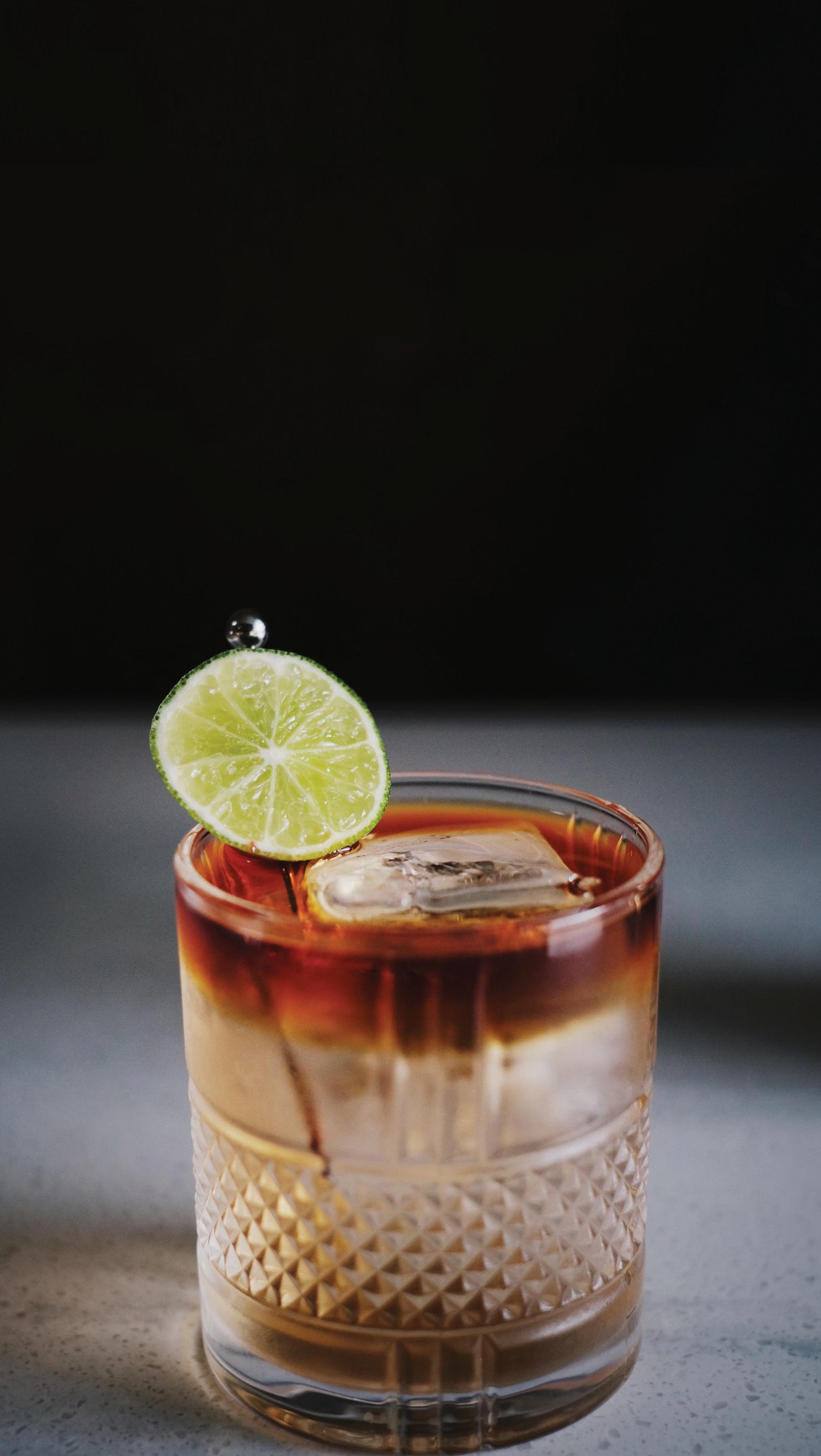
By Connor Fitzpatrick, Raised by Wolves
1.5 0.5 0.25 2
ounces well-aged rum
Fitzpatrick uses Denizen 8 Year Merchant’s Reserve ounce falernum ounce black strap rum Fitzpatrick uses Cruzan dashes Angostura bitters Lime peel
directions: Pour the rum, falernum, and bitters into a rocks glass with a large ice cube.
Cut a dime-size wheel off of the top of a lime with mostly peel but a bit of fruit.
Express into the glass, drop it in, and stir together.
Float the black strap rum on top of the drink by pouring slowly over the back of a spoon.
ounce mezcal ounce Campari ounce sweet vermouth Orange peel for garnish
directions:
Stir all ingredients well with ice, and strain into a rocks glass with fresh ice. Garnish with an expressed orange peel.
1 1 1 1.75 1 1
ounces rye whiskey Delvo uses Woodford Reserve ounce Ramazzotti or similar amaro teaspoon Lapsang Souchong syrup (See below) Orange peel for garnish
directions:
Shake all ingredients well with ice, and strain into a coupe or martini glass.
Garnish with an expressed orange peel.
LAPSANG SOUCHONG SYRUP: directions:
Heat 1 ounce loose leaf tea in a dry pan. Roast until aromatic, being careful not to burn. Add 1 cup water and 1 cup sugar, stirring until dissolved. Reduce mixture until thickened, and strain out tea. Store in the refrigerator.
As soon as you speak with Sara Clark, you’re instantly transported to a kinder, gentler place. That’s because this certified yoga and meditation teacher is an expert in helping all of us learn how to take a pause, especially when life gets hectic.

“There are so many distractions that prevent us from finding deep feelings of calm,” says Clark, who has practiced vinyasa flow and meditation for over two decades and leads workshops and retreats all over the world. “But the fact that we live in a culture that stresses multitasking means it’s even more important to find ways to destress.”
Here, Clark offers four ways to do just that:
BenjaminMost people have never been taught to breathe and spend most of the day in “shallow breath” mode, Clark says. “This drops us into fight or flight mode, our cortisol levels go up, and our body thinks we’re being chased by a bear on a primal level,” she says.
Next time you’re relaxed, tune into your breath, she suggests. “The beautiful thing is that the breath is one of our body’s autonomic responses that we can control,” she says.
“By training our mind to get on board with better breathing when you’re at your calmest, you’ll be able to access those same techniques when you’re stressed out.”
Clark’s Tips: Set a timer for two minutes and do a three-part breath. “As you inhale, allow your belly to expand, then your ribs widen, and your chest gently lifts, allowing the body to expand so your lungs can fill,” she says. “This is all on the inhale. Then hold your breath gently and, on the exhale, reverse it so you let the chest relax first, then the ribs, then the belly.”
2STAY IN THE PRESENT MOMENT AND DON’T JUDGE YOURSELF
It’s not easy to stay in the present moment when you have a long to-do list. However, if you start thinking “I’m not doing enough” or “I’m not good enough,” that’s when you need to do whatever it takes to stop the self-judgment, Clark says.
“To be mindful, stay in the present,” she says. “You’re not in the past or the future, you’re in the now.”
If you can do this, you can take a negative moment and transform it into something positive, she says. “Think of your thoughts as clouds passing by,” she says. “They’re going to shift, they’re going to change, and more will come.”
Clark’s Tips: Focus on being your own dearest friend.
“You have the opportunity to reword what isn’t serving you and what’s causing you stress,” she says. “Instead of saying ‘I’m not doing enough,’ you can say ‘I’m right on track,’ ‘I trust the process,’ and ‘I’m doing my absolute best right now.’ Try thinking of something a dear friend would tell you that you can tell yourself.”
Adding just one stretch a day will do wonders for your overall health, Clark says. “By taking the time to stretch, you’re actually creating a moment to pause,” she says. “You’re also lengthening everything from your neck all throughout your spine, into your glutes and hamstrings. It’s a good stretch for the body that you can do anywhere.”
And, because our bodies aren’t designed to sit all day, take regular breaks and do this easy Clark-recommended standing stretch that will help lengthen your spine:
Clark’s Tips: Keep your feet hip-width apart and bend your knees softly. Next, let your torso drape over your thighs so your head is lengthening down toward the ground. Make sure your legs remain bent and allow yourself to remain in this position for five to 10 breaths. If you prefer to do this while seated, simply drape your torso between your thighs while you focus on taking deep breaths.
If you’re anxious about the very idea of meditating, that’s OK, Clark says. “It’s not easy to sit and go within,” she says. “It can be really scary.”
So consider it a brave step to sit and be still.
“We’ve trained ourselves to have monkey minds where we jump from branch to branch and from thought to thought,” she says. “We can’t expect the mind to all of a sudden be silent when we decide to sit and meditate.”
That said, one way to start a meditation practice is to do it in the morning before you check in with the world.
And while an app can help guide you, meditation is really about tapping into your inner thoughts and reframing them.
Clark’s Tips: “Imagine your breath as energy because that’s what it is—we call it a life force or Prana,” she says. “By sitting with your thoughts and meditating, you will start your day in the most energetic way possible.”
THESE OILS LOCK IN MOISTURE AND GIVE YOUR SKIN DEWY, GLOWING HYDRATION
It wasn’t too long ago when face oils were taboo. But in recent years, with the input of dermatologists and expert estheticians, we’ve learned that oils are beneficial to a skin-care routine. No matter what type of skin you have— dry, normal, or oily—oils are crucial for locking in hydration, protecting the skin’s natural barrier, reducing fine lines, and promoting a healthy, dewy glow.
“There are many benefits to oil, but it all depends on what skin-care condi tion you are addressing,” says celebrity skin-care guru and esthetician Joanna Czech. “Oil dissolves oil, so any skin

type, including oily skin, can use them. However, it’s important to follow oil with a moisturizer, or mix a few drops of oil into your moisturizer to avoid dehydration.”
Face and body oils nourish the skin through high-quality ingredients, which might include naturally derived botanicals and essential vitamins, like vitamins A and C. Face oils support the lipidic layer, which protects our skin from environmental toxins and patho gens. Karyn Grossman of Grossman Dermatology suggests sunflower-seed, coconut, jojoba, argan, rosehip seed,
Opposite page: Monastery Skincare; this page, at top: Everyday Oil; bottom, from left: Vintner’s Daughter; Tata Harper; Symbiome
evening-primrose, and milk thistle oils, which provide antiaging properties coupled with barrier repair. Luckily, many of the luxury face and body oils on the market contain one or more of these naturally derived oils without parabens or synthetic filler ingredients.
“Most people think oils hydrate the skin, but they predominantly work by creating a barrier on the skin, prevent ing the skin’s hydration from escaping into the environment,” Dr. Grossman says. “Consumers also tend to enjoy the luxurious feel of oils.”
One of the first oils to make waves in the skin-care world was Vintner’s Daughter, in part thanks to Gwyneth Paltrow’s praise of the brand. Its Active Botanical Serum (which is actually a face oil) is formulated with 22 nutrientrich botanicals made via a proprietary infusion method. The oil has whole plants, brightening vitamins, balancing minerals, moisturizing fatty acids, and free-radical fighting antioxidants for radiant, healthy skin.

Other companies have followed suit. Symbiome’s sumptuous oils feature all-natural, bioactive-rich ingredients sourced from an organic farm in Brazil. Its ethos is centered on sustainability, like regenerative farming, reducing energy costs, less packaging, and give-back initiatives. The oils are created using a unique fermentation method to unlock and optimize the bioavailability of valuable nutrients and enzymes. Other oils,
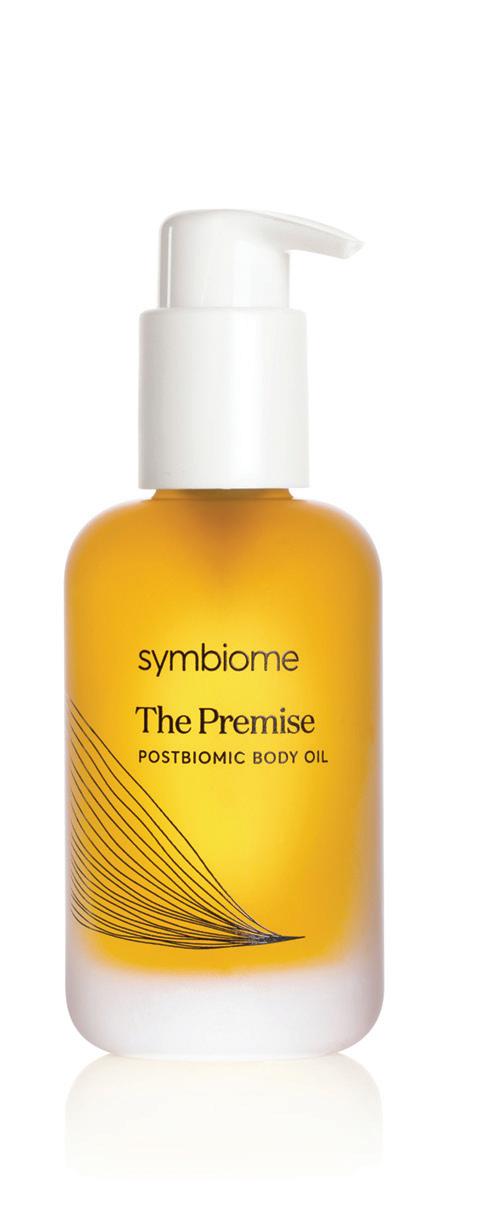
like Everyday Oil, which is an all-over body oil, take an even more simplistic approach by using 100% organic, plant-based ingredients, which include some of Dr. Grossman’s favorites, like organic coconut, jojoba, and argan oils, with essential oils like organic berga mot, blood orange, and patchouli for a tantalizing scent.

“Be careful with essential oils on their own as they can be active and irritating, and don’t use oils that are not made specifically for skin care,” Czech says.
It’s also important to look for oils that are formulated without parabens, chemicals, or alcohols. Monastery Skin care, with its luxurious look and feel, uses botanicals from around the world that have unique scents and properties to soothe and heal skin. Monastery’s Gold oil is made with sandalwood-nut oil, a medicinal oil from Australia, and raspberry, jasmine, plumeria, vetiver, orange, and rosewood to address dam age from the sun, irritation, dryness, redness, or puffy skin.
So how do you use an oil?
“To get the best out of your oil, you should use it at night over your moisturizer, preferably one containing
hyaluronic acid, glycerin or sorbitol, which are all humectants that draw water into the skin, or mix a few drops into your moisturizer for a lighter touch,” Dr. Grossman says.
Cult-favorite skin-care brands, like Tata Harper and Augustinus Bader, have created high-quality face and body oils to enhance your skin regi men. Created by a biomedical scientist who is an expert in stem cell biology, Augustinus Bader’s The Body Oil and The Face Oil use the brand’s patented TFC8 technology for firmer, stronger, and renewed skin. The oils address hyperpigmentation, cellulite, and fine lines. Meanwhile, Tata Harper, a 100% natural, nontoxic skin-care brand, has antioxidant and natural retinol face oils to help protect and clear skin. The body oil has antiaging properties and is meant to be used on the entire body or even through the ends of your hair to nourish damage and prevent fly-aways.

“It’s really important to treat the body as we do the face, so I would recommend using both,” Czech says. “There are some oils you can use on both, but generally speaking, use face oils on the face and body oils on the body for best results.”
Face and body oils nourish the skin, and more iterations are coming to the market all the time.
FROM CLASSIC DESSERTS TO SAVORY INVENTIONS, THESE DISHES DESERVE A PLACE ON ANY CULINARY BUCKET LIST
Apuffy, unadorned waffle—crisp on the outside, fluffy on the inside— provides a blank canvas that gives chefs endless options, spanning all flavors of the spectrum from sweet to savory. However you like it, seek out these topof-their-class waffles and you’ll develop an entirely new appreciation—waffles aren’t just for breakfast and brunch anymore.
Ask any waffle lover the top destina tion to prioritize, and they’ll inevitably point toward Belgium. From the casual shacks and stands that dot every town square to gourmet purveyors who have been drawing crowds for generations, Belgium is awash in waffle vendors, most of whom stay open throughout the day and into the evening to satisfy cravings for a hot-off-the-grill waffle.
First-time visitors might be sur prised to discover that in Belgium they generally have a choice between two styles. Some prefer the Brussels waffle, which is larger and rectangular in shape, with a light interior, crispy exterior, and a sprinkling of icing sugar. Others are loyal to the smaller, more plump Liège waffle, which usually has caramelized corners and beads of sugar melted into its dough, yielding a sinfully rewarding crunch with every bite.
Top contenders for the unofficial waffle crown in Brussels include the Waffle Factory, which serves meat-stuffed “lunchwafs” with Provençal herbs just steps away from the iconic Manneken Pis statue; Mokafé, a small cafe nestled in the King’s Gallery; Maison Dandoy, an old artisanal biscuit shop in the city with a lovely tearoom; and Pardon Brussels, which delights trendy crowds with toppings such as candied fruit, fresh herbs, and cured meats.
Homemade honey butter and seasonal jam come alongside the famed waffles at iconic Chicago restaurant The Publican.
New York’s historic Harlem neighbor hood lays claim to being the original home of chicken and waffles. A trio of notable Harlem eateries specialize in authentic, down-home plates of
chicken and waffles: Melba’s is a soulfood stalwart famous for its eggnog waffles, which have a rich and nutty flavor; Sylvia’s is a neighborhood institution renowned for its take on classic chicken and waffles (best paired with the weekly Sunday gospel brunch with live music); and Amy Ruth’s has won national recognition for its waffle menu, with each dish named after local celebs and dignitaries.
From its origins in the heart of Greenwich Village, the Frenchaccented Buvette has expanded glob ally, bringing its buzzy “gastrothèque” creations to London, Paris, Tokyo, and—with its newest location having opened in late 2021—Mexico City. One constant across all its outposts is its duo of mouthwatering buttermilk waffle dishes. Traditionalists opt for the Belgian buttermilk waffle with jam, berries, and crème fraîche, while heartier appetites prefer the Instaworthy waffle sandwich, filled with a sunny-side egg, bacon, and cheese in between one halved waffle, dripping with butter, bacon fat, and maple syrup.
One of Chicago’s culinary stalwarts, the James Beard Award-winning Chef Paul Kahan, serves one of America’s most lauded waffles at his iconic restaurant, The Publican. A vision of simplicity executed flawlessly, Kahan’s signature waffle—served with homemade honey butter and seasonal jam—has been a weekend brunch staple for years. Born out of a Belgium trip to study up on farmhouse fare, Kahan and his team perfected a Liège-style yeasted recipe. In response to demand from fans living outside of Chicago, the waffle mix can be shipped nationwide via Goldbelly.

Located in the heart of the Hollywood action on Sunset Boulevard, The Waffle has become a neighborhood staple over the past 15 years for its retro, dinerlike environs and inspired culinary inventions. The kitchen bakes
Opposite page: Courtesy of Aysegul D. Sanford; this page: Courtesy of Buvette
From its origins in New York’s Greenwich Village, Buvette has expanded around the world, bringing its popular buttermilk waffles with it.everything from raisins and walnuts to bacon and jalapeños directly into the waffles. Signature varieties include red velvet, blueberry lemon, and strawberry cheesecake, and for those looking to splurge there’s a chive waffle topped with cream-cheese dill sauce, capers, red onion, and smoked salmon.
For a more refined waffle option, Angelenos head to one of the city’s toniest hotels, The Peninsula Beverly Hills. The Belvedere, the hotel’s California-style brasserie, attracts seeand-be-seen crowds for one of SoCal’s most luxurious weekend brunch options. While the $99 poached egg parfait with white sturgeon caviar appeals to celebratory types, it’s the kitchen’s take on fried chicken and waffles that sets heads turning. The sweet tea-brined chicken impresses, but it’s the pillowly gourmet waffle, topped with spicy Cholula butter, that’s the star of the show.
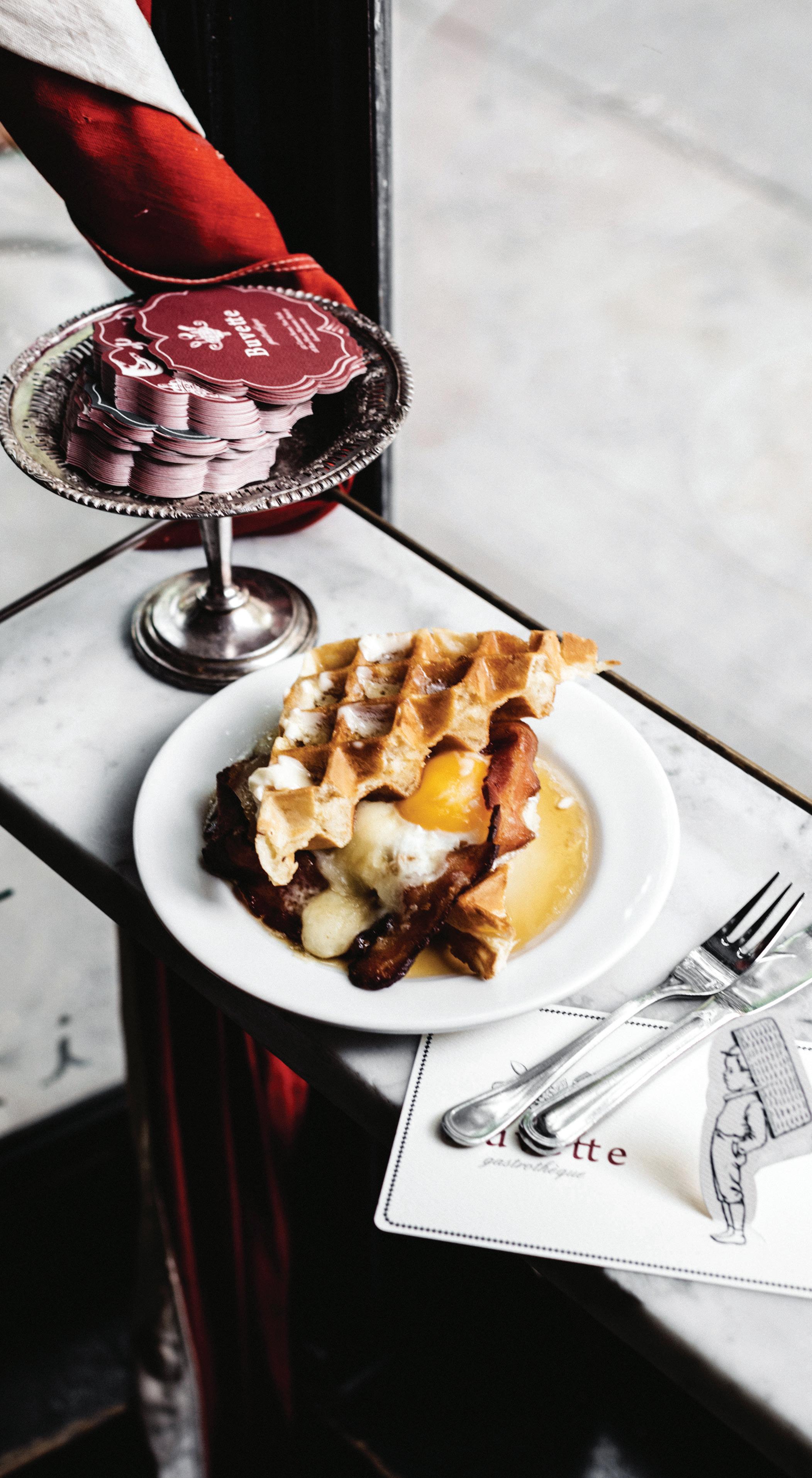
L.A. is also home to one of the most famous, and influential, vegan restaurants in the world: Crossroads Kitchen. Countless diners, including plenty of meat eaters, swear by Cross roads’ take on traditional chicken and waffles, with crunchy plant-based “chicken” and delectable housemade waffles getting a sweet kick from warm maple hot sauce.
One of the world’s most scenic waffle spots can be found at an elevation of 10,450 feet, high above the Jackson Hole Mountain Resort. A visit to Corbet’s Cabin for its Top of the World waffles is a culinary rite of passage.
This year-round operation is perched at the top of a mountain, serving as a memorable hangout for skiers and winter-sports aficionados. Heated on a vintage wood stove, the waffles are espe cially light, thanks in part to the altitude. After devouring a hot and steamy waffle topped with bacon and peanut butter, adrenaline junkies can burn off the calories by zooming down a world-class ski run.
UPGRADE YOUR FREE TIME WITH THESE HIGH END SETS
 London-based artist Alexandra Llewellyn is known for ultra-lavish, handcrafted pieces, including this poker set.
London-based artist Alexandra Llewellyn is known for ultra-lavish, handcrafted pieces, including this poker set.
Board games are often relegated to a TV cabinet or drawer, but with the right version of your favorite game, they can act as a stylish piece of decor. From leather-lined backgammon sets to hand-painted poker boxes and sump tuous shagreen game kits, luxury purveyors are able to turn game boards into something chic, customized, and totally luxe. A luxury game set encourages people to spend time together in their favorite rooms at home. For your next game night, consider one of these ritzy pieces as you cozy up next to a roaring fire or an outdoor patio table at sunset for some friendly competition. You’ll want to keep these games out well after you’re done.
London-based artist Alexandra Llewellyn is known for her ultra-lavish, handcrafted backgammon boards, poker sets, and table games. Using the finest materials with sustainable origins, Llewellyn specializes in marquetry and beautiful hand-painted scenes. She’s even collaborated with luxury brands, including boutique hotel Eden Rock St Barths and fashion giant Net-A-Porter. The Jungle Poker Set ($24,380) was created with more than 1,000 pieces of individually cut wood and depicts a charming jungle scene. Within the euca lyptus wood box, there’s everything you need for a traditional game of poker, as well as four secret compartments (with a key that unlocks them) and 500 traditional clay poker chips made by the oldest poker-chip maker in the U.S. Polished brass hinges and leather-handled trays solidify this gorgeous creation. You can even request a private, handwritten message engraved on the inside of the box.
Entrepreneur and beauty heiress Aerin Lauder created a global luxury lifestyle brand based exclusively on her fabulous personal style, and her company, Aerin, is the embodiment of all things elegant and timeless. From sophisticated home decor to lighting, fashion, and beauty, you’ll find everything you need under one umbrella. Embossed shagreen is a fabric Lauder’s known for using across many categories, including games. For an all-in-one luxury games piece, the Classic Shagreen Game Set ($4,500) contains five games crafted from mappa burl wood, brass, walnut, maple, and rosewood. It’s feminine, trendy, and looks great on a shelf or tabletop.
Beloved childhood games never stop being fun, but Linley’s Games Compendium, Monopoly, and Clue ($4,750) elevates the gaming experience. This double-sided games board features Monopoly on one side and Clue on the other. Each board is made from the finest leather, while the base is made from stained-gray rippled sycamore with sycamore and walnut stringing. The boards are even stackable with other compendiums, like double-sided backgammon and chess and Scrabble and Trivial Pursuit. They can be stacked together for a chic look in your living room—plus it’ll keep you (and the kids) off your screens for a solid period of time. There’s also a games stand made exclusively for this set.
From textiles to furniture to decor and beyond, Armani/Casa is a natural extension of fashion brand Giorgio Armani’s cre ativity. Armani/Casa designs homes, superyachts, and private jets, but even if you don’t have interior-design needs, you can buy a piece of his vision. This Italian-made Fair Chessboard ($10,910) is designed to fit on the Oreste table and comes in black and white, as well as wenge wood and gold leaf, with a metal Giorgio Armani signature on the border. It comes in a svelte wooden box, with pieces housed in a sumptuous gray tray, and will entice you to play over and over again.

Baccarat brings its glamorous touch to a classic game. The Tic-Tac-Toe Board ($1,950, available at Neiman Marcus) features beautiful crystal butterfly pieces in lieu of the traditional Xs and Os. It has a mirrored nine-square board with blue and clear crystal butterflies that appear as though they’re ready to take flight. It is made in France, like Baccarat’s gorgeous chandeliers, tableware, and light fixtures, and can even be customized in other colors to match your home and taste.
Backgammon is one of the stackable games available via Linley’s Games Compendium, shown at top. The Baccarat Tic-Tac-Toe Board, shown at bottom, features crystal butterflies in place of the classic Xs and Os.
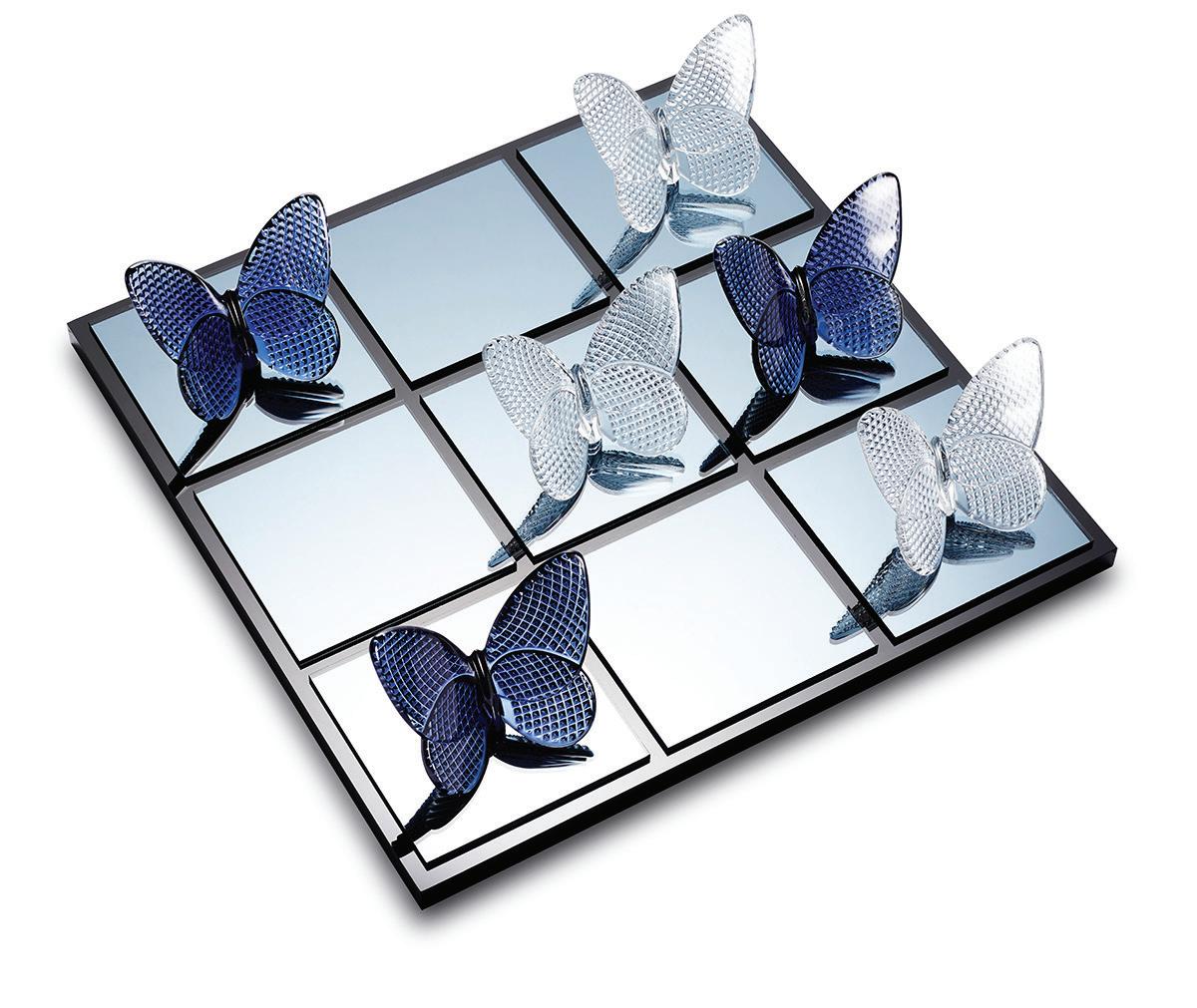

Peter Kuper’s career has been nothing if not varied: The illustrator and cartoonist has published adaptations of fiction by Franz Kafka, original graphic novels, books for children and adults, and regular comic strips for MAD maga zine, among other works.
Now, he’s taking a deep dive into what has been a lifelong interest: entomology. Kuper is at work on an upcoming book on insects, and his research and art on the subject is featured in a major exhibition, called “INterSECTS,” at the New York Public Library. The exhibit was inspired by Kuper’s stint as a Cullman Fellow at the library, which allowed him uninterrupted study and access to the institution’s considerable resources.
“The pandemic extended the time I could be there, and the library was closed to the public. As I learned about the history of insects and the entomol ogists who studied them, I wandered the halls of this postapocalyptic, empty library, and the library itself became the perfect framing device,” Kuper says.
The exhibit, which features images from Kuper’s forthcoming graphic novel, imagines insects occupying the vast, vacant halls of the historic building. This isn’t his first time incor porating a fascination with arthropods into his work: His graphic novel, Ruins, for instance, tells the story of a couple on sabbatical in Oaxaca, while also touching upon the annual migration of monarch butterflies from Canada to Mexico.

Kuper says he feels a responsibility to reveal the hidden world of insects: “My intent is to get people to look down and watch where they step,” he says. “I don’t like getting bitten any more than the next person, but what insects do is positive. Without them, we literally won’t survive.”
But this is just one of many topics and styles that he’s been drawn to over his career.
“Sticking to one style doesn’t have an appeal to me,” Kuper says. “I can be prolific because I’m inspired by the choices I have, and feel an urgency to get things down on paper.”
Here, the artist shares some of his favorite graphic books and comics, themselves wide-ranging in subject and form.
From left: Holly Kuper; Courtesy of Peter Kuper/New York Public Library; opposite page: Courtesy of Peter Kuper/Originally appeared in the New YorkerMcCay did early comic strips at the turn of the century, and accomplished amaz ing things with the form. As a teacher, I’m always going back with my students to early work like his. There are a lot of formal lessons you can take from these. In his day, McCay’s comics would show up in the Sunday newspaper and take up a full length of newsprint, and he’d do remarkable things with that space. Today, artists like Chris Ware follow this kind of model for magazines like the New Yorker, creating really interesting stories.
 SAFE AREA GORAŽDE BY JOE SACCO
SAFE AREA GORAŽDE BY JOE SACCO

Sacco is a journalist who creates comics about places affected by war. This one, about the Bosnian War, came about after he spent time there [in 1995 and 1996]. He goes into these war-torn places and then does amazing comics about them.
HERE BY RICHARD MCGUIRE
This book focuses on a single point, a patch of land, and moves backward and forward through time. We visit the same spot 4.6 billion years ago and then zoom to 1955, where we see characters sitting on their couch at home. There are conversations that take place in a disjointed way over the years, and at the same time, in a corner of the room, there’s an image of a Native American standing in a field in 1915. It’s a brilliant way of capturing simultaneity.
FLOOD! BY ERIC DROOKER
Flood! is an epic story that is entirely wordless, taking place in New York City and touching upon politics and society. I’ve always been interested in art that is wordless, like Charlie Chaplin’s Modern Times, for the ways in which it can be so funny and political without using any dialogue. It crosses all international borders that way.
 PERSEPOLIS BY MARJANE SATRAPI
PERSEPOLIS BY MARJANE SATRAPI
Persepolis was initially banned in differ ent places [including some U.S. school districts], which of course made it shoot to No. 1. It’s autobiographical—I love graphic novels that are close to being true stories and can open the door on history in that way. Satrapi not only has an incredible facility for storytelling, but also has a story that is worth telling.
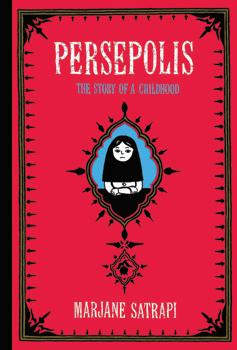 Peter Kuper’s “I Told You So” appeared in the New Yorker.
Peter Kuper’s “I Told You So” appeared in the New Yorker.
THESE GADGETS WILL MAKE ALMOST ANYONE MORE OF A MORNING PERSON
Some folks just aren’t made for mornings. For those who need a little extra time to get going, here are some high-tech gadgets to make things a little easier.
The June smart oven, shown above, can get you from morning to night, since it acts as toaster, broiler, grill, air fryer and more.
Nothing says morning like that first cup of Joe. Whether it’s an Americano, a macchiato, or a double-shot espresso, the hard-working deluxe Miele CM 7750 CoffeeSelect will help set your day in order, right from that first sleepy stumble into the kitchen. It offers 20 on-demand drink specialties at the tap of a button, and it sits right on your countertop. Its innovative grinder system grinds the beans fresh for each order, and the CM 7750 features three
separate bean containers to ensure that your order will be prepared just right. Miele’s WiFiConn@ct technology allows owners to operate and monitor their machine remotely from their smartphone. And the Miele CM 7750, which is available for $5,999, has a descaling process that automatically prevents the buildup of limescale.
The June smart oven is a space-saving 12-in-one device that can serve as a toaster, a broiler, a grill, a convection oven, a slow cooker, an air fryer, a roaster, a pizza oven, and more. And it’s not much bigger than a microwave. Internal cameras allow the oven to automatically recognize whatever food

you are preparing as soon as you pop it into the oven, and to provide a variety of cooking options immediately. You can take complete control of the cooking process, or just let the smart oven take care of it all. It’s available for $599, $849, or $999, depending on features, and it will notify you via app when dinner is ready.
The stylish Vitamix Ascent Series A3500 blender features five program settings— including a self-cleaning feature—that allow users to create smoothies, hot soups, dips and spreads, and frozen desserts. The blender will automati cally adjust to the container size you’ve selected, process your recipes, and stop the blender when complete. Touch screen controls give the machine a sleek silhouette and offer easy cleaning, and a programmable timer is also included. Built-in wireless connectivity will allow the A3500, which is available for $599.95, to evolve with the latest innovations for years to come.
Slim, handsome, and easy to handle, the Colgate Hum features a small brush head that can reach the far corners of your mouth without any discomfort. Its companion mobile app tracks your brushing and shows you spots you’re missing. Your brushing sessions are stored on the brush for 10 days and then get uploaded to your phone when you open the Hum app. If you don’t have a free outlet in your bathroom, there’s a version of the Hum, which is available for $70, that takes two AAA batteries.
The Moda One Smart Ionic Hair Dryer features sensors that measure hair mois ture levels and air temperature more than 20 times per second, and then the dryer automatically adjusts heat and airflow to prevent any heat damage to your hair. Advanced ion concentration technology releases millions of negative ions as the hair dries to seal the hair cuti cle for increased shine and manageability. You can connect your smartphone to the Moda One app for preprogrammed drying modes that include manual, cool, pet, kids, and eco mode. The Moda One dryer is available for $299.
Fabulous and famous: 27 Robledo Drive in Dallas, a Montecito-inspired stunner with spacious living areas and charming courtyards, has been featured in Traditional Home magazine. It is represented by Joan Eleazer of Briggs Freeman Sotheby’s International Realty for $7,995,000.
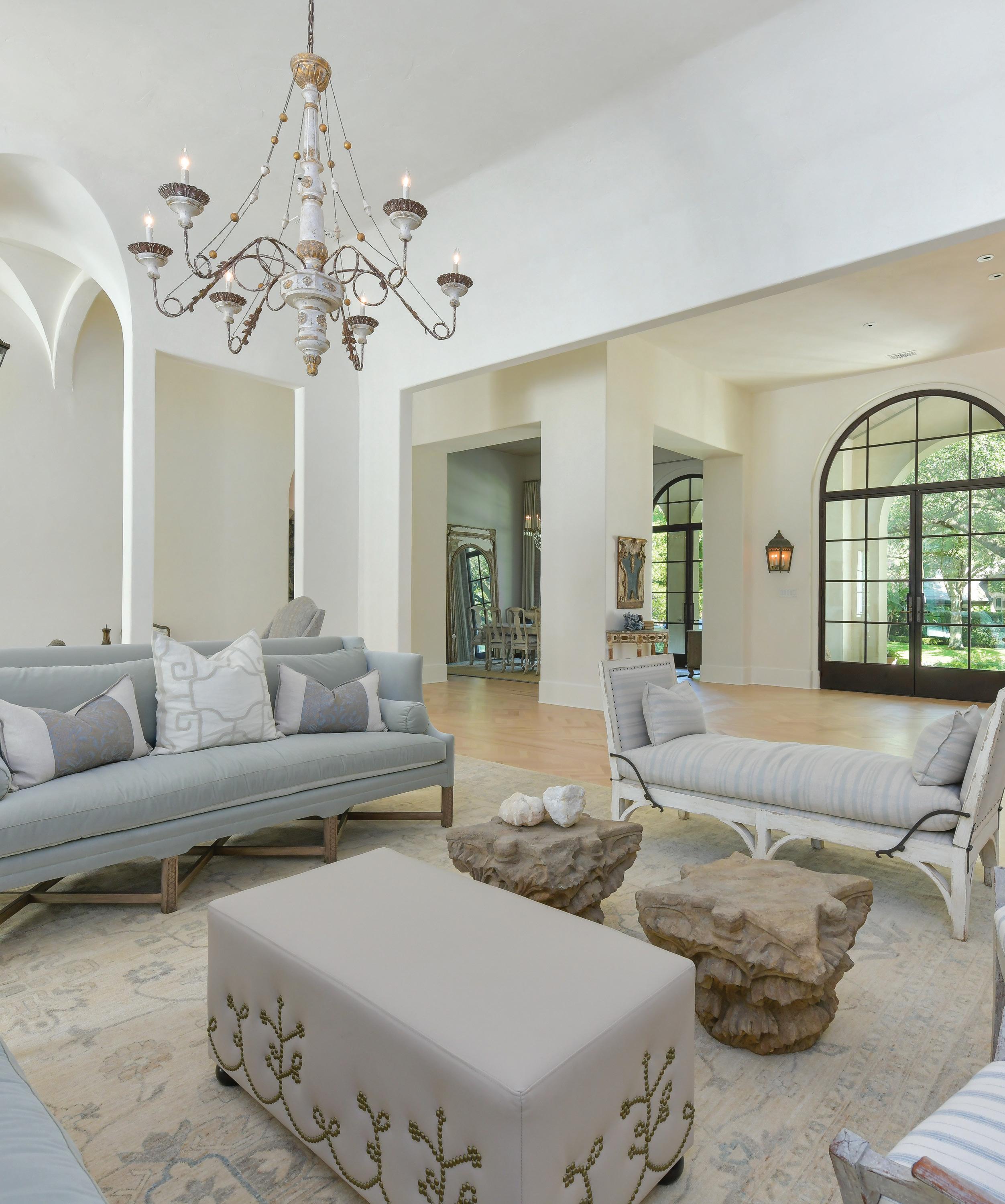
Even faster? Even more informative? Even more beautiful? All true. Come explore the all-new briggsfreeman.com — fully reimagined so that you can see more, learn more and enjoy more. It is loaded with homes, high-rises, ranches, videos, virtual tours, neighborhoods, schools,
architecture guides, market data and more. Our favorite part? The pages featuring the best pro fessionals in the business: the agents of Briggs Freeman Sotheby’s International Realty. Meet them all — and perhaps find your new home? — at the brilliant new briggsfreeman.com.

Of the almost-endless categories of Sotheby’s sales — paintings, photographs, sculpture, wine, watches, fashion, automobiles, books, coins, NFTs and more — our favorite sale titles always start with one important word: important. It just adds a certain zing to the treasures to be won. Here, just a few upcoming sales of, well, impor tance, this fall. See them all at sothebys.com.
Important Chinese Art (Nov 2, London)
Bid on rare and exceptional Chinese works of art and paintings spanning dynasties and peri ods. Previous sales have included vessels, vases, figures, carvings, porcelains and ceramics.
No passport? No problem. This exquisite home has all the makings of a Spanish villa — without leaving the Dallas city limits. Sited on a heavily treed, 1.09-acre lot in Old Preston Hollow, 9851 Rockbrook Drive is an ode to the architectural traditions of Andalusia, the southernmost region of Spain.

The stucco facade and terracot ta-tile roof are merely a few of the many Spanish-inspired features woven throughout this home. A handful of patterned-tile walls, for instance, adds a bit of intrigue to the otherwise clean, monochromatic exterior. Other exam ples of Andalusian influence include carved beams, cathedral ceilings, handhewn doors, wood-and-stone fireplaces
and jalis, or latticed stone screens.
Spanning 6,462 square feet, this stun ning retreat boasts four bedrooms, three full baths and two half baths. A guest suite and kitchenette sit atop the three-car garage, overlooking the shady backyard, idyllic pool and wisteria-wrapped arbor. A covered patio, a high-top bar, a wood-fire oven and a side courtyard with a colorful, tiled fountain are additional outdoor features.
9851 Rockbrook Drive, $6,975,000, represented by LeeLee Gioia and Anne Goyer of The Gioia Goyer Group, briggsfreeman.com
Important Watches (Nov 9, Geneva; Dec 9, New York)
Time is of the essence: Bid on extremely attrac tive and collectible watches from renowned makers such as Patek Philippe, Rolex, Audemars Piguet, Vacheron Constantin and Cartier, both vintage and contemporary.
Feather your nest with furnishings by the greats, from Art Deco to Contemporary De sign. Past sales have included pieces by Jean Royère, Jean Prouvé, Paul Evans, Paul Frankl, Carlo Scarpa and Charlotte Perriand.
Gilt-bronze sheep by François-Xavier Lalanne, sold in 2020 for $1,169,500 (estimate $400,000 to $600,000)
 ON THE COVER: THE STYLE OF SPAIN
ON THE COVER: THE STYLE OF SPAIN
Market expertise. Impeccable reputation. After more than 35 years in real
The Eleazer Group

the
and out. And when
Brenda Schoenfeld would like you to be surprised. The self-described restylist has created an entire busi ness around remixing, reusing and rethinking the furniture and accessories you already have in your home — to some rather jaw-dropping results. Schoenfeld talks a lot about a home’s DNA, and transforming spaces is most certainly in hers. Before launching MyRestylist, where the many services include reimagining rooms, staging homes and styling dinners and parties, Schoenfeld designed her own line of linens and glassware, opened three retail stores and ran a wholesale business that supplied goods to Neiman Marcus, Bergdorf Goodman and others. Style isn’t just her livelihood: It’s her love. “You must live among things that surprise you with delight,” says the savvy restylist. Here, some quick tricks from Schoenfeld for falling in love with your rooms again.
What are three instant tricks to give a room a fresh look? Everything you need is around you! Introduce elements of nature — like flowers, branches and leaves — that bring out a room’s natural beauty. Bring in vintage pieces. A vintage piece can become a gem that recalls a me ticulous essence, simply due to the era in which it was created. Examples would be a gilded lamp or an accent table. Finally, I believe strongly that you must live among things that surprise you with delight. We love adorning existing furniture with renewed hardware. I call it jewelry for your furniture.

How do you instantly lift a bedroom? Your bedroom is your sanctuary, your retreat from the rest of the world. It’s where you go to replenish. The way to achieve that is by having a one-color, multitone bedroom. For example, bed ding, pillows and window treatments can be in similar tones within the same color palette. Another accessory for any bedroom is exquisite lighting. For mood, our favorites are luminarias by Emilia
1 An Emilia Castillo table lamp 2 A client’s dining room, restyled to show off a collection of Ardmore pottery; the Saarinen table was relocated from a game room
3 Aubergine paint for a luxe living room 4 New “jewelry,” as Schoenfeld calls hardware, for reinvigorating a familiar piece; the handles are from myrestylist.store
5 A concept sketch of Schoenfeld’s own single-color bedroom 6 A fresh wreath on an Emilia Castillo holder
Castillo. For function, my rule would be to have specific reading lights. They can even be recessed-can spotlights in the ceiling. Finally, no bedroom would be complete without tantalizing your senses. Nothing is more rewarding for your spirit and your sleep than essences. At MyRestylist, we adore essential oils, candles and diffusers.
What are the living-room wall colors you are loving right now? Our current favorites are shades of aubergine and linen white, together. Why? Because I find that

aubergine has strength, especially when paired with linen white. The combination is both bold and sensual. The living room is the focal point of all homes. There is nothing more luxurious than the color of the walls. The color selection allows your pieces to shine and can create an instant, chic transformation.
Contact Brenda Schoenfeld of MyRestylist at 305-323-8453; brenda@myrestylist.com; myrestylist.com. Shop Schoenfeld’s home-design goods and vintage finds at myrestylist.store.

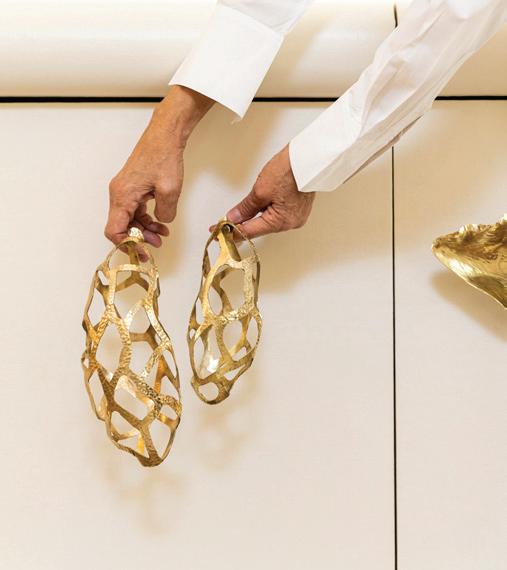

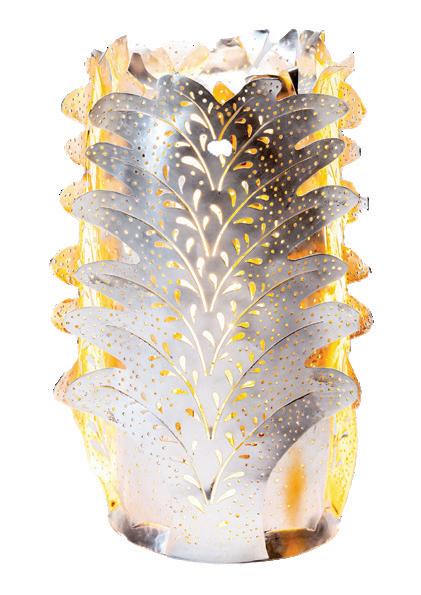

Beautiful balance: 9630 Inwood Road is a brilliant mix of sleekness and warmth, on nearly an acre of lush landscaping in Preston Hollow.
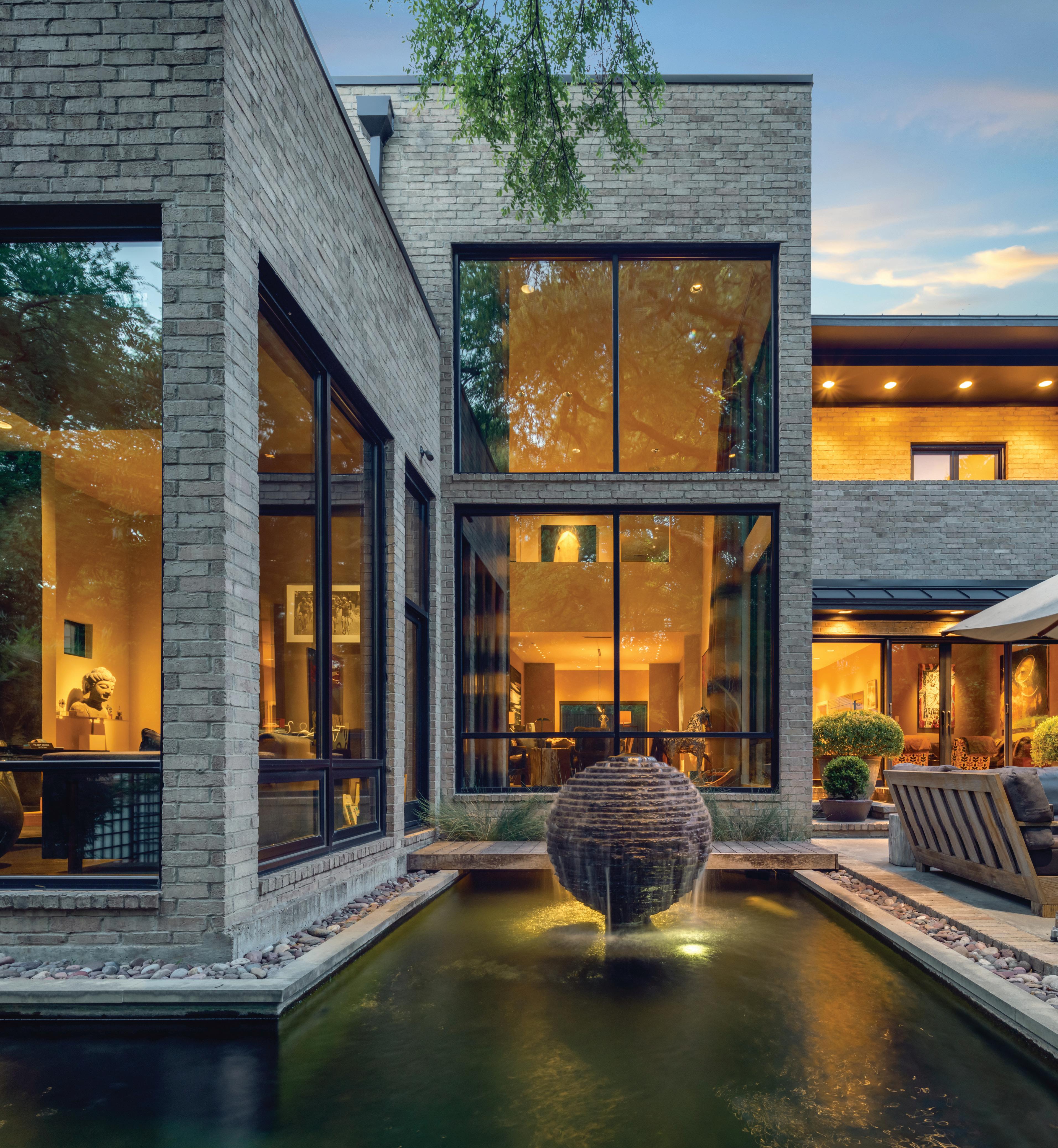
FROM A SPECIALIST IN UNIQUE REAL ESTATE, A SLEEK HOME WITH A PAST AND CHIC RESIDENCES WITH A FUTURE
Top notch: The Terminal at Katy Trail has been topped out and construction is moving along briskly on the game-changing residence in Dallas.
There are homes that defy categori zation — and 9630 Inwood Road is one.
Built in 1985 and reinvented twice since, the residence is a brilliant balance between sleekness and warmth, idyllically sited on nearly an acre of lush landscaping. In peaceful Preston Hollow, this one-of-a-kind property has it all — including a library, study, chef’s kitchen, four bedrooms, six full baths, media/ fitness room, safe room, koi pond, salt water pool and architectural footbridge connecting two outdoor living areas.
But it is the materiality of the home that sets it even further apart. Each room is appointed with luxe and unconven tional finishes — from the living area’s monumental fireplace clad in 90-yearold, book-matched mahogany and white Danby marble to one bedroom’s walls and draperies of opulent cashmere. An other bedroom’s walls? Stitched leather. Other standout spaces include a den with crotch-mahogany walls and a library with smoked mirrors and cashmere carpeting.
The elegant primary suite is a show stopper of its own. It features a wood burning fireplace of white Danby marble, multiple walk-in closets and a sleek bath with dual vanities, refrigerator, enclosed shower, skylighted tub and water closet, the latter with walls lined in natural cork. Adding to the suite’s retreat ambiance, a door leads to a private terrace that enjoys views of the mature trees and lush backyard.
9630 Inwood Road is represented by Faisal Halum for $6,990,000; briggsfreeman.com.
Iimage is an artist renderings. The artist representations and interior decorations, finishes, appliances and furnishings are provided for illustrative purposes only. Prices and features are subject to change.
THE TOP OF THE TOP: THE GLAMOROUS TERMINAL AT KATY TRAIL IS MOVING ALONG ‘AT A GLORIOUS PACE’
One of the most exciting residences in Dallas’ history has reached a new milestone: its topping-out, this sum mer. The full frame is up and The Terminal at Katy Trail is clipping along at a glorious pace, being handcrafted at the cor ner of bustling Fitzhugh Avenue and beauti ful Buena Vista Street. With signature arches inspired by the world’s great train stations — a nod to its location along the former railway that is today’s Katy Trail — the building will be home to just 16 spectacular residences, each with sweeping views, 11-foot ceilings, a gourmet kitchen, butler’s pantry, sumptuous primary suite and large closets. The ameni ties are carefully considered and will include a walk-through paseo of shops on the ground floor that will offer sophisticated eats and
pampering services, plus direct access to the Katy Trail, private underground parking, valet, concierge, fitness studio and dog park. Reservations for the final residences are being taken now.


4205 Buena Vista Street, opening summer 2023, is represented by Faisal Halum; briggsfreeman.com, theterminalatkatytrail.com.
Faisal Halum leads the Faisal Halum Group, the #1 small team in Dallas and the #3 small team in all of Texas in the 2022 RealTrends America’s Best rankings. The group is also the top residential team at Briggs Freeman Sotheby’s International Realty and in the top 1% worldwide with Sotheby’s International Realty®. Contact Faisal Halum at 214-240-2575 or fhalum@briggsfreeman.com.

When we formed Jobst Randall Group in 2017, we couldn’t have known what lay ahead. Today, we celebrate not only five years of enduring success, but the steadfast loyalty and support of you our friends, clients and loved ones who share our dedication to the people, the heritage and the homes that make Dallas great.
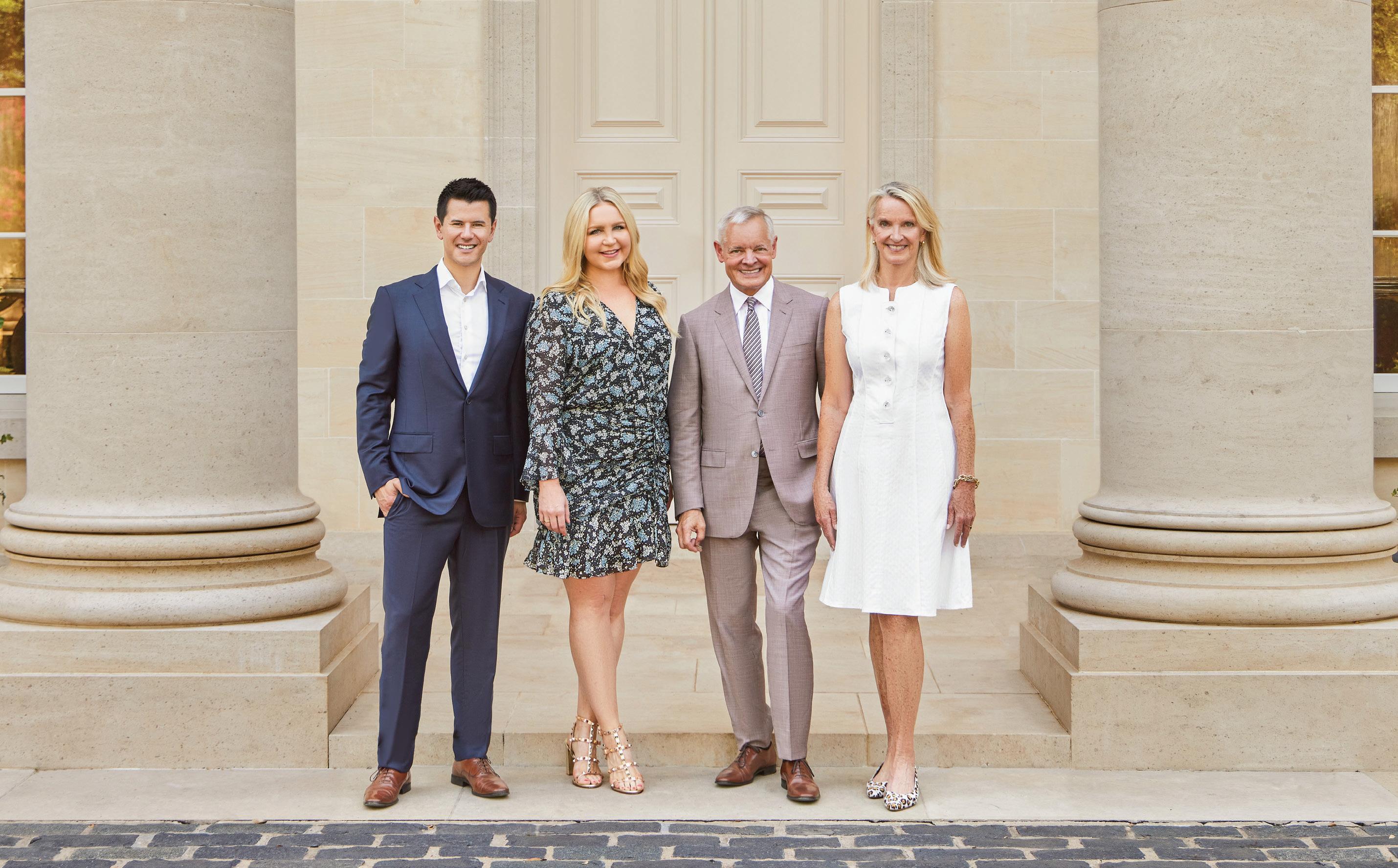
Ralph Randall & Madeline Jobst with Michael Wong & Caroline Thompson
© 2022 Sotheby’s International Realty. All Rights Reserved. Sotheby’s International Realty® is a registered trademark and used with permission. Each Sotheby’s International Realty office is independently owned and operated, except those operated by Sotheby’s International Realty, Inc. The Sotheby’s International Realty network fully supports the principles of the Fair Housing Act and the Equal Opportunity Act.
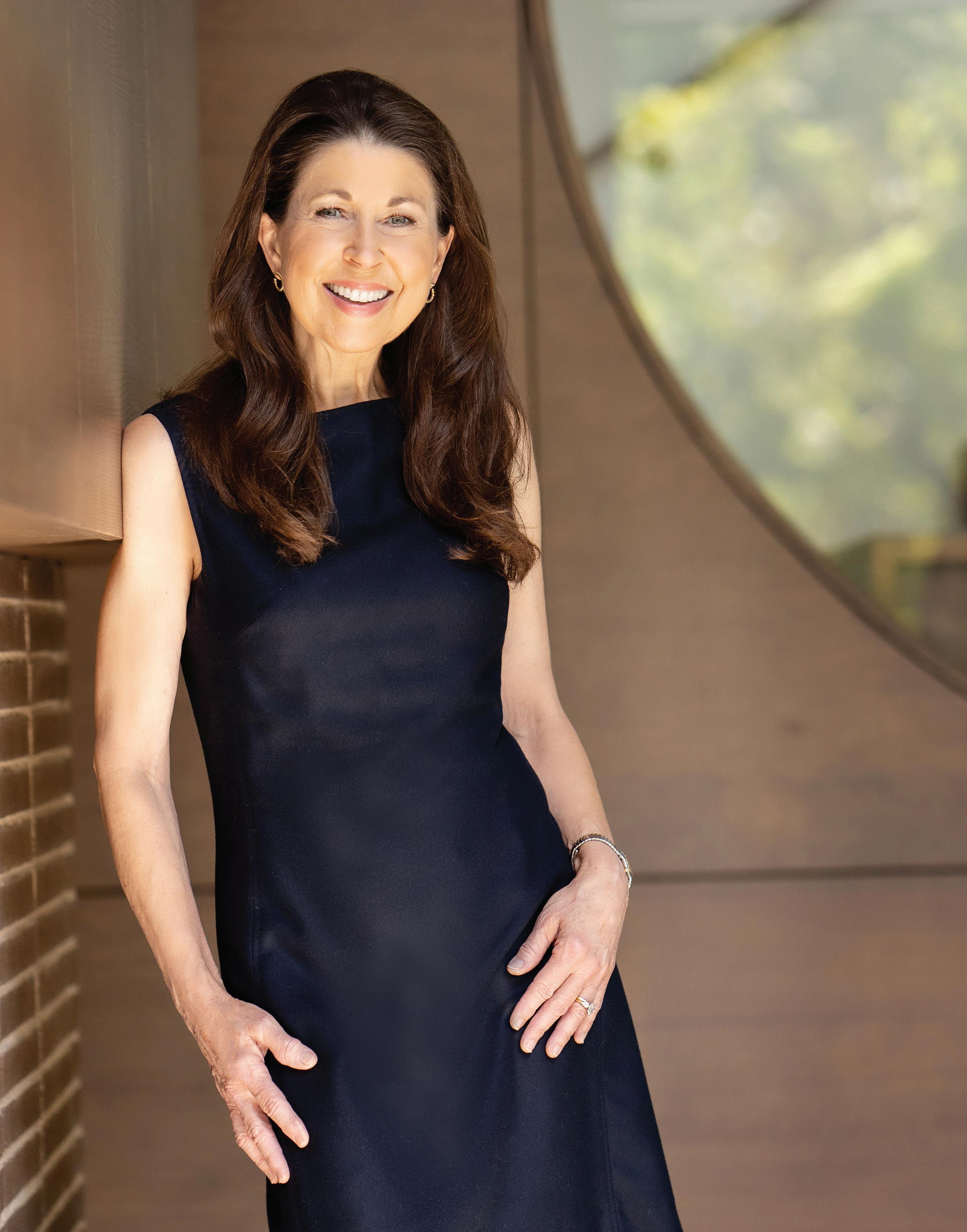
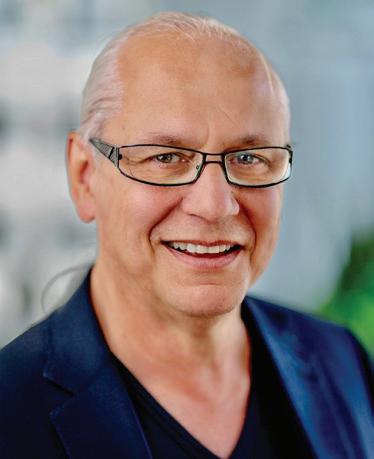
Because standard doesn’t do at the superluxurious HALL Arts Residences in the Dallas Arts District, even its model homes — all by A-list local and national designers — are a cut above. Here is the inside look at its three latest showcases.

THE MODEL McKinzie has curated a one-ofa-kind, 3,677-square-foot modern and artistic home with stunning art by Jo Temming. The home also features custom light installations by Dallas-based Carlyn Ray with a custom closet by international design firm Ornare. THE SCOOP “The inspiration for the design came from the home itself and its remarkable views. One of the goals was to compliment the beau tiful natural light and the array of pastel colors that come through the abundant windows at dusk. The furnishings, color palette and art all have an important role in making the space feel warm and cozy but to really let the views be the star of the show!” THE DETAILS “Neutral fabrics were selected, with accents of black and dark wood tones. Copper velvet chairs provide a lovely glow to the space, especially with the colors of the setting sun.”
THE RESUME
Founder of Tiffany McKinzie Interiors, estab lished 2002 • More than 150 luxury residential new-construction and renovation projects in the DFW area, plus projects in Oklahoma, Col orado, Massachusetts and California • Voted a D Magazine Best Designer each year since 2010 • Luxe Interiors + Design’s Gold List, 2016, 2019 • Textiles and wallcoverings line Tiffany McKinzie for Effe. THE ESSENCE “My sig nature style is traditional, tailored and classic,” says Tiffany McKinzie. “I’m naturally inclined to symmetry. I also strive to have harmony throughout all spaces, so there’s a congruent flow and there’s nothing jarring or disconnect ed from one space to another.”
THE MODEL George Bass Stage & Design has styled a spacious, 4,702-square-foot
Related: Look who just moved into HALL Arts Residences, on page 88.
home where the overall design is contempo rary — with some unique eclectic touches throughout. THE SCOOP “My inspiration was the city of Dallas and how diversified it has become in the last 10 years, with such an international legion of new city dwellers. The approach I took with Residence 303 was the total view it has of the city and how I could neutralize the spaces, with white being the common denominator throughout. The reflective quality of the natural light coming in makes the spaces feel open and fresh.”
THE DETAILS “I am known for using white furnishings and large original art. It has
Above and left: Resi dence 2102 by Tiffany McKinzie Interiors compliments the pastel natural light that comes into the home at dusk. Opposite: Residence 303 by George Bass Stage & Design has an eclectic air inspired by the internationalism of Dallas. Residence 502 by Mitchell Gold + Bob Williams brims with chic furnishings and “livable luxury moments.”

become a signature of mine in my staging approach. It really sets the model’s mood and the possibilities for true collectors to imagine their art collections — and how wonderful these walls will be in each room’s overall style.”
THE RESUME Cel ebrating more than 20 years of experience
• Knows the importance of telling a story through artful design and treats every space as a unique vignette
• Creates luxu rious and welcoming interiors that inspire emotional connections. THE ESSENCE
“I am known in the real estate and design communities for the white inventory
Model by Tiffany McKinzie InteriorsTHE BUILDING HALL Arts Residences offers the perfect blend of art and living. The 28-sto ry tower is thoughtfully designed to provide the most sophisticated living experience within the most carefully engineered residential building in the city — all surrounded by views of buildings by architects who have won the prestigious Pritzker Architecture Prize (think Winspear Opera House and Wyly Theatre).
HALL Arts Residences, 1747 Leonard Street, is exclusively represented by Kyle Richards and Cindi Caudle of Briggs Freeman Sotheby’s International Re alty; briggsfreeman.com, hallartsresidences.com
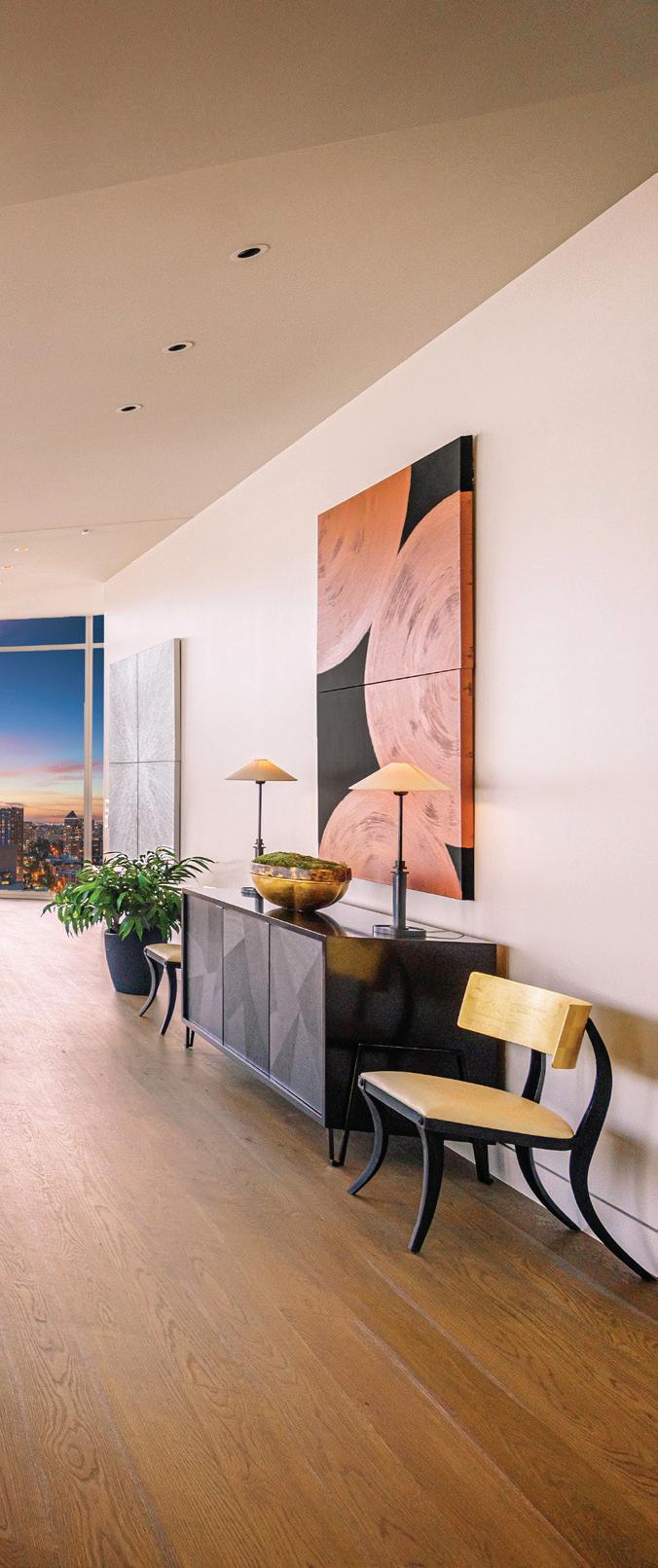
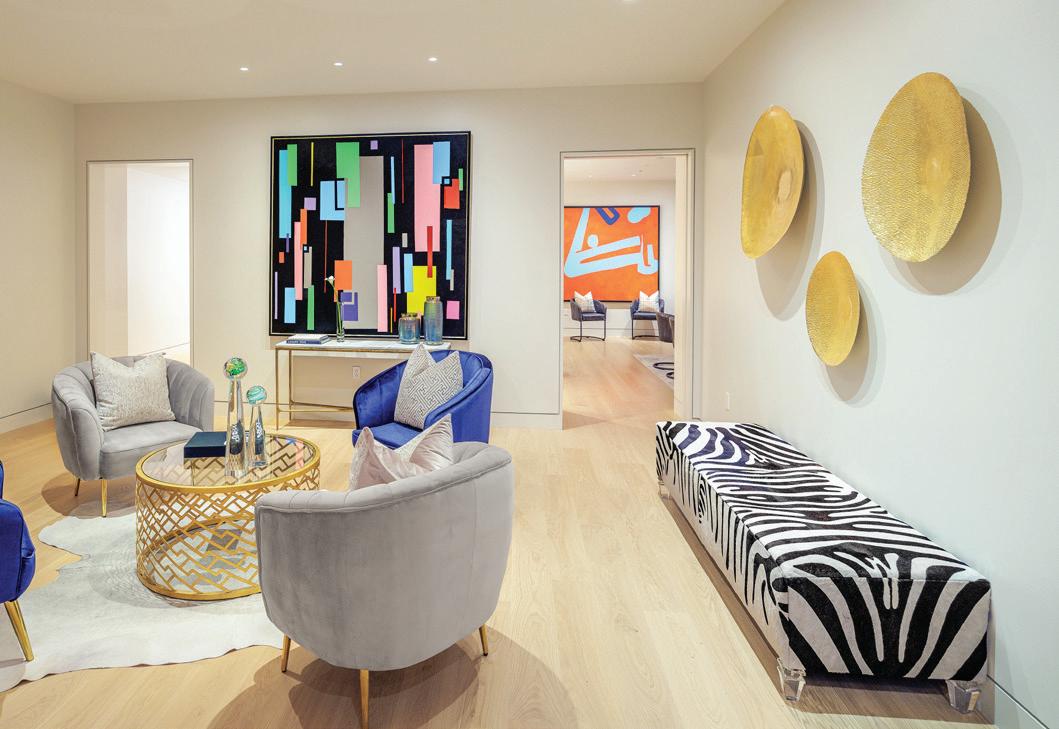
Number of bottles that each homeowner’s locker holds in the building’s glass-walled Wine Cellar
Square footage of the two-story penthouse, available as shell space for building out a dream

we collect,” says George Bass. “How we merchandise it secures a sense of neu trality and makes the space visible to each individual set of eyes as a buyer. We do not compete with the premier architectural style of each property: We just enhance a lifestyle mood.”
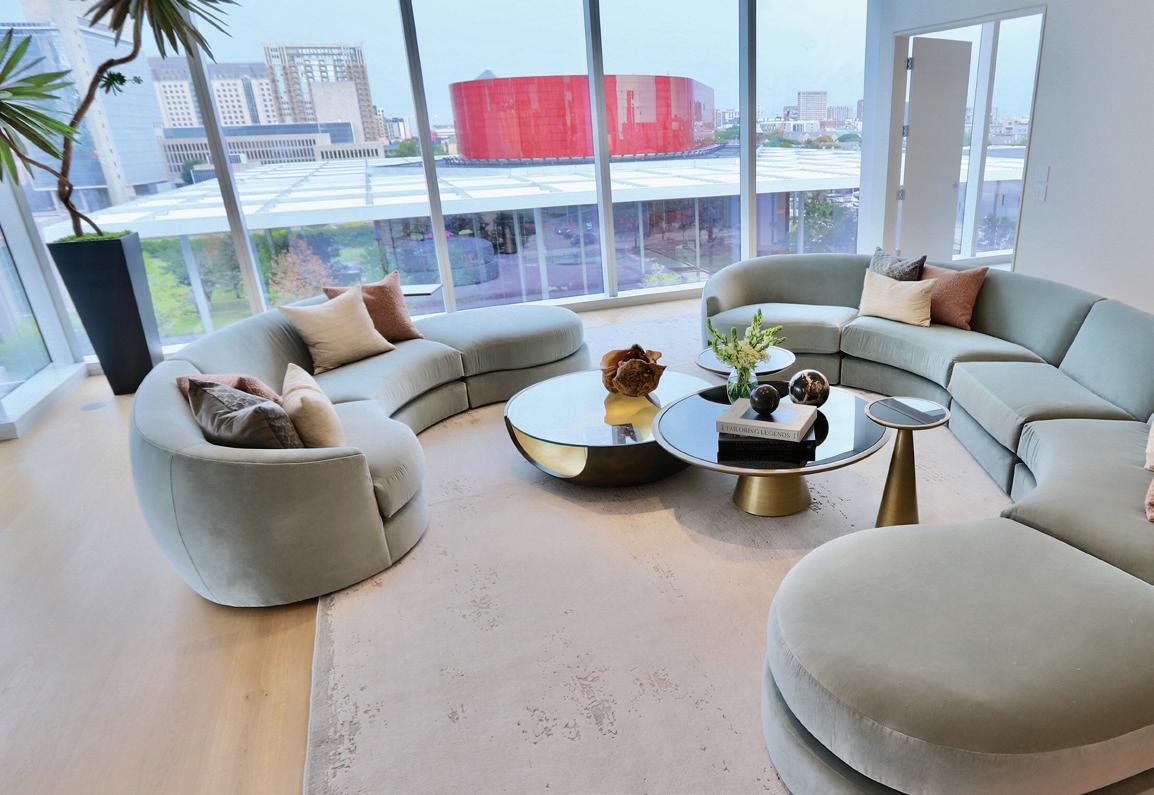
THE MODEL The internationally ac claimed, American-made-furnishings company has created a 5,618-square-foot modern — but very livable — model home at
HALL Arts Residences that features fresh, natural and oh-so chic furnishings along with “big, beautiful, livable luxury moments” throughout the home, all with sweeping views of the Dallas Arts District. THE RESUME Since 1989, owners Mitchell Gold and Bob Williams have been risk-takers, embracing who they are — along side the creative voice of their customers — to make home more livable through attention to detail, craftsmanship and sustainable sourcing. As active members of the Sustainable Furnishings Coun cil, they educate customers to understand best practices to ensure a sustainable planet for generations to come. Their earth-friendly upholstery is handcrafted in the United States and each piece is carefully bench-made by skilled artisans to create a work of art that will stand the test of time. Learn more about this model and all of the stunning model homes at hallartsresidences.com.
HALL Arts Residences is the first residential development in Texas to register for WELL health and well-being certification
“Our goal was to build a beautiful residential highrise that combines thoughtful design with the best services possible in the greatest location — the heart of the Dallas Arts District.”—Craig Hall, developerModel by George Bass Stage & Design Model by Mitchell Gold + Bob Williams Model by George Bass Stage & Design
n Steve is a native of London, the birthplace of Sotheby’s. Living in one of the world’s greatest capital cities, Steve says, sparked his passion for history, architec ture, design and culture.
n His background in the finance and investment banking industry gives Steve an edge — he’s able to confidently negotiate the best deal on behalf of his clients.
n Steve knows how to make a house a home. Using his eye for detail and design, he helps buyers spot the po tential in a property by pinpointing what improvements can be made. With sellers, he applies these same skills to get their homes ready for market and ensure optimum sales price.
Known for his highly customized approach to real estate, Steve Killingback is diligent, detail-oriented and design-minded — the trusted advisor you need.
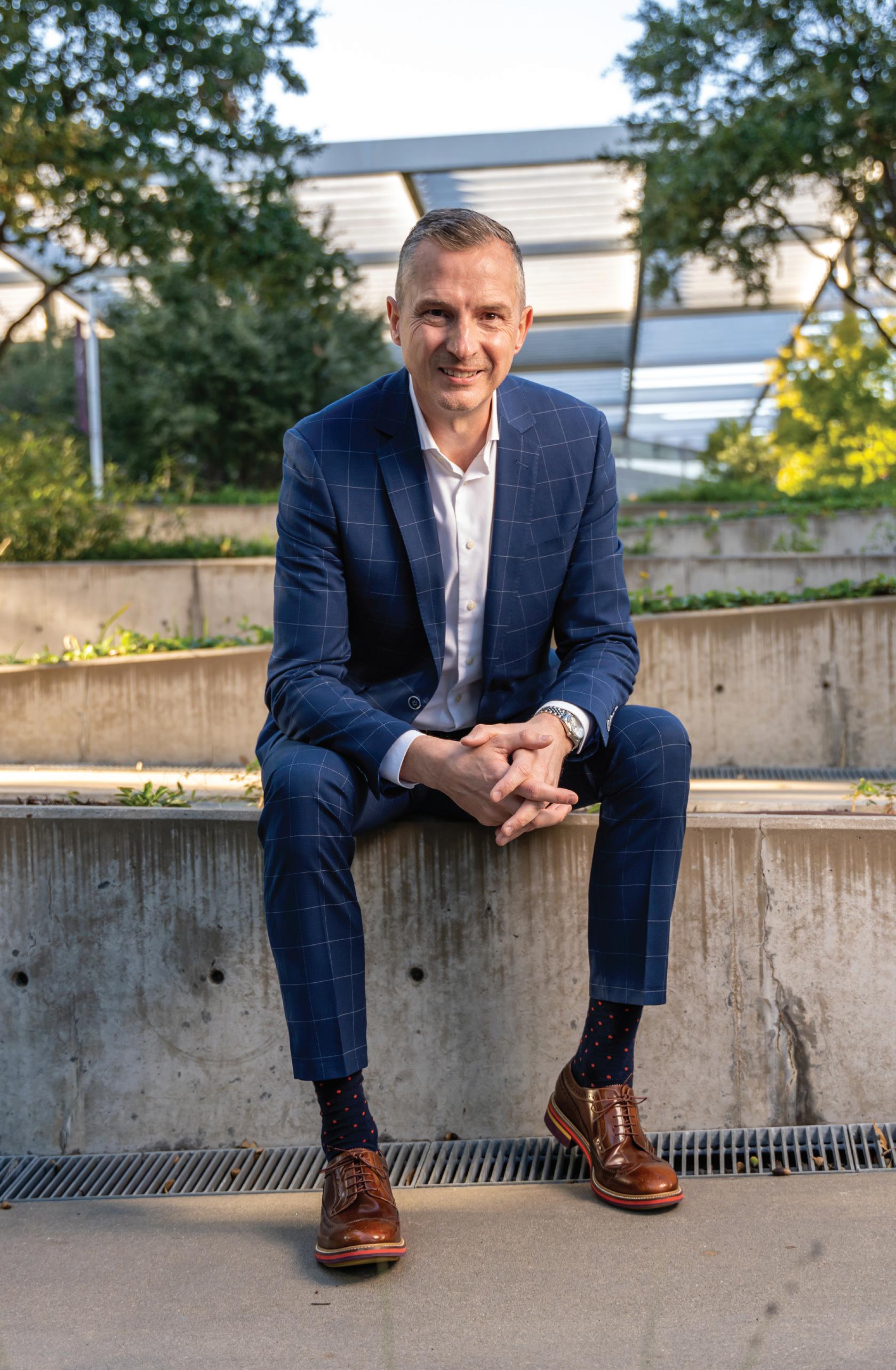
Global Real Estate Advisor 469-230-4388
skillingback@briggsfreeman.com stevekillingback.com
2022 Brokerage Individual Top Producer
2022 Innovator in Marketing Award
2022 D Magazine Individual Top Producer and D Best
Steve gets a lot of love from clients — whether they’re buying, selling or just dreaming big. What are they saying?
Steve went beyond all expectations and excelled in creative marketing to make our property appealing and stand out with buyers. He also helped us in the search for our new home. We are in our dream home because he was such a good agent!” —Scott R.
BY THE NUMBERSNumber of North Texas ZIP codes in which Steve has closed transactions, since joining Briggs Freeman Sotheby’s International Realty
Number of deals Steve has closed, to date
Number of referrals Steve has received — from happy clients and fellow Sotheby's International Realty® agents — to date
Each Office Is Independently Owned And Operated.
RAVE REVIEWSEach Office Is Independently Owned And Operated.
“Pam earned our loyalty… She made the process extremely easy and understood exactly what we wanted, even if we didn’t… We are forever grateful for all the time and effort Pam invested into finding us our perfect home… It’s doubtful we would have ever made the move to Dallas without her.”
a small sampling of Pam’s clients
“Jeannie is the consummate professional… She made not one, but two challenging real estate transactions flow seamlessly… We were not in Dallas and therefore not able to be active sellers, and Jeannie took care of everything for us… From beginning to end, she was accessible and wellinformed of market trends.”

just a few of Jeannie’s clients
Jeannie Nethery Broker Associate 214-803-3787
jnethery@briggsfreeman.com
Pam Brannon
Global Real Estate Advisor 214-912-1756
pbrannon@briggsfreeman.com
2022 Brokerage Team Top Producers 2022 D Magazine Top Producers, Team of 2, and D Best
Whether you’re moving across town or across the country, the Nethery Brannon Group is here to make every transition a smooth one.
When location, landscape and home come together in a superbly thoughtful way, there is nothing more satisfying. It is a thrilling combination — one that will enhance your every day. This is 4929 Sene ca Drive, in Dallas’ wooded Bluffview neighbor hood, in the desirable Sunnybrook Estates area. A generous 1.66 acres on a quiet and prestigious street, the property is a haven of architecture, luxury and leisure.
The grounds are, in a word, spectacular. With 125 trees chosen by the owners and a manmade stream that flows through the landscape echoing the sounds of nature, it is a soothing haven, complete with a freeform pool, bubbling spa, tennis court and wind ing paths for walking. The home’s terraces, balconies and outdoor staircases complete the idyllic picture — one that could never be replicated today, on such a generous lot with such mature flora.
The home, set amid its own private park, is a design masterpiece by the great Texas modernist Frank Welch. Custom-built in 1979 for the original and current family, the copper-roofed contemporary house offers 6,366 square feet of space, style and views. Its large-scale living and dining areas feature 13-foot ceilings, floor-to-ceiling windows, quarter-sawn Versailles-pattern hardwood floors and views to the verdant, lush green back yard. A private study with a fireplace also enjoys views of the breathtakingly beau tiful back yard.
The oversized primary suite is on the main level and features two baths and overly generous closet and office spaces. Adjacent to the kitchen is a flexible-use area with two bedrooms, a full bath and sitting area. Two additional ensuite bedrooms, one with a fireplace, are on the home’s lower walk-out terrace level. Both have access to the lower terrace areas in the back yard. A separate guest house on the far side of the swimming pool has tall, vaulted, double-open-truss ceilings, a fireplace and a kitchenette.
Other features of the main home include multiple fireplaces, folding dou ble-paneled nine-foot doors between the
main living and entertaining spaces, custom bookcases, built-ins and storage spaces throughout the home, a gated circular drive, a spacious parking court, and a three-car attached garage.
In Texas Architect magazine, which featured the home in 1981, it is described by a design-competition juror as an “extraordi narily sophisticated” house that combines “the spirit and details of the vernacular resi dential tradition with the space and amenity demanded by [modern-day] clients.” More from the magazine: “Three gables defin ing the major elements of the two-story structure are linked by flat, open galleries ... The house is seen as a single structure whose basic formality is softened and lightened by subtle symmetries.”
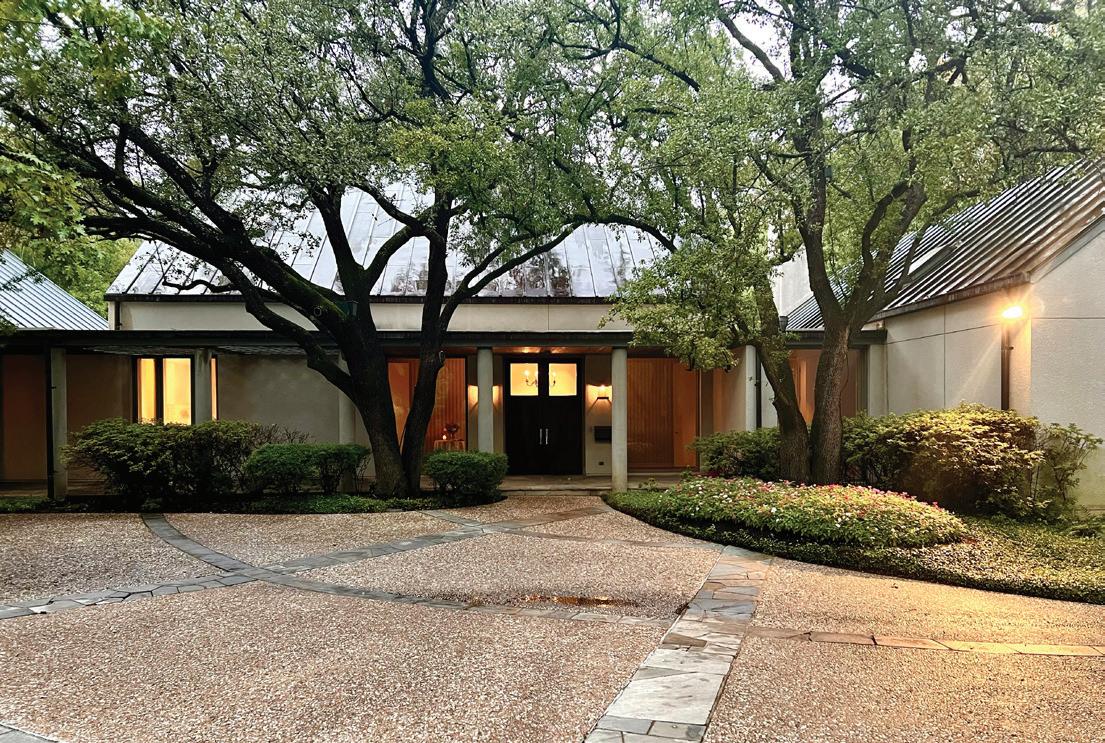
Timeless. Exclusive. Exceptional. This is the chance of a lifetime to live in your own private park, in a home designed by, as the

4929 Seneca Drive in Dallas’ wooded Bluffview neighborhood offers 1.66 dreamy, parklike acres and a Frank Welch designed home to be enjoyed as is, updated or entirely reimagined.

American Institute of Architects has called Frank Welch, “the standard bearer of Texas regional modern architecture.”
4929 Seneca Drive is represented by Diane DuVall of Briggs Freeman Sotheby’s International Realty for $6,995,000. Contact her at 214-725-1451 or dduvall@briggsfreeman.com.
A PRIVATE PARK AND A HANDSOME HOME PERFECTLY SITED WITHIN IT: IS THIS PARADISE FOUND?
THE DALLAS MORNING NEWS “Welch’s ar chitecture became known for his sensitive use of texture and his graceful, light-filled spaces. In 2015, Dallas Morning News architecture crit ic Mark Lamster wrote that Welch practiced ‘in a manner that borrowed elements of vernac ular Texas architecture … but reconstituted them in an unapologetically modern way.’”

D MAGAZINE “Throughout this city’s history … there have been a handful of artists who have seen and understood this place for what it is, and have made work that has managed to embrace and manifest the cultural identity and character of this city in its best light. Perhaps none were better at this than the architect Frank Welch.”
The property features a home designed by Frank Welch, grounds designed by Naud Burnett and Howard Garrett and landscape lighting designed by John Watson (affection ately known as “Mr. Moonlight.”)
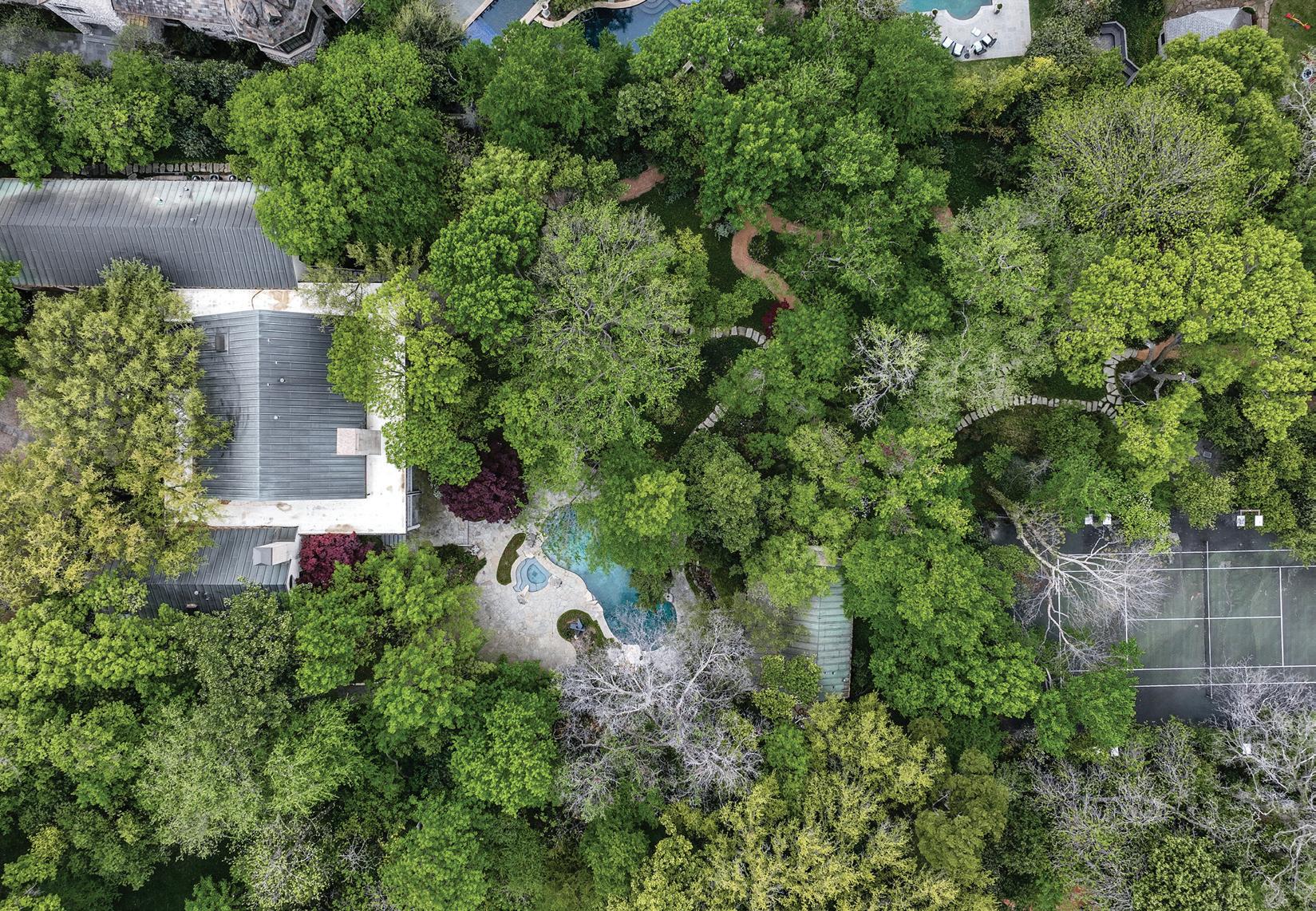
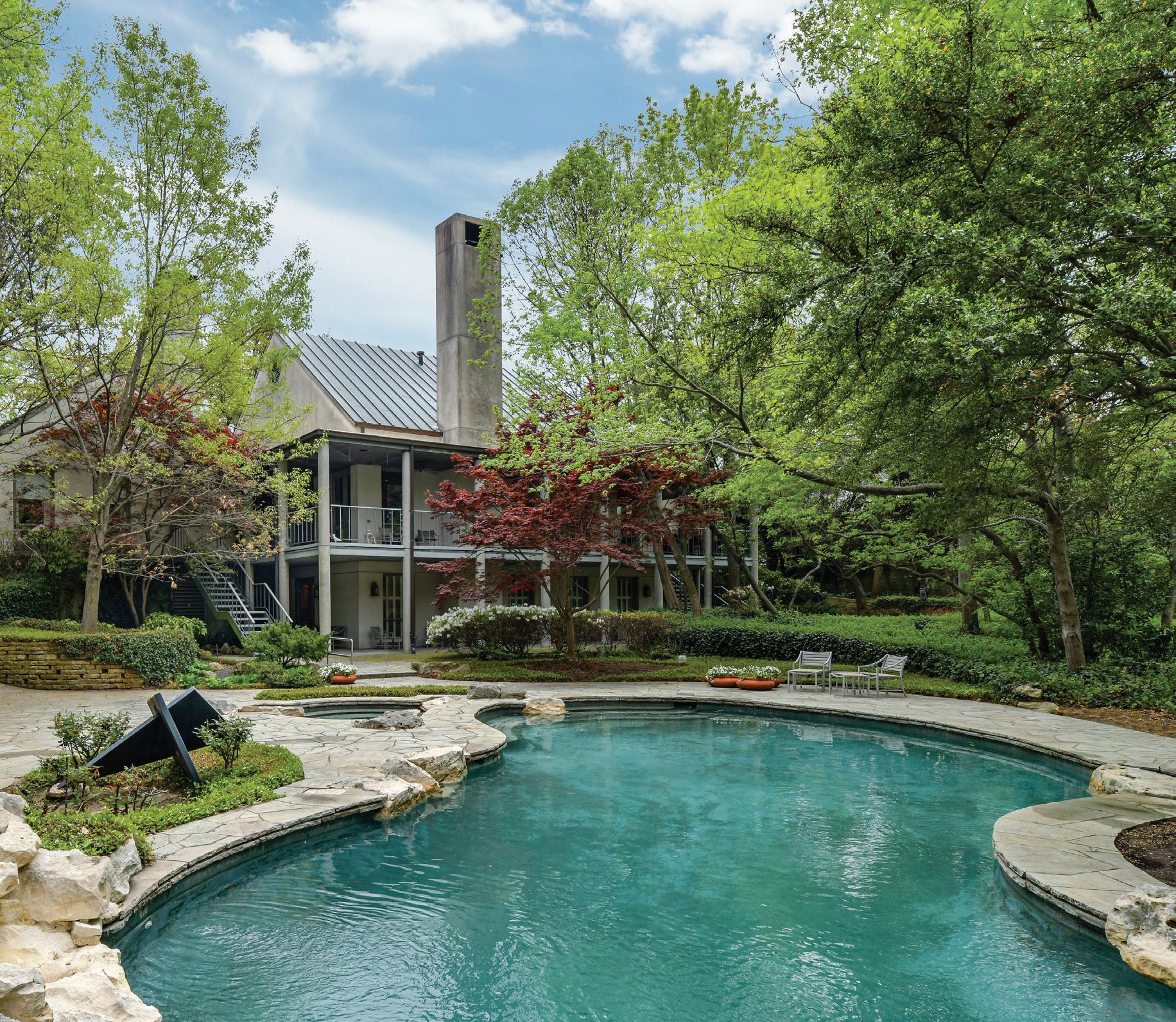
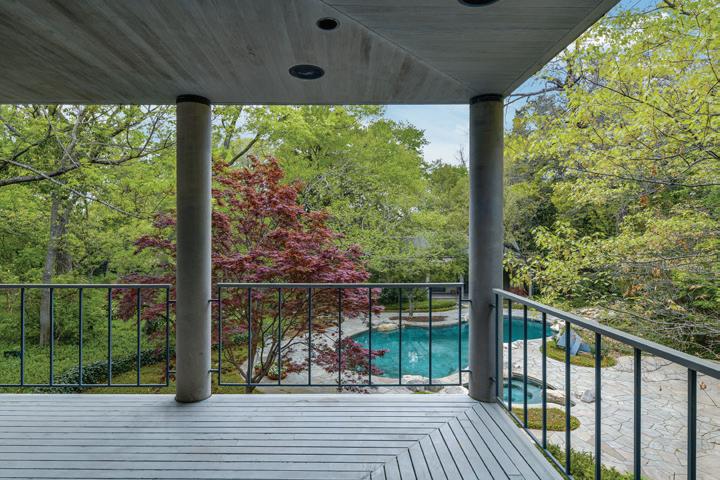
Ranches couldn’t be hotter — and not just as escapes from city life and routines. These days, investments that pay in ways other than economic returns — family, fun, time spent outside — have become much more important.

One bunch knows all about this: the Ranch and Land Division at Briggs Freeman Sotheby’s International Realty, a world-class group of teams and individuals who specialize in land, farm, recreation and rural properties. They sell in Texas, Oklahoma, Colorado, Mexico and the rest of the world, because they are also part of the $204 billion So theby’s International Realty® network in 81 countries and territories.
Gathered here are just three significant sales from the #1 ranch division in all of North Texas.

Just 90 minutes from the North Texas area, another world awaits: rolling hills, ancient live oaks, native grasses, wildlife, fishing and more. Rocosa Ridge Ranch is the ultimate getaway — rugged and refined — with an architecturally stunning main home, 1800s New England barn and history-packed mess hall and bunkhouse. This wasn’t just the largest Bosque County property offered in decades, it was the opportunity of a lifetime.

The Gearhart Ranch has been in operation as a cattle ranch since 1890, in the Davis Mountains, where the traditions are the same as they were more than 100 years ago. It not only sports a main house, foreman’s house, multiple barns, saddle house and camp area, it also offers stunning vistas, beautiful West Texas sunsets and peace ful nights to watch the stars.
In some of the most beautiful country that North Texas has to offer, The Woods is replete with breathtaking views and an abundance of vegetation and habitat for wildlife and livestock. With terrain from rolling to hilly, it features an exceptional main home by world-famous Texas architect Frank Welch, plus a caretaker’s house, skeet range, rifle ranges, lakes, ponds and Red River frontage.
REAL ESTATE’S FINEST RANCH DIVISION HAS BEEN A LITTLE BUSY. HERE, JUST THREE SIGNIFICANT SALES FROM AGENTS WHO DEAL IN BIG.
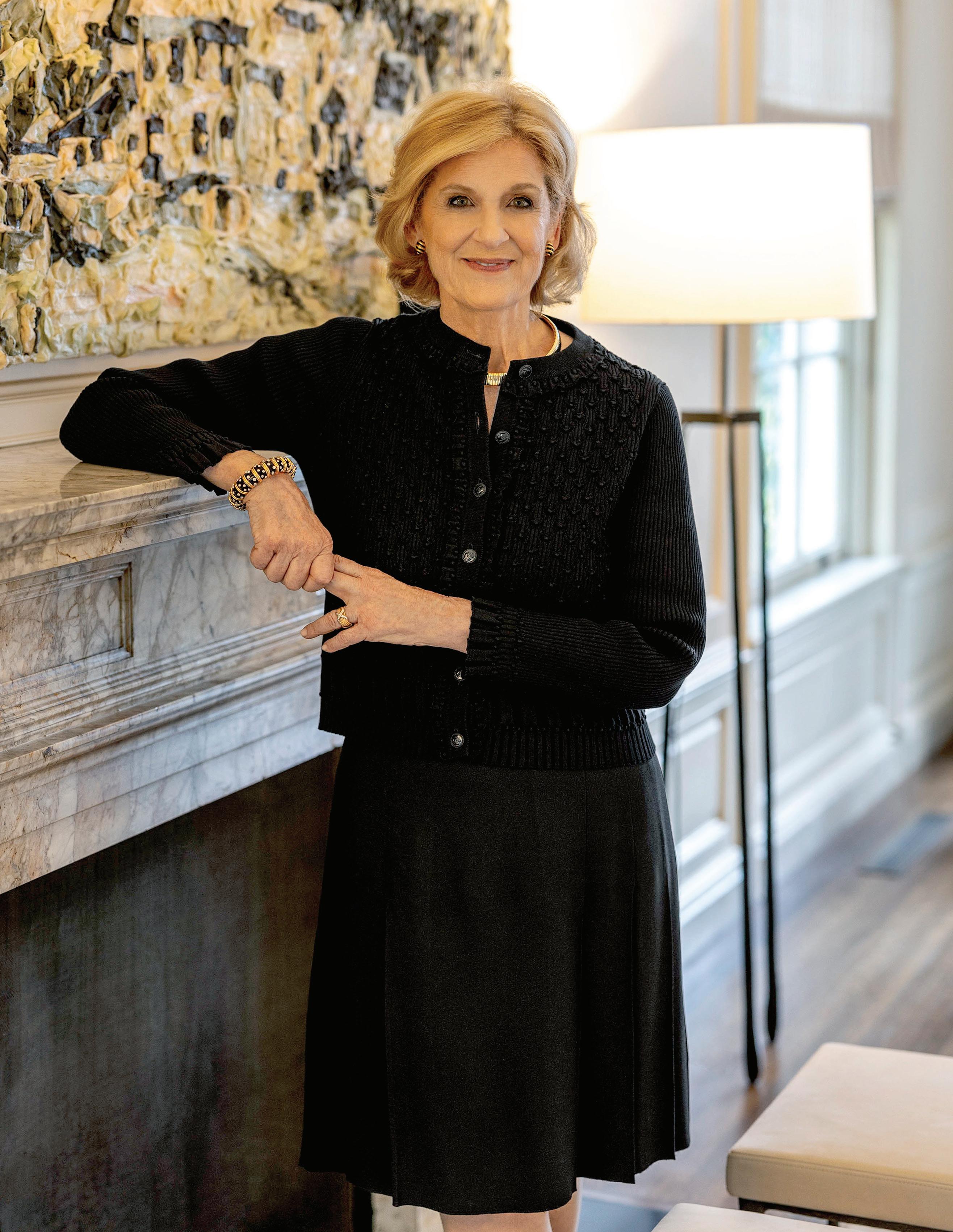
A veteran agent with more than 25 years of experience. A natural-born connector. A generous spirit. A skilled negotiator who operates with grit and grace. An expert in bespoke service and luxury real estate. Only one agent brings all of this to the table — Melissa Frantz Ellerman.
Nothing compares.
Global Real Estate Advisor 404-791-3686 mfrantz@briggsfreeman.com
A lifelong Dallasite, Leigh Burns knows every neighborhood and nuance of this city. She’s an expert in all things Dallas — where to live, learn, work, eat, shop and play. She’s here to help you choose the area that’s right for you — your lifestyle, your career and your family. When you need local expertise, look to Leigh.

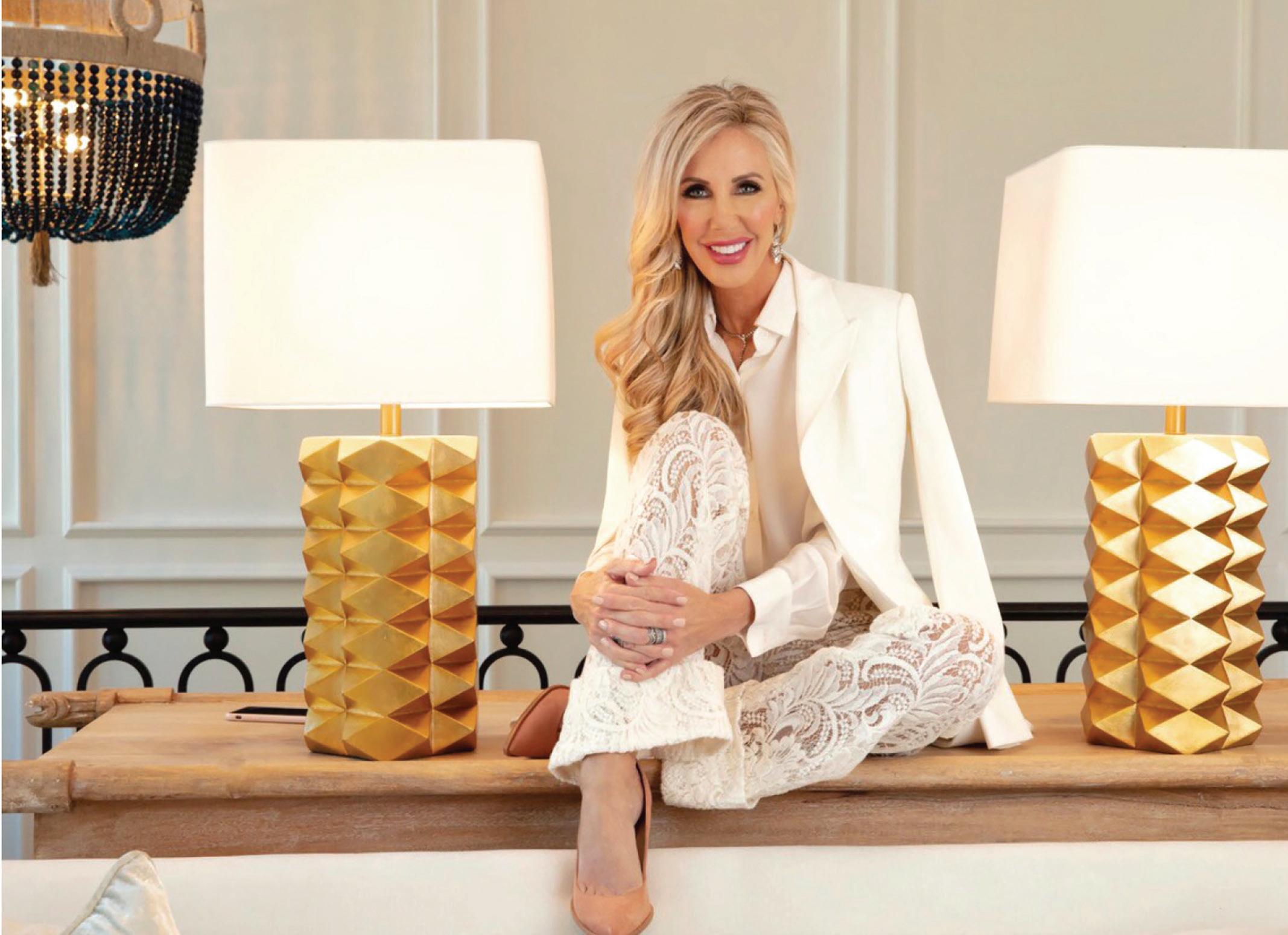
Nothing compares.
Global Real Estate Advisor
214-263-8538
lburns@briggsfreeman.com
2022 Brokerage Individual Top Producer
2022 D Magazine D Best
Each Office Is Independently Owned And Operated.
1Born and raised in Fort Worth, Raleigh Green loves to show clients its hidden real estate gems. Megan Green grew up in the top Dallas suburb of Coppell, and is your go-to for Dallas-area real estate.
2Make Dallas-Fort Worth your home and experience a metro area in the top 25 percent of U.S. News & World Report’s Best Places to Live. It boasts the largest contiguous urban arts district in the U.S., no less than six pro sports teams and more than 20 Fortune 500 companies.
3Raleigh and Megan love living in North Texas. But they love traveling, too, from South America to Switzerland to Singapore. They immerse themselves in other cultures and enjoy helping others do the same!
With the vast Sotheby’s International Realty® network across 81 countries, Raleigh and Megan can facilitate the purchase of your dream home in DFW, help secure your second home in Telluride and scout your new residence when relocating to Tokyo.
Raleigh and Megan have the connections in Texas — and the deep understanding of Texas — to be the only real estate team for your every need: residential to commercial, high-rise to ranch, intrastate or out-of-state.

6
Hear from a satisfied client: “If you want someone who knows the ins and outs of today’s aggressive market, Raleigh is the REALTOR® you need!”
The Raleigh Green Real Estate Group : First-class advisement. Five-star reviews. Raleigh Green (214-208-7417; rgreen@briggsfreeman.com) + Megan Green (281-687-4134; mgreen@briggsfreeman.com)THIS DYNAMIC DUO ISN’T JUST ABOUT HOMES, CLIENTS AND CONNECTIONS. HERE, 6 WAYS THE RALEIGH GREEN REAL ESTATE GROUP IS HERE FOR YOU
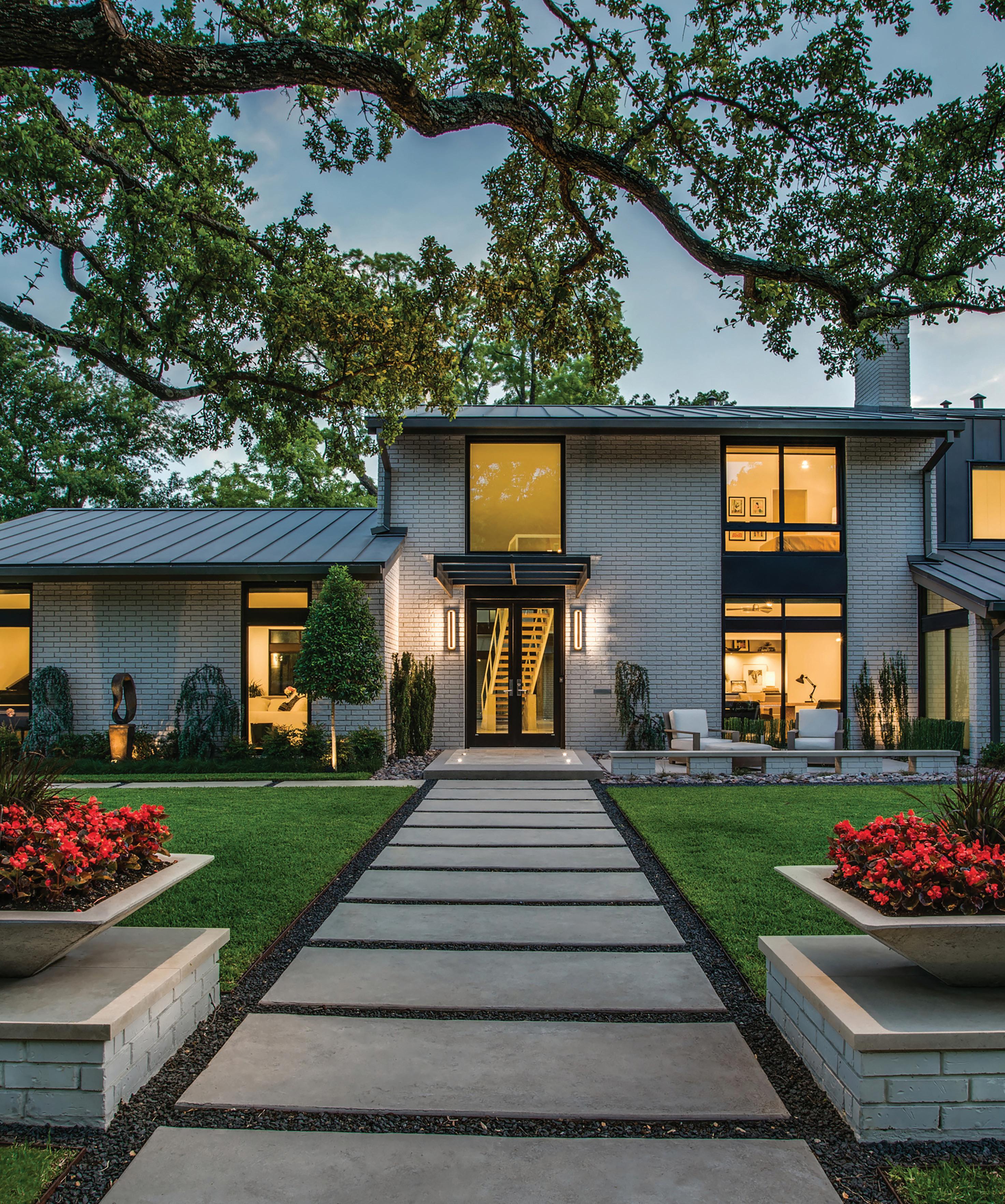


desk. And immense windows onto helicopter views of a symphony hall and opera house. Just a few floors down are an open-air swim ming pool and putting green, plus a gym, a glass-walled wine cellar and a room for facials and massages. Next door? An entire hotel — that will bring dinner to the door.
So, bye-bye, window washing and lawn care. Hello, concierge and cocktails. Here, we ask Nancy and Robbie Briggs, CEO of Briggs Freeman Sotheby’s International Realty, what life is like up in the sky, in down town Dallas, in their new digs at the 28-story HALL Arts Residences.
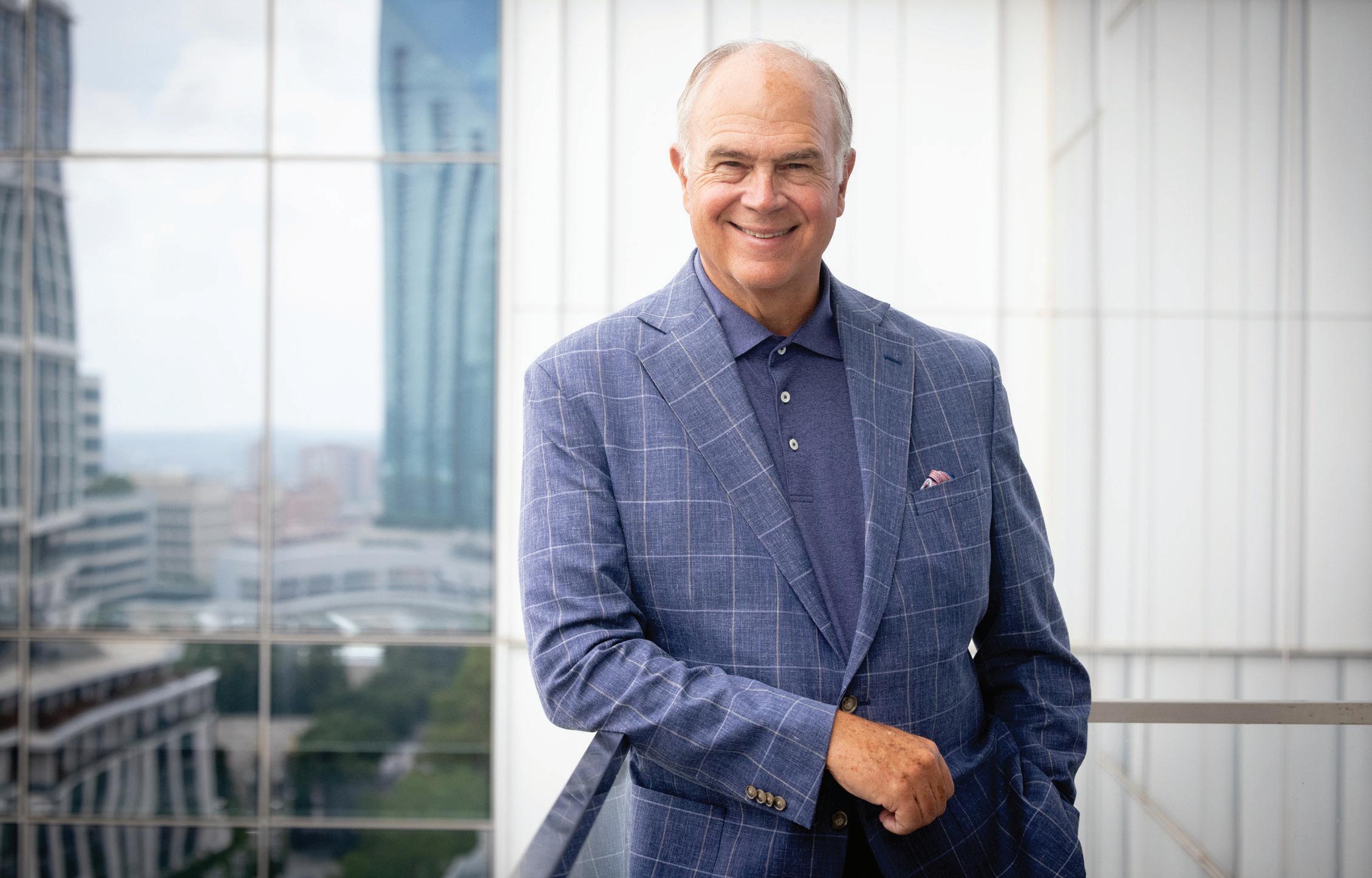 By Rob Brinkley Portrait by Allison V. Smith
By Rob Brinkley Portrait by Allison V. Smith
Fifty years ago, Robbie Briggs’ parents moved into a ground-hugging home in the wooded Bluffview area of Dallas. He had just gone off to college. Fast-forward through the years and that same house — a remodeled 1940s charmer that rambled up and down a bluff — was the scene of boister ous visits to “the grands,” Briggs calls them, by his five children. (They would dig up arrowheads and sharks’ teeth in the babbling creek below.) Ultimately, it became the emp ty-nester home of Briggs and his wife, Nancy. Fast-forward again — and up. The Briggses have just unpacked the last boxes at a new home that is the inverse of the old one. This one comes with an elevator. And a front
What drew you to HALL Arts Residences? The time was right for us to downsize. We spend a lot of time at our place in Maine, so we needed something low-maintenance and lock-and-leave. We also love this building being in the heart of the Dallas Arts District. What is your favorite building perk? We love being connected to the HALL Arts Hotel, where we often have breakfast. It makes ordinary days seem like a vacation. Which of those hotel benefits are you partaking of the most? We have hosted dinner parties of up to 24 people in our building’s Wine Room. The hotel staff sets up cocktails in our apartment and then caters the dinner downstairs. No mess, no fuss. What has been an unexpected discovery living there? Our new friends that we have made in the short time we have lived here. They are so interesting and very fun to be with. So, what’s your advice for anyone thinking of trading a house for a high-rise? It’s actually fun paring down to your favorite art and furnishings. You won’t miss the rest.
Learn more about HALL Arts Residences on pages 76 and 77.
WHY A REAL ESTATE LEGEND JUST TRADED HIS HOUSE FOR A HIGH-RISERobbie Briggs on the balcony of his new home at HALL Arts Residences



